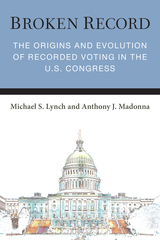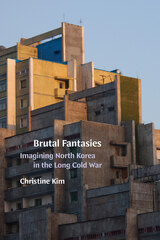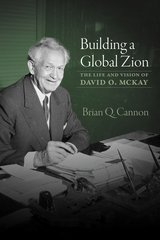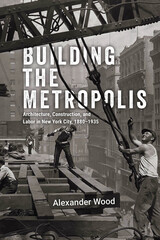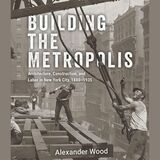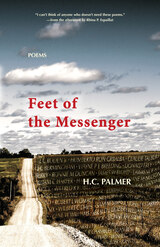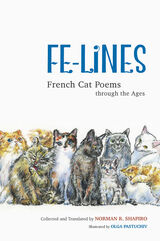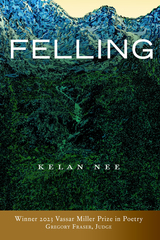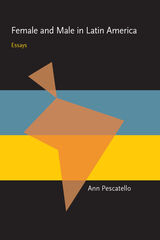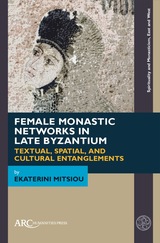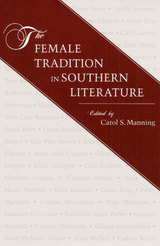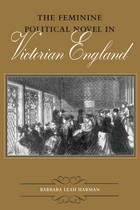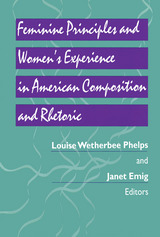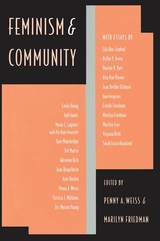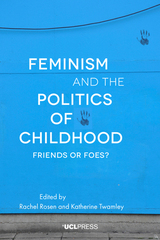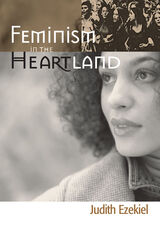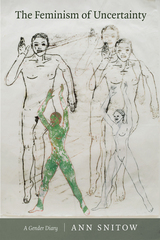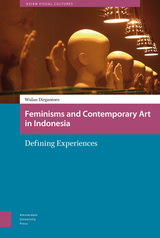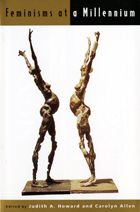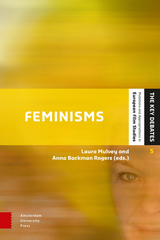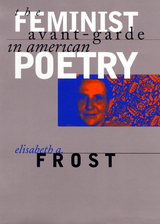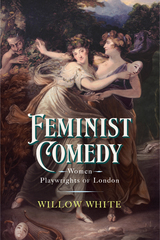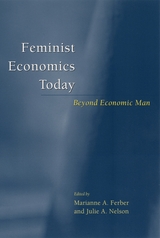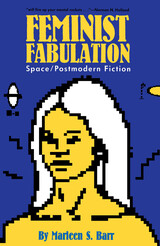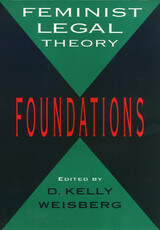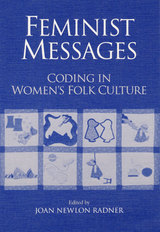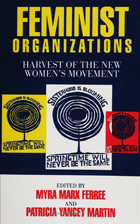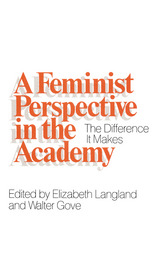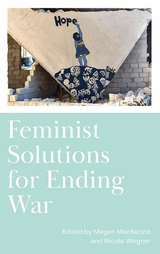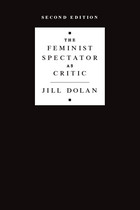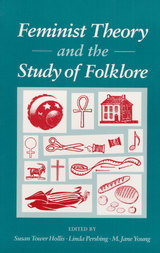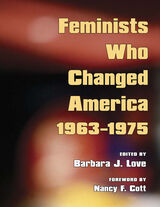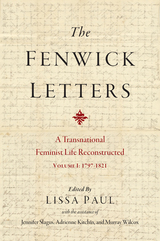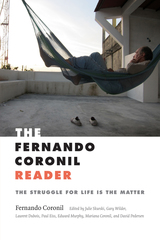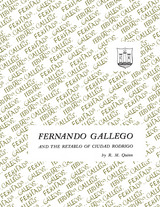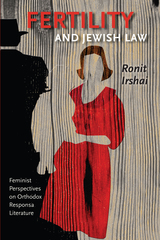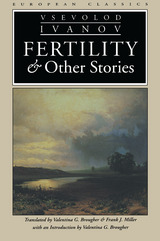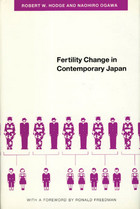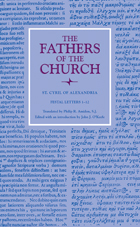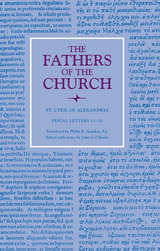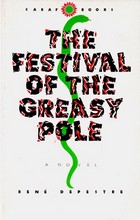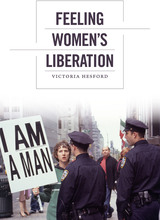 Feeling Women's Liberation
Victoria Hesford
Duke University Press, 2013 The term women's liberation remains charged and divisive decades after it first entered political and cultural discourse around 1970. In Feeling Women's Liberation, Victoria Hesford mines the archive of that highly contested era to reassess how it has been represented and remembered. Hesford refocuses debates about the movement’s history and influence. Rather than interpreting women's liberation in terms of success or failure, she approaches the movement as a range of rhetorical strategies that were used to persuade and enact a new political constituency and, ultimately, to bring a new world into being. Hesford focuses on rhetoric, tracking the production and deployment of particular phrases and figures in both the mainstream press and movement writings, including the work of Kate Millett. She charts the emergence of the feminist-as-lesbian as a persistent "image-memory" of women's liberation, and she demonstrates how the trope has obscured the complexity of the women's movement and its lasting impact on feminism.
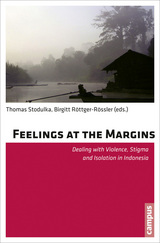 Feelings at the Margins: Dealing with Violence, Stigma and Isolation in Indonesia
Edited by Birgitt Röttger-Rössler and Thomas Stodulka
Campus Verlag, 2014
Feelings at the Margins offers a uniquely interdisciplinary take on the contemporary phenomenon of marginalization in Indonesia and its emotional impact on affected individuals and groups. By combining anthropological, political, and historical perspectives on Indonesian particularities with more universal conclusions, this volume is sure to attract not only scholars with a regional interest in the archipelago, but also researchers more broadly concerned with the interplay between stigma, marginality, culture, and emotion. Moreover, the book’s vivid ethnographic case studies—detailing recurring acts of violence against communities based on their ethnicity, gender, sexuality, descent, and religion—and discussion of significant sociocultural and political developments in early twenty-first-century Indonesia will make it a valuable resource for scholars of social and political activism.
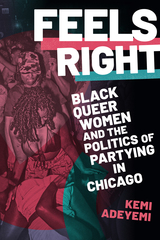 Feels Right: Black Queer Women and the Politics of Partying in Chicago
Kemi Adeyemi
Duke University Press, 2022 In Feels Right Kemi Adeyemi presents an ethnography of how black queer women in Chicago use dance to assert their physical and affective rights to the city. Adeyemi stages the book in queer dance parties in gentrifying neighborhoods, where good feelings are good business. But feeling good is elusive for black queer women whose nightlives are undercut by white people, heterosexuality, neoliberal capitalism, burnout, and other buzzkills. Adeyemi documents how black queer women respond to these conditions: how they destroy DJ booths, argue with one another, dance slowly, and stop partying altogether. Their practices complicate our expectations that life at night, on the queer dance floor, or among black queer community simply feels good. Adeyemi’s framework of “feeling right” instead offers a closer, kinesthetic look at how black queer women adroitly manage feeling itself as a complex right they should be afforded in cities that violently structure their movements and energies. What emerges in Feels Right is a sensorial portrait of the critical, black queer geographies and collectivities that emerge in social dance settings and in the broader neoliberal city.
Duke University Press Scholars of Color First Book Award recipient
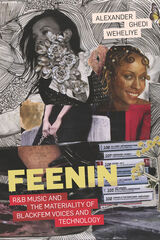 Feenin: R&B Music and the Materiality of BlackFem Voices and Technology
Alexander Ghedi Weheliye
Duke University Press, 2023 In Feenin, Alexander Ghedi Weheliye traces R&B music’s continuing centrality in Black life since the late 1970s. Focusing on various musical production and reproduction technologies such as auto-tune and the materiality of the BlackFem singing voice, Weheliye counteracts the widespread popular and scholarly narratives of the genre’s decline and death. He shows how R&B remains a thriving venue for the expression of Black thought and life and a primary archive of the contemporary moment. Among other topics, Weheliye discusses the postdisco evolution of house music in Chicago and techno in Detroit, Prince and David Bowie in relation to appropriations of Blackness and Euro-whiteness in the 1980s, how the BlackFem voice functions as a repository of Black knowledge, the methods contemporary R&B musicians use to bring attention to Black Lives Matter, and the ways vocal distortion technologies such as the vocoder demonstrate Black music’s relevance to discussions of humanism and posthumanism. Ultimately, Feenin represents Weheliye’s capacious thinking about R&B as the site through which to consider questions of Blackness, technology, history, humanity, community, diaspora, and nationhood.
Feet of the Messenger: poems
H. C. Palmer
BkMk Press, 2017 Winner, Kansas Notable Book
Balcones Poetry Prize Finalist Feet of the Messenger explores H.C. Palmer’s experiences as a medical doctor, especially as an army surgeon in the Vietnam War, and his feelings for and memories of his native Kansas, especially the Flint Hills. Although he has only been writing poetry for ten years, Palmer’s work reflects decades of discovering how the war kept coming back to him, even on the prairie.
 Fei Xiaotong and Sociology in Revolutionary China
R. David Arkush
Harvard University Press, 1981 This biographical study of one of China's leading social scientists follows his history from birth until the present moment, and includes a bibliography of his books and articles. Trained in London under Malinowski, Fei Xiaotong achieved eminence in the 1930s and 1940s for his pioneering studies of Chinese peasant life and for his popular articles, which stirred a wide audience in China to an awareness of social and political problems. A non-Marxist who came to sympathize with the Communists, Fei was gradually constrained in his activities after the Revolution until, in the 1950s, a massive propaganda campaign vilified him as a bourgeois rightist intellectual. Almost twenty years of silence and disgrace followed. Only recently, following the death of Mao, has Fei suddenly reemerged as a leader in the effort to revitalize the social sciences in China.
The story of Fei's life told here is, in a sense, the story of Westernized intellectuals in China at a time of peasant revolution. His writings enunciate the views of a sensitive observer of Chinese and Western society during that period of dramatic change.
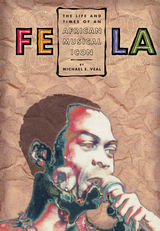 Fela: Life And Times Of An African
Michael Veal
Temple University Press, 2000 Musician, political critic, and hedonist, international superstar Fela Anikulapo-Kuti created a sensation throughout his career. In his own country of Nigeria he was simultaneously adulated and loathed, often by the same people at the same time. His outspoken political views and advocacy of marijuana smoking and sexual promiscuity offended many, even as his musical brilliance enthralled them. In his creation of afrobeat, he melded African traditions with African American and Afro-Caribbean influences to revolutionize world music.
Although harassed, beaten, and jailed by Nigerian authorities, he continued his outspoken and derisive criticism of political corruption at home and economic exploitation from abroad. A volatile mixture of personal characteristics -- charisma, musical talent, maverick lifestyle, populist ideology, and persistence in the face of persecution -- made him a legend throughout Africa and the world. Celebrated during the 1970s as a musical innovator and spokesman for the continent's oppressed masses, he enjoyed worldwide celebrity during the 1980s and was recognized in the 1990s as a major pioneer and elder statesman of African music. By the time of his death in 1997 from AIDS-related complications, Fela had become something of a Nigerian institution.
In Africa, the idea of transnational alliance, once thought to be outmoded, has gained new currency. In African America, during a period of increasing social conservatism and ethnic polarization, Africa has re-emerged as a symbol of cultural affirmation. At such an historical moment, Fela's music offers a perspective on race, class, and nation on both sides of the Atlantic. As Professor Veal demonstrates, over three decades Fela synthesized a unique musical language while also clearing -- if only temporarily -- a space for popular political dissent and a type of counter-cultural expression rarely seen in West Africa. In the midst of political turmoil in Africa, as well as renewal of pro-African cultural nationalism throughout the diaspora, Fela's political music functions as a post-colonial art form that uses cross-cultural exchange to voice a unique and powerful African essentialism.
Fe-Lines: French Cat Poems through the Ages
Collected and Translated by Norman Shapiro
University of Illinois Press, 2015 The French have long had a love affair with the cat, expressed through centuries of poetry portraying the animal's wit and wonder. Norman R. Shapiro lionizes the feline's limitless allure in this one-of-a-kind collection. Spanning centuries and styles, he draws on she-cats and toms, and an honor roll of French poets, well known and lesser known, who have served as their devoted champions. He reveals the remarkable range of French cat poems, with most works presented here for the first time in English translation. Scrupulously devoted to evoking the meaning and music of the originals, Shapiro also respects the works' formal structures. Pairing Shapiro's translations with Olga Pastuchiv's elegant illustrations, Fe-Lines guides the reader through the marvels and inscrutabilities of the Mystique féline.
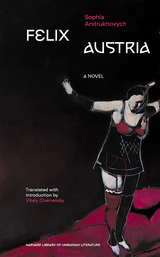 Felix Austria
Sophia Andrukhovych
Harvard University Press At the turn of the twentieth century, two young women find themselves in Stanyslaviv under Austro-Hungarian rule. Adela, the daughter of a wealthy German doctor, and Stefania, her orphan Ukrainian servant, could not be further apart socially and economically; but their fates intertwine in the cityscape of the late Habsburg Empire, densely inhabited by Ukrainians, Poles, Germans, and Jews for centuries. The intricate relationship between the two women—told by an unreliable narrator—unfolds against the backdrop of a rich ethnic, social, and cultural fabric that seems almost implausible to today’s reader who knows it to be irretrievably lost.
In Felix Austria, Sophia Andrukhovych uses techniques from Gothic literature to reconstruct with astonishing detail the atmosphere and the everyday life of Stanyslaviv. As if foreshadowing the wars to come and their devastation, the city’s population delights in earthly pleasures: extravagant dinner parties and receptions, mass celebrations, exotic theater performances, art exhibitions, glitzy shows of stars and starlets from near and far, local rituals of soap making, competition among fashionable dames, and much more. Felix Austria is a must-read for all those who seek to understand Ukraine’s deep ties with Western Europe and its struggle to break away from Russia’s orbit.
Felix Frankfurter on the Supreme Court: Extrajudicial Essays on the Court and the Constitution
Felix Frankfurter
Harvard University Press, 1970 The present volume, a selection of Frankfurter's extrajudicial nontechnical writings on the Supreme Court, its Justices, and its business, includes fifty-four pieces written between 1913 and 1956 and originally published in popular or scholarly journals. These essays serve to reinforce Frankfurter's stature as a truly just and concerned individual; and their chronological arrangement reveals the consistency of his views on the proper role of the Court.
 Felix Guattari: A Critical Introduction
Gary Genosko
Pluto Press, 2009 This is an introduction to the thought of the radical French thinker Félix Guattari. It is ideal for undergraduates and anyone studying political and cultural theory.
Guattari's main works were published in the 1970s and 1980s. His background was in psychoanalysis -- he was trained by Lacan and he practised as a psychoanalyst for much of his life. He developed a distinctive psychoanalytic method informed always by his revolutionary politics.
Guattari was actively involved in numerous political movements, from Trotskyism to Autonomism, tackling ecological and sexual politics along the way. A true believer in collectivity, much of his work was written in collaboration, most famously with Gilles Deleuze, with whom he wrote the hugely influential books Anti-Oedipus and A Thousand Plateaus. He also wrote with Antonio Negri and others.
This accessible introduction explores his highly original ideas -- including his ground-breaking conception of 'transversal politics' -- and the impact his concern with subjectivity had on wider political theory.
 Felix Longoria's Wake: Bereavement, Racism, and the Rise of Mexican American Activism
By Patrick Carroll
University of Texas Press, 2003 Winner, Tullis Prize, Texas State Historical Association, 2004 Private First Class Felix Longoria earned a Bronze Service Star, a Purple Heart, a Good Conduct Medal, and a Combat Infantryman's badge for service in the Philippines during World War II. Yet the only funeral parlor in his hometown of Three Rivers, Texas, refused to hold a wake for the slain soldier because "the whites would not like it." Almost overnight, this act of discrimination became a defining moment in the rise of Mexican American activism. It launched Dr. Héctor P. García and his newly formed American G.I. Forum into the vanguard of the Mexican civil rights movement, while simultaneously endangering and advancing the career of Senator Lyndon B. Johnson, who arranged for Longoria's burial with full military honors in Arlington National Cemetery. In this book, Patrick Carroll provides the first fully researched account of the Longoria controversy and its far-reaching consequences. Drawing on extensive documentary evidence and interviews with many key figures, including Dr. García and Mrs. Longoria, Carroll convincingly explains why the Longoria incident, though less severe than other acts of discrimination against Mexican Americans, ignited the activism of a whole range of interest groups from Argentina to Minneapolis. By putting Longoria's wake in a national and international context, he also clarifies why it became such a flash point for conflicting understandings of bereavement, nationalism, reason, and emotion between two powerful cultures—Mexicanidad and Americanism.
Felling
Kelan Nee
University of North Texas Press, 2024
 Fellini
Sam Stourdzé
Amsterdam University Press, 2014 The career of Federico Fellini lasted for forty years and made him perhaps the most illustrious of all the filmmakers to have come out of Italy. Those forty years saw the appearance of titles that have carved out a permanent niche in the memory of generations of film lovers. Fellini, a richly illustrated book written and edited by Sam Stourdzé, Director of the Musée de l'Elysée in Lausanne (Switzerland), taps into the sources of his fertile imagination and brings the vital power of his work into the limelight providing insight into the obsessions and motivations of the man behind La Strada, La Dolce Vita and 8¿.
This book and the exhibition aim to reveal the universe of the filmmaker and the sources of his rich imagination, and to highlight the essential power of his work. The story of Fellini’s themes and obsessions is, twenty years after his death, told by movie stills, set photos and his drawings, as well as by archive material and posters.
The fantasy world of Cinecittà, the studio where Fellini made so many of his films, is revealed through previously unseen behind-the-scenes pictures that were taken by photographers such as Gideon Bachmann, Deborah Beer, Pierluigi Praturlon and Paul Ronald.
The publication includes four main chapters. Popular Culture concentrates on Fellini’s many sources of inspiration within the day-to-day popular culture of the time. This includes not only the steadily more prevalent mass media, but also such manifestations as the circus, rock music, cartoons and Catholic or political parades. Fellini at Work shows us the director on the film set, instructing his actors, working together with costume designers, behind the camera, and so on. The City of Women concerns Fellini’s most important subject and obsession: Woman, in all her many guises. Finally, Biographical Imagination presents Fellini in the guise of various doppelgangers, each reflecting a different aspect of his personality. Particular attention is given to his ‘Book of Dreams’ in which he recorded his dreams in words and drawings.
 Fellini's Films and Commercials: From Postwar to Postmodern
Frank Burke
Intellect Books, 2020 Federico Fellini’s distinct style delighted generations of film viewers and inspired filmmakers and artists around the world. In Fellini’s Films and Commercials, renowned Fellini scholar Frank Burke presents a film-by-film analysis of the famed director’s cinematic output from a theoretical perspective. He explores Fellini’s movement from relatively classic filmmaking to modernist reflexivity, and then to “postmodern reproduction.” Burke moves from analysis of stories told from a relatively “objective” standpoint, to increased concentration on Fellini-as-author and on the cinematic apparatus, to Fellini’s dismantling of authorship and the cinematic apparatus, to his postmodern signifying strategies. Grounded in poststructuralist approaches to texts and signification, Burke shows that Fellini is profoundly readable, if extremely complex.
Revisiting Burke’s 1996 monograph, this revised and updated edition includes a new preface and an additional chapter on the filmmaker’s work on commercials. Elegantly written and thoroughly researched, this book is essential reading for any Fellini fan or scholar.
The Fellowship of Life: Virtue Ethics and Orthodox Christianity
Joseph Woodill
Georgetown University Press Bringing Orthodox Christianity into the recent dialog on virtue ethics, Joseph Woodill investigates the correspondences between the Eastern Orthodox tradition and contemporary virtue ethics, and he develops a distinctly Orthodox vision of theological ethics. This book fills a vacuum in our understanding of the Eastern Church by revealing themes, persons, and insights that offer resources for a contemporary moral theology. Reviewing the Eastern tradition from patristic times to the present, Woodill shows its relevance to contemporary virtue ethics and identifies both differences and similarities between Orthodox and other—Catholic, Protestant, and Jewish—virtue ethics.
 Felon for Peace: The Memoir of a Vietnam-Era Draft Resister
Jerry Elmer
Vanderbilt University Press, 2005 When Jerry Elmer turned eighteen at the height of the Vietnam War, he publicly refused to register for the draft, a felony then and now. Later he burglarized the offices of fourteen draft boards in three cities, destroying the files of men eligible to be drafted. After working almost twenty years in the peace movement, he attended law school, where he was the only convicted felon in Harvard's class of 1990.
This book is a blend of personal memoir, contemporary history, and astute political analysis. Elmer draws on a variety of sources, including never-before-released FBI files, and argues passionately for the practice of nonviolence. He describes the range of actions he took—from draft card burning to organizing draft board raids with Father Phil Berrigan; from vigils on the Capitol steps inside "tiger cages" used to torture Vietnamese political prisoners to jail time for protesting nuclear power plants; from a tour of the killing fields of Cambodia to meetings with Corazon Aquino in the Philippines.
A Vietnamese-language edition of Felon for Peace has also been published.
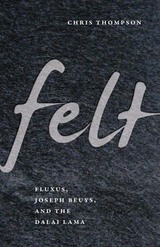 Felt: Fluxus, Joseph Beuys, and the Dalai Lama
Chris Thompson
University of Minnesota Press, 2010 Felt provides a nonlinear look at the engagement of the postwar avant-garde with Eastern spirituality, a context in which the German artist Joseph Beuys appears as an uneasy shaman. Centered on a highly publicized yet famously inconclusive 1982 meeting between Beuys and the Dalai Lama, arranged by the Dutch artist Louwrien Wijers, Chris Thompson explores the interconnections among Beuys, the Fluxus movement, and Eastern philosophy and spiritual practice.
Building from the resonance of felt, the fabric, in both Tibetan culture and in Beuys’s art, Thompson takes as his point of departure Deleuze and Guattari’s discussion in A Thousand Plateaus of felt as smooth space that is “in principle infinite, open, and unlimited in every direction,” its structure determined by chance as opposed to the planned, woven nature of most fabrics. Felt is thus seen as an alternative to the model of the network: felt’s anarchic form is not reducible to the regularity of the net, grid, or mesh, and the more it is pulled, tweaked, torn, and agitated, the greater its structural integrity.
Felt thus invents its methodology from the material that represents its object of inquiry and from this advances a reading of the avant-garde. At the same time, Thompson demonstrates that it is sometimes the failures of thought, the disappointing meetings, even the untimely deaths that open portals through which life flows into art and allows new conjunctions of life, art, and thought. Thompson explores both the well-known engagement of Fluxus artists with Eastern spirituality and the more elusive nature of Beuys’s own late interest in Tibetan culture, arriving at a sense of how such noncausal interactions—interhuman intrigue—create culture and shape contemporary art history.
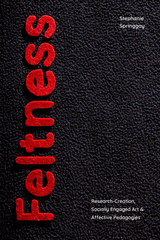 Feltness: Research-Creation, Socially Engaged Art, and Affective Pedagogies
Stephanie Springgay
Duke University Press, 2022 Stephanie Springgay’s concept of feltness—which emerges from affect theory, queer and feminist theory, and feminist conceptions of more-than-human entanglements—is a set of intimate practices of creating art based on touch, affect, relationality, love, and responsibility. In this book, she explores how feltness is a radical pedagogy that can be practiced with diverse publics, including children, who are often left out of conversations about who can learn in radical ways. Springgay examines the results of a decade-long project in which researchers, artists, students, and teachers participated in events in North American elementary, secondary, and postsecondary institutions. In projects that ranged from children learning to be critics and artists to university students experimenting with building “a public” through art, participants blended participatory art creation with academic research to address social justice issues. Springgay shows how feltness can redefine who is imagined to be capable of complex feeling, experiential learning, embodied practice, social engagement, and intimate care. In this way, feltness fosters learning that disrupts and defamiliarizes schools and institutions, knowledge systems, values, and the legibility of art and research.
Female and Male in Latin America
Ann M. Pescatello
University of Pittsburgh Press, 1979 A pioneering study of Latin American women that views contemporary perceptions and realities of women’s lives, women’s roles in modernization versus tradition, the conflicts of class struggles among women, and the future of women's participation in Cuban society.
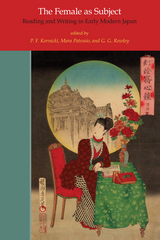 The Female as Subject: Reading and Writing in Early Modern Japan
P. F. Kornicki, Mara Patessio, and G. G. Rowley, Editors
University of Michigan Press, 2010 The Female as Subject presents 11 essays by an international group of scholars from Europe, Japan, and North America examining what women of different social classes read, what books were produced specifically for women, and the genres in which women themselves chose to write. The authors explore the different types of education women obtained and the levels of literacy they achieved, and they uncover women’s participation in the production of books, magazines, and speeches. The resulting depiction of women as readers and writers is also enhanced by thirty black-and-white illustrations. For too long, women have been largely absent from accounts of cultural production in early modern Japan. By foregrounding women, the essays in this book enable us to rethink what we know about Japanese society during these centuries. The result is a new history of women as readers, writers, and culturally active agents. The Female as Subject is essential reading for all students and teachers of Japan during the Edo and Meiji periods. It also provides valuable comparative data for scholars of the history of literacy and the book in East Asia.
 The Female Autograph: Theory and Practice of Autobiography from the Tenth to the Twentieth Century
Edited by Domna C. Stanton
University of Chicago Press, 1987 These original essays comprise a fascinating investigation into women's strategies for writing the self—constructing the female subject through autobiography, memoirs, letters, and diaries. The collection contains theoretical essays by Donna Stanton, Sandra Gilbert, and Susan Gilbert, and Susan Gubar; chapters on specific issues raised by women's autographs, such as Richard Bowring's study of tenth-century Japanese diaries or Janel Mueller's on The Book of Margery Kempe; and annotated autobiographical fragments, including texts by Julia Kristeva, by a woman who became a czarist cavalry officer, and by a contemporary Palestinian poet. There are also chapters on the seventeenth-century painter Artemisia Gentileschi; Mme de. Sévigné; Mendelssohn's sister, Fanny Hensel; the black minister Jarena Lee; Virginia Woolf; and Eva Peron. The result is a "conversation" between writers and critics across cultural and temporal boundaries. Stanton's essay plays off Virginia Woolf's A Room of One's Own. Kristeva begins with a reading of de Beauvoir, while a self-published French woman writes to defend the joys of family life against the author of Memoirs of a Dutiful Daughter.
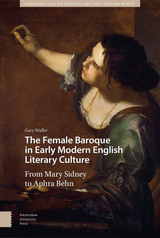 The Female Baroque in Early Modern English Literary Culture: From Mary Sidney to Aphra Behn
Gary Waller
Amsterdam University Press, 2020 The Female Baroque in Early Modern English Literary Culture is a contribution to the revival of early modern women’s writings and cultural production in English that began in the 1980s. Its originality is twofold: it links women’s writing in English with the wider context of Baroque culture, and it introduces the issue of gender into discussion of the Baroque. The title comes from Julia Kristeva’s study of Teresa of Avila, that ‘the secrets of Baroque civilization are female’. The book is built on a schema of recurring Baroque characteristics — narrativity, hyperbole, melancholia, kitsch, and plateauing, pointing less to surface manifestations and more to underlying ideological tensions. The crucial concept of the book is developed in detail. Particular attention is given to Gertrude More, Mary Ward, Aemilia Lanyer, The Ferrar/Collet women, Mary Wroth, the Cavendish sisters, Hester Pulter, Anne Hutchinson, and finally Margaret Cavendish and Aphra Behn, whose lives and writings point to the developing cultural transition to the Enlightenment.
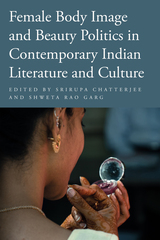 Female Body Image and Beauty Politics in Contemporary Indian Literature and Culture
Edited by Srirupa Chatterjee and Shweta Rao Garg
Temple University Press, 2024 Female Body Image and Beauty Politics in Contemporary Indian Literature and Culture is the first volume to analyze the myriad conceptualizations of South Asian women’s body issues in film, literature, advertising, and other media. Showing how body image and self-identity are constructed in contemporary neoliberal India, the editors and contributors theorize issues of body image vis-à-vis Indian womanhood while touching upon political, socio-economic, and cultural parameters.
Influences from the colonial period through the age of the internet and globalization have reinforced Eurocentric ideals about femininity and womanhood. This long overdue volume addresses the pressures of beautification that Indian women face as they struggle with body acceptance and are often denied pride in their natural bodies.
Contributors: Annika Taneja, Anurima Chanda, Aratrika Bose, Kavita Daiya, Ketaki Chowkhani, Nishat Haider, Samrita Sinha, Shailendra Kumar Singh, Shubhra Ray, Sucharita Sarkar, Sukshma Vedere, Swatie, Tanupriya, Turni Chakrabarti, and the editors.
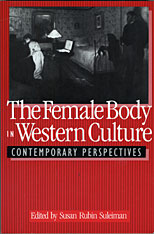 The Female Body in Western Culture: Contemporary Perspectives
Susan Rubin Suleiman
Harvard University Press, 1986 The female body has occupied a central place in the Western imagination, its images pervading poetry and story, mythology and religious doctrine, the visual arts, and scientific treatises. It has inspired both attraction and fear, been perceived as beautiful and unclean, alluring and dangerous, a source of pleasure and nurturing but also a source of evil and destruction.
In The Female Body in Western Culture, twenty-three internationally noted scholars and critics, in specially commissioned essays, explore these representations and their consequences for contemporary art and culture. Ranging from Genesis to Gertrude Stein and Angela Carter, from ancient Greek ritual to the Victorian sleeping cure, from images of the Madonna to modern film and Surrealist art, the essays cover a wide spectrum of approaches and subject mailer. They all converge, however, around questions of power and powerlessness, voice and silence, subjecthood and objectification. And they point the way to the new possibilities and displacements of traditional male-female oppositions. Androgyny in a new key? This book demonstrates that a blurring of gender boundaries does not have to deny difference.
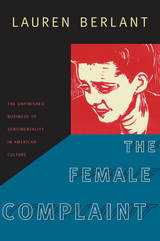 The Female Complaint: The Unfinished Business of Sentimentality in American Culture
Lauren Berlant
Duke University Press, 2008 The Female Complaint is part of Lauren Berlant’s groundbreaking “national sentimentality” project charting the emergence of the U.S. political sphere as an affective space of attachment and identification. In this book, Berlant chronicles the origins and conventions of the first mass-cultural “intimate public” in the United States, a “women’s culture” distinguished by a view that women inevitably have something in common and are in need of a conversation that feels intimate and revelatory. As Berlant explains, “women’s” books, films, and television shows enact a fantasy that a woman’s life is not just her own, but an experience understood by other women, no matter how dissimilar they are. The commodified genres of intimacy, such as “chick lit,” circulate among strangers, enabling insider self-help talk to flourish in an intimate public. Sentimentality and complaint are central to this commercial convention of critique; their relation to the political realm is ambivalent, as politics seems both to threaten sentimental values and to provide certain opportunities for their extension. Pairing literary criticism and historical analysis, Berlant explores the territory of this intimate public sphere through close readings of U.S. women’s literary works and their stage and film adaptations. Her interpretation of Uncle Tom’s Cabin and its literary descendants reaches from Harriet Beecher Stowe to Toni Morrison’s Beloved, touching on Shirley Temple, James Baldwin, and The Bridges of Madison County along the way. Berlant illuminates different permutations of the women’s intimate public through her readings of Edna Ferber’s Show Boat; Fannie Hurst’s Imitation of Life; Olive Higgins Prouty’s feminist melodrama Now, Voyager; Dorothy Parker’s poetry, prose, and Academy Award–winning screenplay for A Star Is Born; the Fay Weldon novel and Roseanne Barr film The Life and Loves of a She-Devil; and the queer, avant-garde film Showboat 1988–The Remake. The Female Complaint is a major contribution from a leading Americanist.
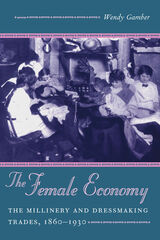 The Female Economy: The Millinery and Dressmaking Trades, 1860-1930
Wendy Gamber
University of Illinois Press, 1997 Hemmed in by "women's work" much less than has been thought, women in the late 1800s and early 1900s were the primary entrepreneurs in the millinery and dressmaking trades. The Female Economy explores that lost world of women's dominance, showing how independent, often ambitious businesswomen and the sometimes imperious consumers they served gradually vanished from the scene as custom production gave way to a largely unskilled modern garment industry controlled by men. Wendy Gamber helps overturn the portrait of wage-earning women as docile souls who would find fulfillment only in marriage and motherhood. She combines labor history, women's history, business history, and the history of technology while exploring topics as wide-ranging as the history of pattern-making and the relationship between entrepreneurship and marriage. A volume in the series The Working Class in American History, edited by David Brody, Alice Kessler-Harris, David Montgomery, and Sean Wilentz, and in the series Women in American History, edited by Anne Firor Scott, Nancy A. Hewitt, and Stephanie Shaw
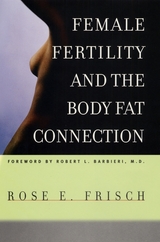 Female Fertility and the Body Fat Connection
Rose E. Frisch
University of Chicago Press, 2002 Are girls entering puberty earlier than they used to? This question, which has been debated recently by doctors and scientists in the pages of Time magazine and the New York Times, proves that there is still a great deal to learn about women's reproductive health. Female Fertility and the Body-Fat Connection is the record of one scientist's groundbreaking and decades-long work on the connections among fertility, body fat, and reproductive health in women.
Rose E. Frisch explains here how, in women, a certain amount of body fat is crucial to the reproductive system and sexual maturation. Women who are too lean are infertile and cannot conceive children; young girls who are too thin have a delayed onset of their first period. Female Fertility and the Body-Fat Connection illuminates how and why a "critical fitness" level underlies a woman's reproductive health. In the process Frisch gives readers a comprehensive view of the research done to date on the relationship between body composition and fertility and also describes her own journey as a woman scientist working to advance her critical-fitness hypothesis both to the general public and the scientific community. Frisch answers the questions every woman has about the desirable weight for health and fertility and even includes tables to help women find their own best weight. She also demonstrates how important diet and exercise are for the long-term reproductive health of women, and shows what factors influence the onset of puberty in girls.
Each milestone of the reproductive life span is affected by food intake and energy output, the factors affecting the storage of fat. Female Fertility and the Body-Fat Connection is a cornerstone to understanding the health of girls and women.
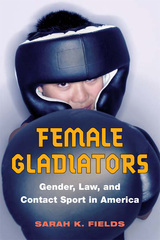 Female Gladiators: Gender, Law, and Contact Sport in America
Sarah K. Fields
University of Illinois Press, 2004 Female Gladiators is the first book to examine legal and social battles over the right of women to participate with men in contact sports. The impetus to begin legal proceedings was the 1972 enactment of Title IX, which prohibited discrimination in educational settings, but it was the Equal Protection Clause of the U.S. Constitution and the equal rights amendments of state constitutions that ultimately opened doors. Despite court rulings, however, many in American society resisted—and continue to resist—allowing girls in dugouts and other spaces traditionally defined as male territories. Inspired, women and girls began to demand access to the contact sports which society had previously deemed too strenuous or violent for them to play. When the leagues continued to bar girls simply because they were not boys, the girls went to court. Sarah K. Fields's Female Gladiators is the only book to examine the legal and social battles over gender and contact sport that continue to rage today.
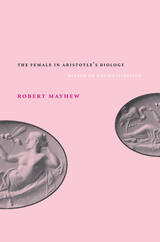 The Female in Aristotle's Biology: Reason or Rationalization
Robert Mayhew
University of Chicago Press, 2004 While Aristotle's writings on biology are considered to be among his best, the comments he makes about females in these works are widely regarded as the nadir of his philosophical oeuvre. Among many claims, Aristotle is said to have declared that females contribute nothing substantial to generation; that they have fewer teeth than males; that they are less spirited than males; and that woman are analogous to eunuchs. In The Female in Aristotle's Biology, Robert Mayhew aims not to defend Aristotle's ideas about females but to defend Aristotle against the common charge that his writings on female species were motivated by ideological bias.
Mayhew points out that the tools of modern science and scientific experimentation were not available to the Greeks during Aristotle's time and that, consequently, Aristotle had relied not only on empirical observations when writing about living organisms but also on a fair amount of speculation. Further, he argues that Aristotle's remarks about females in his biological writings did not tend to promote the inferior status of ancient Greek women.
Written with passion and precision, The Female in Aristotle's Biology will be of enormous value to students of philosophy, the history of science, and classical literature.
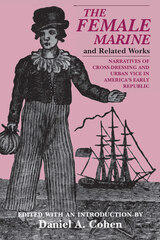 "The Female Marine" and Related Works: Narratives of Cross-Dressing and Urban Vice in America's Early Republic
Daniel A. Cohen
University of Massachusetts Press, 1997 This is the first complete modern edition of The Female Marine, a fictional cross-dressing trilogy originally published between 1815 and 1818. Enormously popular among New England readers, the tale in various versions appeared in no fewer than nineteen editions over that brief four-year span. This new edition appends three other contemporary accounts of cross-dressing and urban vice which, together with The Female Marine, provide a unique portrayal of prostitution and interracial city life in early-nineteenth-century America.
The alternately racy and moralistic narrative recounts the adventures of a young woman from rural Massachusetts who is seduced by a false-hearted lover, flees to Boston, and is entrapped in a brothel. She eventually escapes by disguising herself as a man and serves with distinction on board the U.S. frigate Constitution during the War of 1812. After subsequent onshore adventures in and out of male dress, she is happily married to a wealthy New York gentleman.
In his introduction, Daniel A. Cohen situates the story in both its literary and historical contexts. He explains how the tale draws upon a number of popular Anglo-American literary genres, including the female warrior narrative, the sentimental novel, and the urban exposé. He then explores how The Female Marine reflects early-nineteenth-century anxieties concerning changing gender norms, the expansion of urban prostitution, the growth of Boston's African American community, and feelings of guilt aroused by New England's notoriously unpatriotic activities during the War of 1812.
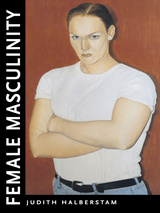 Female Masculinity
Jack Halberstam
Duke University Press, 1998 Masculinity without men. In Female Masculinity Judith Halberstam takes aim at the protected status of male masculinity and shows that female masculinity has offered a distinct alternative to it for well over two hundred years. Providing the first full-length study on this subject, Halberstam catalogs the diversity of gender expressions among masculine women from nineteenth-century pre-lesbian practices to contemporary drag king performances. Through detailed textual readings as well as empirical research, Halberstam uncovers a hidden history of female masculinities while arguing for a more nuanced understanding of gender categories that would incorporate rather than pathologize them. She rereads Anne Lister’s diaries and Radclyffe Hall’s The Well of Loneliness as foundational assertions of female masculine identity. She considers the enigma of the stone butch and the politics surrounding butch/femme roles within lesbian communities. She also explores issues of transsexuality among “transgender dykes”—lesbians who pass as men—and female-to-male transsexuals who may find the label of “lesbian” a temporary refuge. Halberstam also tackles such topics as women and boxing, butches in Hollywood and independent cinema, and the phenomenon of male impersonators. Female Masculinity signals a new understanding of masculine behaviors and identities, and a new direction in interdisciplinary queer scholarship. Illustrated with nearly forty photographs, including portraits, film stills, and drag king performance shots, this book provides an extensive record of the wide range of female masculinities. And as Halberstam clearly demonstrates, female masculinity is not some bad imitation of virility, but a lively and dramatic staging of hybrid and minority genders.
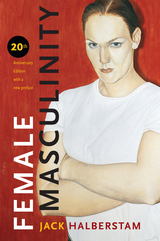 Female Masculinity
Jack Halberstam
Duke University Press, 1998 In this quintessential work of queer theory, Jack Halberstam takes aim at the protected status of male masculinity and shows that female masculinity has offered a distinct alternative to it for well over two centuries. Demonstrating how female masculinity is not some bad imitation of virility, but a lively and dramatic staging of hybrid and minority genders, Halberstam catalogs the diversity of gender expressions among masculine women from nineteenth-century pre-lesbian practices to contemporary drag king performances.
Through detailed textual readings as well as empirical research, Halberstam uncovers a hidden history of female masculinities while arguing for a more nuanced understanding of gender categories that would incorporate rather than pathologize them. He rereads Anne Lister's diaries and Radclyffe Hall's The Well of Loneliness as foundational assertions of female masculine identity; considers the enigma of the stone butch and the politics surrounding butch/femme roles within lesbian communities; and explores issues of transsexuality among “transgender dykes”—lesbians who pass as men—and female-to-male transsexuals who may find the label of “lesbian” a temporary refuge. Halberstam also tackles such topics as women and boxing, butches in Hollywood and independent cinema, and the phenomenon of male impersonators.
Featuring a new preface by the author, this twentieth anniversary edition of Female Masculinity remains as insightful, timely, and necessary as ever.
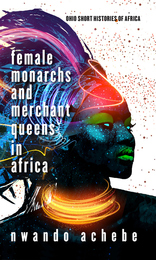 Female Monarchs and Merchant Queens in Africa
Nwando Achebe
Ohio University Press, 2020 An unapologetically African-centered monograph that reveals physical and spiritual forms and systems of female power and leadership in African cultures. Nwando Achebe’s unparalleled study documents elite females, female principles, and female spiritual entities across the African continent, from the ancient past to the present. Achebe breaks from Western perspectives, research methods, and their consequently incomplete, skewed accounts, to demonstrate the critical importance of distinctly African source materials and world views to any comprehensible African history. This means accounting for the two realities of African cosmology: the physical world of humans and the invisible realm of spiritual gods and forces. That interconnected universe allows biological men and women to become female-gendered males and male-gendered females. This phenomenon empowers the existence of particular African beings, such as female husbands, male priestesses, female kings, and female pharaohs. Achebe portrays their combined power, influence, and authority in a sweeping, African-centric narrative that leads to an analogous consideration of contemporary African women as heads of state, government officials, religious leaders, and prominent entrepreneurs.
Female Monastic Networks in Late Byzantium: Textual, Spatial, and Cultural Entanglements
Ekaterini Mitsiou
Arc Humanities Press, 2025 This book offers the first analysis of female monasticism across the last three centuries of the Byzantine empire using Social Network Analysis (SNA). The present study analyzes and reconstructs the networks of Byzantine female monasteries as well as the geographical and spatial dimensions of monastic life, art, and literary production. Moreover, it reconstructs and represents the networks of specific female monastic individuals, female involvement in ecclesiastical controversies, and the complexity of patronage.
 Female Performance and Spectatorship in a Medieval Nunnery: The "Elevatio" and "Visitatio sepulchri" of Barking Abbey in Practice
Aurélie Blanc
Arc Humanities Press, 2024 Medieval women were active in many performative activities, including plays and ceremonies performed in nunneries. This volume focuses on monastic performances and, in particular, on performances given in the English abbey of Barking. The Barking ceremonies, commonly referred to as the Elevatio and Visitatio sepulchri, display complex ties with both drama and liturgy. The book uses historical and archaeological evidence to propose a discussion of the nuns’ participation in these ceremonies—as performers, but also as scribes, composers, and patrons—and of the Elevatio and Visitatio’s potential effects on their performers and spectators. It goes on to address related questions through the lens of a modern performance of the ceremonies, considering their relevance today. Discussion is presented within the context of a general overview of female performance in the Middle Ages.
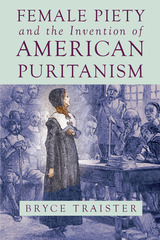 Female Piety and the Invention of American Puritanism
Bryce Traister
Ohio State University Press, 2016 Female Piety and the Invention of American Puritanism reconsiders the standard critical view that women’s religious experiences were either silent consent or hostile response to mainstream Puritan institutions. In this groundbreaking new approach to American Puritanism, Bryce Traister asks how gendered understandings of authentic religious experience contributed to the development of seventeenth-century religious culture and to the “post-religious” historiography of Puritanism in secular modernity. He argues that women were neither marginal nor hostile to the theological and cultural ambitions of seventeenth-century New England religious culture and, indeed, that radicalized female piety was in certain key respects the driving force of New England Puritan culture.
Uncovering the feminine interiority of New England Protestantism, Female Piety and the Invention of American Puritanism positions itself against prevalent historical arguments about the rise of secularism in the modern West. Traister demonstrates that female spirituality became a principal vehicle through which Puritan identity became both absorbed within and foundational for pre-national secular culture. Engaging broadly with debates about religion and secularization, national origins and transnational unsettlements, and gender and cultural authority, this is a foundational reconsideration both of American Puritanism itself and of “American Puritanism” as it has been understood in relation to secular modernity.
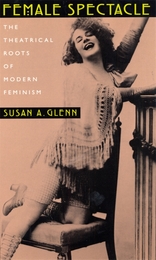 Female Spectacle: The Theatrical Roots of Modern Feminism
Susan A. Glenn
Harvard University Press, 2000 When the French actress Sarah Bernhardt made her first American tour in 1880, the term "feminism" had not yet entered our national vocabulary. But over the course of the next half-century, a rising generation of daring actresses and comics brought a new kind of woman to center stage. Exploring and exploiting modern fantasies and fears about female roles and gender identity, these performers eschewed theatrical convention and traditional notions of womanly modesty. They created powerful images of themselves as ambitious, independent, and sexually expressive "New Women."
Female Spectacle reveals the theater to have been a powerful new source of cultural authority and visibility for women. Ironically, theater also provided an arena in which producers and audiences projected the uncertainties and hostilities that accompanied changing gender relations. From Bernhardt's modern methods of self-promotion to Emma Goldman's political theatrics, from the female mimics and Salome dancers to the upwardly striving chorus girl, Glenn shows us how and why theater mattered to women and argues for its pivotal role in the emergence of modern feminism.
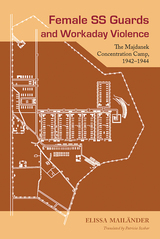 Female SS Guards and Workaday Violence: The Majdanek Concentration Camp, 1942-1944
Elissa Mailänder
Michigan State University Press, 2015 How did “ordinary women,” like their male counterparts, become capable of brutal violence during the Holocaust? Cultural historian Elissa Mailänder examines the daily work of twenty-eight women employed by the SS to oversee prisoners in the concentration and death camp Majdanek/Lublin in Poland. Many female SS overseers in Majdanek perpetrated violence and terrorized prisoners not only when ordered to do so but also on their own initiative. The social order of the concentration camp, combined with individual propensities, shaped a microcosm in which violence became endemic to workaday life. The author’s analysis of Nazi records, court testimony, memoirs, and film interviews illuminates the guards’ social backgrounds, careers, and motives as well as their day-to-day behavior during free time and on the “job,” as they supervised prisoners on work detail and in the cell blocks, conducted roll calls, and “selected” girls and women for death in the gas chambers. Scrutinizing interactions and conflicts among female guards, relations with male colleagues and superiors, and internal hierarchies, Female SS Guards and Workaday Violence shows how work routines, pressure to “resolve problems,” material gratification, and Nazi propaganda stressing guards’ roles in “creating a new order” heightened female overseers’ identification with Nazi policies and radicalized their behavior.
FEMALE TRADITION IN SOUTHERN LITERATURE
Carol S. Manning
University of Illinois Press, 1993 Cuts a feminist swath through orthodox readings of southern literature. "Distinguished. . . . These
essays reclaim women's traditions which have been neglected by critics who ought to have known
better." -- Kathryn Lee Seidel, author of The Southern Belle in the American Novel
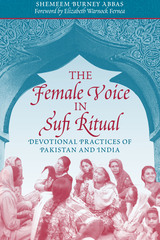 The Female Voice in Sufi Ritual: Devotional Practices of Pakistan and India
By Shemeem Burney Abbas
University of Texas Press, 2002 The female voice plays a more central role in Sufi ritual, especially in the singing of devotional poetry, than in almost any other area of Muslim culture. Female singers perform sufiana-kalam, or mystical poetry, at Sufi shrines and in concerts, folk festivals, and domestic life, while male singers assume the female voice when singing the myths of heroines in qawwali and sufiana-kalam. Yet, despite the centrality of the female voice in Sufi practice throughout South Asia and the Middle East, it has received little scholarly attention and is largely unknown in the West. This book presents the first in-depth study of the female voice in Sufi practice in the subcontinent of Pakistan and India. Shemeem Burney Abbas investigates the rituals at the Sufi shrines and looks at women's participation in them, as well as male performers' use of the female voice. The strengths of the book are her use of interviews with both prominent and grassroots female and male musicians and her transliteration of audio- and videotaped performances. Through them, she draws vital connections between oral culture and the written Sufi poetry that the musicians sing for their audiences. This research clarifies why the female voice is so important in Sufi practice and underscores the many contributions of women to Sufism and its rituals.
 Femenist Ethics and Natural Law: The End of Anathema
Cristina L. H. Traina
Georgetown University Press, 1999 Heated debates over such issues as abortion, contraception, ordination, and Church hierarchy suggest that feminist and natural law ethics are diametrically opposed. Cristina L.H. Traina now reexamines both Roman Catholic natural law tradition and Anglo-American feminist ethics and reconciles the two positions by showing how some of their aims and assumptions complement one another. After carefully scrutinizing Aquinas’s moral theology, she analyzes trends in both contemporary feminist ethics, theological as well as secular, and twentieth-century Roman Catholic moral theology. Although feminist ethics reject many of the methods and conclusions of the scholastic and revisionist natural law schools, Traina shows that a truly Thomistic natural law ethic nonetheless provides a much-needed holistic foundation for contemporary feminist ethics. On the other hand, she offers new perspectives on the writings of Josef Fuchs, Richard McCormick, and Gustavo Gutierrez, arguing that their failure to catch the full spirit of Thomas’s moral vision is due to inadequate attention to feminist critical methods. This highly original book proposes an innovative union of two supposedly antagonistic schools of thought, a new feminist natural law that would yield more comprehensive moral analysis than either existing tradition alone. This is a provocative book not only for students of moral theology but also for feminists who may object to the very notion of natural law ethics, suggesting how each might find insight in an unlikely place.
 Feminine Feminists: Cultural Practices in Italy
Giovanna Miceli Jeffries, Editor
University of Minnesota Press, 1994
Feminine Feminists was first published in 1994. Minnesota Archive Editions uses digital technology to make long-unavailable books once again accessible, and are published unaltered from the original University of Minnesota Press editions.
What does it mean to be a woman today in Italy, a country with the lowest birthrate in the world and the heaviest maternal stereotype? Does being a feminist exclude practices of cultural femininity? What are Italian women's cultural productions? These questions are at the center of this volume, which looks at how feminism and femininity are embedded in a broad spectrum of Italian cultural practices.
In recent years, several books have introduced the American public to Italian women's voices. This volume goes beyond others in its range of theoretical topics and modes, considering cultural practices not only in their popular, material appearance, but also in the disciplines and forms of knowledge that order information and circumscribe behavior.The essays, all by well-known scholars in Italian studies, reflect the authors' specific critical interests in cinema, fashion, literary texts, feminist theory, and popular culture, past and present. Some address the culture of everyday life, while others examine feminism and femininity in the context of philosophy, ethics, or national identity within a global culture. Some begin with the conviction that performing "femininity"—whether in appearance or in nurturing practices—can be culturally liberating. Others put this notion to the critical test. By situating the problem of femininity within the discussion of feminism, this volume takes on larger issues within feminist discourse. Its bold examination of the component of femininity within the context of women's experiences offers readers rare insight into Italian women's culture and into the multicultural possibilities of feminism.
Contributors: Beverly Allen,
Serena Anderlini-D'Onofrio, Lucia Chiavola Birnbaum, Renate Holub, Carol Lazzaro-Weis, Maria Marotti, Áine O'Healy, Graziella Parati, Eugenia Paulicelli, Robin Pickering-Iazzi, Maurizio Viano.
Giovanna Miceli Jeffries is a lecturer in the department of French and Italian at the University of Wisconsin, Madison.
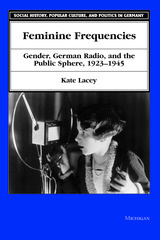 Feminine Frequencies: Gender, German Radio, and the Public Sphere 1923-1945
Kate Lacey
University of Michigan Press, 1996 The years following World War I in Germany saw the simultaneous emergence of radio as a public medium entering the private sphere of the home and the large-scale emergence of women entering the public sphere of politics and production. In Feminine Frequencies, Kate Lacey examines the mutual implications of these important developments and provides a distinctive analysis of radio in the Weimar Republic and the Third Reich which not only restores women to the history of radio, but identifies and investigates the impact of gender politics on the development of German broadcasting.At the heart of the book is an exploration of radio programming for women from the mid-1920s to the end of World War II. Largely through the Frauenfunk, radio transformed women's domestic life, mediated women's experience of modernity and war, and worked to integrate women into the modern consumer culture, the national economy, and eventually the "national community" of the Volksgemeinschaft. At the same time, decisions about how that programming was to operate influenced the way radio was conceived as a broadcast rather than an interactive technology.Ultimately, the cultural practice and propaganda of the Third Reich were anticipated in and enabled by the legacy of broadcasting in the Weimar Republic. Feminine Frequencies confronts the consequences of a missed opportunity to harness the democratic potential of a new medium of communication.Based on original archival research, and interdisciplinary in approach, this book will be of great interest to students and scholars in German studies, women's studies, and media studies.
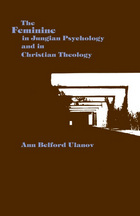 The Feminine in Jungian Psychology and in Christian Theology
Ann Belford Ulanov
Northwestern University Press, 1971 The Feminine in Jungian Psychology and in Christian Theology investigates the implications for Christian theology of Jung's special insights into the feminine. In it, Ann Belford Ulanov gathers together in one volume what Jung and Jungians have discovered about the feminine in order to explore what Jungian thought and methods may illuminate about the place of the feminine in Christian theology.
Jung focuses on the human person and sees as central its mixture of masculine and feminine elements. In a time when so much is asserted and written about women in society—their rights, roles, identities, needs, and contributions—it is especially significant that Jung asserts the existence of the feminine as a key element, not only in women but in men as well. No less contested are the roles and identities of Christians. Ulanov brings into focus the deep and fascinating connections between theology and psychology.
Feminine Principles & Women's Experience in American Composition & Rhetoric
Louise Phelps
University of Pittsburgh Press, 1995
In this unique collection, the editors and authors examine, against a rich historical background, the complex contributions that women have made to composition and rhetoric in American education. Using varied and at times experimental modes of presentation to portray teachers and learners at work, including the very young and the elderly, the text provides a generous and fresh feminine perspective on the field.
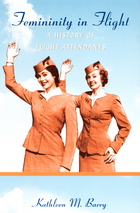 Femininity in Flight: A History of Flight Attendants
Kathleen M. Barry
Duke University Press, 2007 “In her new chic outfit, she looks like anything but a stewardess working. But work she does. Hard, too. And you hardly know it.” So read the text of a 1969 newspaper advertisement for Delta Airlines featuring a picture of a brightly smiling blond stewardess striding confidently down the aisle of an airplane cabin to deliver a meal. From the moment the first stewardesses took flight in 1930, flight attendants became glamorous icons of femininity. For decades, airlines hired only young, attractive, unmarried white women. They marketed passenger service aloft as an essentially feminine exercise in exuding charm, looking fabulous, and providing comfort. The actual work that flight attendants did—ensuring passenger safety, assuaging fears, serving food and drinks, all while conforming to airlines’ strict rules about appearance—was supposed to appear effortless; the better that stewardesses performed by airline standards, the more hidden were their skills and labor. Yet today flight attendants are acknowledged safety experts; they have their own unions. Gone are the no-marriage rules, the mandates to retire by thirty-two. In Femininity in Flight, Kathleen M. Barry tells the history of flight attendants, tracing the evolution of their glamorized image as ideal women and their activism as trade unionists and feminists. Barry argues that largely because their glamour obscured their labor, flight attendants unionized in the late 1940s and 1950s to demand recognition and respect as workers and self-styled professionals. In the 1960s and 1970s, flight attendants were one of the first groups to take advantage of new laws prohibiting sex discrimination. Their challenges to airlines’ restrictive employment policies and exploitive marketing practices (involving skimpy uniforms and provocative slogans such as “fly me”) made them high-profile critics of the cultural mystification and economic devaluing of “women’s work.” Barry combines attention to the political economy and technology of the airline industry with perceptive readings of popular culture, newspapers, industry publications, and first-person accounts. In so doing, she provides a potent mix of social and cultural history and a major contribution to the history of women’s work and working women’s activism.
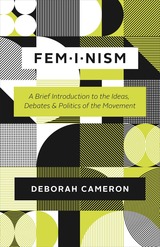 Feminism: A Brief Introduction to the Ideas, Debates, and Politics of the Movement
Deborah Cameron
University of Chicago Press, 2019 Beneath the nonstop cacophony of voices across social media, online forums, and news outlets lie the stubborn facts at the heart of the everyday struggles of women today: more than a third of single moms live in poverty; the United States sees more maternal deaths than anywhere else in the developed world; one in five women will be raped in her lifetime; and women still make eighty cents for every dollar earned by a man. Between these brutal statistics and the ill-informed, often contentious public debate stand millions of women who feel alienated, disaffected, or just plain worn out.
In the era of #MeToo, Trump, and online harassment, innovative progressive feminist voices are more essential than ever. With her latest book, Deborah Cameron considers feminism from all sides—as an idea, as a theoretical approach, and as a political movement. Written in the succinct, sharp style that has made Cameron’s feminist linguistics blog so popular, this short book lays out past and present debates on seven key topics: domination, rights, work, femininity, sex, culture, and the future. Feminism emphasizes the diversity of feminist thought, including queer, women-of-color, and trans perspectives. Cameron’s clear and incisive account untangles the often confusing strands of one of history’s most important intellectual and political movements.
Broad in scope but refreshingly concise, this book is perfect for anyone who needs a straightforward primer on the complex history of feminism, a nuanced explanation of key issues and debates, or strategic thinking about the questions facing activists today.
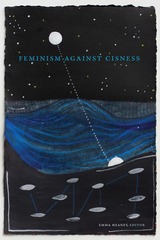 Feminism against Cisness
Emma Heaney, editor
Duke University Press, 2024 The contributors to Feminism against Cisness showcase the future of feminist historical, theoretical, and political thought freed from the conceptual strictures of cisness: the fallacy that assigned sex determines sexed experience. The essays demonstrate that this fallacy hinges on the enforcement of white and bourgeois standards of gender comportment that naturalize brutalizing race and class hierarchies. It is, therefore, no accident that the social processes making cisness compulsory are also implicated in anti-Blackness, misogyny, Indigenous erasure, xenophobia, and bourgeois antipathy for working-class life. Working from trans historical archives and materialist trans feminist theories, this volume demonstrates the violent work that cis ideology has done and thinks toward a future for feminism beyond this ideology's counterrevolutionary pull.
Contributors. Cameron Awkward-Rich, Marquis Bey, Kay Gabriel, Jules Gill-Peterson, Emma Heaney, Margaux L. Kristjansson, Greta LaFleur, Grace Lavery, Durba Mitra, Beans Velocci, Joanna Wuest
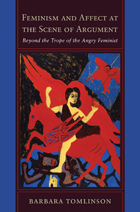 Feminism and Affect at the Scene of Argument: Beyond the Trope of the Angry Feminist
Authored by Barbara Tomlinson
Temple University Press, 2010 Are feminists really angry, unreasoning, man-haters who argue only from an emotional perspective as some claim? Does the incessant repetition of this trope make anti-feminism and misogyny a routine element in everyday speech? And does this repetition work towards delegitimizing feminist arguments and/or undermining feminist politics? How do skilled feminist writers deploy affect to advance feminist ideas? In Feminismand Affect at the Scene of Argument, Barbara Tomlinson addresses these questions, providing a lucid examination of the role of affect in feminist and antifeminist academic arguments. Using case studies from controversies in socio-legal studies, musicology, and science studies, among other disciplines, Tomlinson examines the rhetorics of anger, contempt, betrayal, intensification, and ridicule. She employs a set of critical tools—feminist “socio-forensic” discursive analysis—that will prove indispensible for understanding and countering tropes like that of the angry feminist. Moreover, these tools will advance feminism, which, she argues, is generated in and by arguments with allies and antagonists. In an era of debates that generate more heat than light, Feminism and Affectat the Scene of Argument offers a timely provocation for transforming the terms of reading and writing in scholarship and civic life.
Feminism and American Literary History: Essays
Baym, Nina
Rutgers University Press, 1992 Bodies may be currently fashionable in social and feminist theory, but their insides are not. Biological bodies always seem to drop out of debates about the body and its importance in Western culture. They are assumed to be fixed, their workings uninteresting or irrelevant to theory. Birke argues that these static views of biology do not serve feminist politics well. As a trained biologist, she uses ideas in anatomy and physiology to develop the feminist view that the biological body is socially and culturally constructed. She rejects the assumption that the body's functioning is somehow fixed and unchanging, claiming that biological science offers more than just a deterministic narrative of 'how nature works'. Feminism and the Biological Body puts biological science and feminist theory together and suggests that we need a politics which includes, rather than denies, our bodily flesh.
Feminism And Anthropology
Henrietta Moore
University of Minnesota Press, 1989 "This is a very important book and should be read by everyone interested in the development of, or feminist contributions to, sociocultural anthropology." Anthropos
"It is as near as possible essential reading. It brings feminist into the mainstream with a vengeance." Sociology
"[Moore's] emphasis on the issue of 'difference' and the ways that feminist anthropology can contribute both to anthropology and to feminism through its critical analysis of difference is an important and very helpful approach. This is a book that should be widely read and discussed." American Anthropologist
Feminism and Community
edited by Penny A. Weiss and Marilyn Friedman
Temple University Press, 1995 "Construing 'community' extremely broadly, from personal friendship to global dreams, this imaginative collection reveals the diversity of women's experiences in both traditional and feminist communities."
--Alison M. Jaggar, Professor of Philosophy and Women's Studies, University of Colorado at Boulder
This rich collection of essays explores a range of feminist perspectives on the importance of community to women's social, cultural, and political relationships. From the personal to the ethnographic to the theoretical, these essays discuss such topics as the viability of lesbian separatism, women and the Holocaust, interracial solidarity among women, the flaws in nonfeminist communitarianism, and the revolutionary prospects of feminist communities.
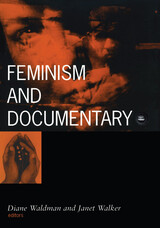 Feminism And Documentary
Diane Waldman
University of Minnesota Press, 1999 The first book of essays to explore the intersection of these two vital disciplines. Documentary and feminist film studies have long been separate or parallel universes that need to converse or collide. The essays in this volume, written by prominent scholars and filmmakers, demonstrate the challenges that feminist perspectives pose for documentary theory, history, and practice. They also show how fuller attention to documentary enriches and complicates feminist theory, especially regarding the relationship between gender and sexuality, race and ethnicity, class and nation. Feminism and Documentary begins with a substantial historical introduction that highlights several of the specific areas that contributors address: debates over realism, the relationship between filmmaker and subject, historical thinking about documentary and thinking about the historical documentary, biography and autobiography, and the use of psychoanalysis. Other essays, most of which appear here for the first time, range from broad overviews to close analyses of particular films and videos and from discussions of well-known works such as Roger and Me and Don’t Look Back to lesser known texts that might revise the canon. The collection includes an extensive filmography and videography with useful distribution information and a bibliography of work in this neglected area of scholarship. Lucid, sophisticated, and eye-opening, this book will galvanize documentary studies and demonstrate the need for women’s and cultural studies to grapple with visual media. Contributors: Michelle Citron, Northwestern U; Gloria J. Gibson, Indiana U; Chris Holmlund, U of Tennessee; Alexandra Juhasz, Pitzer College; Ann Kaneko; Anahid Kassabian, Fordham U; David Kazanjian, U of California, Berkeley; Susan Knobloch; Silvia Kratzer-Juilfs; Deborah Lefkowitz; Julia Lesage, U of Oregon; Laura U. Marks, Carleton U, Ottawa; Paula Rabinowitz, U of Minnesota; Michael Renov, USC; Patricia R. Zimmermann, Ithaca College.
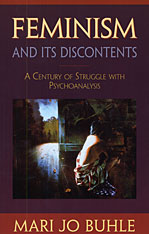 Feminism and Its Discontents: A Century of Struggle with Psychoanalysis
Mari Jo Buhle
Harvard University Press, 1998 With Sigmund Freud notoriously flummoxed about what women want, any encounter between psychoanalysis and feminism would seem to promise a standoff. But in this lively, often surprising history, Mari Jo Buhle reveals that the twentieth century’s two great theories of liberation actually had a great deal to tell each other. Starting with Freud’s 1909 speech to an audience that included the feminist and radical Emma Goldman, Buhle recounts all the twists and turns this exchange took in the United States up to the recent American vogue of Jacques Lacan. While chronicling the contributions of feminism to the development of psychoanalysis, she also makes an intriguing case for the benefits psychoanalysis brought to feminism.
From the first, American psychoanalysis became the property of freewheeling intellectuals and popularists as well as trained analysts. Thus the cultural terrain that Buhle investigates is populated by literary critics, artists and filmmakers, historians, anthropologists, and sociologists—and the resulting psychoanalysis is not so much a strictly therapeutic theory as an immensely popular form of public discourse. She charts the history of feminism from the first wave in the 1910s to the second in the 1960s and into a variety of recent expressions. Where these paths meet, we see how the ideas of Freud and his followers helped further the real-life goals of a feminism that was a widespread social movement and not just an academic phenomenon. The marriage between psychoanalysis and feminism was not pure bliss, however, and Buhle documents the trying moments; most notably the “Momism” of the 1940s and 1950s, a remarkable instance of men blaming their own failures of virility on women.
An ambitious and highly engaging history of ideas, Feminism and Its Discontents brings together far-flung intellectual tendencies rarely seen in intimate relation to each other—and shows us a new way of seeing both.
 Feminism and Motherhood in Germany, 1800-1914
Ann Taylor Allen
Rutgers University Press, 1991 European historians have noted the prominent role of the maternal ethic -- the idea that woman's role as mother extends into society as a whole -- in the theory and practice of German feminism from 1840 to 1914. This body of ideas, however, has seldom been taken seriously. German feminism has been interpreted as a political strategy, not as an intellectual tradition. Historians have portrayed German feminists as conservative, in contrast to their liberal counterparts in other countries who were more likely to campaign for equal rights. Ann Allen revises these views by analyzing German feminism as an attempt to create a symbolic framework for understanding the world rather than simply to attain practical results. She examines the relationship between the experiences of individual female activists and the evolving intellectual traditions of German culture and of international feminism. Women thought their maternal role led to empowerment and ethical authority. The role gave them the legitimacy to give speeches, to organize reform movements, and to build feminist institutions. They campaigned for infant welfare and the expansion of state responsibility for the welfare of mothers and children. German feminists responded to central public issues, including revolution, national unification, and urbanization. They worked to transform both public and private worlds by extending their ethical values, developed in the family, to political and social issues. To make her argument, Allen examines the lives and work of the women who were important to the history of German feminism. They centered their careers on issues relating to motherhood and childcare. Allen relates their stories to a broader theme: the relationship of women's experience, under specific historical conditions, to the development of feminist ideology and practice. Allen assesses the historical significance of German feminism in the context of German history and of similar feminist movements in other countries, particularly the U.S. Allen calls for the ideas of German feminists to be judged with reference to the specific, local conditions under which they developed, rather than to essentialist notions of feminism. Some historians have identified equal rights ideologies as progressive and maternalist ones as conservative. But the women themselves did not perceive the antithesis between these two forms of ideology.
Feminism and Political Theory
Edited by Cass R. Sunstein
University of Chicago Press, 1990 This volume collects some of today's most original and important work at the intersection of feminism and political theory. A representative and wide-ranging set of readings on feminist political thought, the authors provide large-scale critiques, and in some instances reconstructions, of important strains in political thought, including notions of equality, rights-based justice, and contract theories. The fourteen essays are organized around four major themes: "The Question of a Different Voice: Care, Justice, and Rights," "Equality and Inequality in Politics and Elsewhere," "Coercion versus Consent, Public versus Private, and Sexuality," and "Trust and Responsibility."
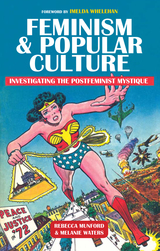 Feminism and Popular Culture: Investigating the Postfeminist Mystique
Munford, Rebecca
Rutgers University Press, 2014 When the term “postfeminism” entered the media lexicon in the 1990s, it was often accompanied by breathless headlines about the “death of feminism.” Those reports of feminism’s death may have been greatly exaggerated, and yet contemporary popular culture often conjures up a world in which feminism had never even been born, a fictional universe filled with suburban Stepford wives, maniacal career women, alluring amnesiacs, and other specimens of retro femininity.
In Feminism and Popular Culture, Rebecca Munford and Melanie Waters consider why the twenty-first century media landscape is so haunted by the ghosts of these traditional figures that feminism otherwise laid to rest. Why, over fifty years since Betty Friedan’s critique, does the feminine mystique exert such a strong spectral presence, and how has it been reimagined to speak to the concerns of a postfeminist audience?
To answer these questions, Munford and Waters draw from a rich array of examples from contemporary film, fiction, music, and television, from the shadowy cityscapes of Homeland to the haunted houses of American Horror Story. Alongside this comprehensive analysis of today’s popular culture, they offer a vivid portrait of feminism’s social and intellectual history, as well as an innovative application of Jacques Derrida’s theories of “hauntology.” Feminism and Popular Culture thus not only considers how contemporary media is being visited by the ghosts of feminism’s past, it raises vital questions about what this means for feminism’s future.
 Feminism and Postmodernism
Margaret Ferguson and Jennifer Wicke, eds.
Duke University Press, 1994 This collection of essays explores the significant agreements and tensions between contemporary feminist and postmodern theories and practices. Having brought enormous changes to conceptions of the body, identity, and the media, postmodernity compels the rethinking of many feminist categories, including female experience, the self, and the notion that "the personal is political." Feminist analysis has been equally important, though not always equally acknowledged, as a force within postmodernism. Feminist writings on subjectivity, master narratives, and the socioeconomic underpinnings of the master narrative of theory itself have been particularly influential. This volume traces the crossings and mutual interrogations of these two traditions into the arenas of cultural production, legal discourse, and philosophical thought. Multidisciplinary and international in their collective focus, the essays range from a study of Madonna as an Italian American woman who is revising the cultural meanings of an ethnic feminism to a unique interview with Mairead Keane, the national head of the Women’s Department of the Irish political party Sinn Fein. Turning the prism of postmodern feminism onto such diverse cultural objects as literary and literary critical texts, contemporary film, and music, these essays intervene in debates regarding technology, sexuality, and politics. Challenging modern feminisms to articulate their inescapable relation to postmodern society, this expanded edition of a special issue of boundary 2 also explores ways in which feminism can work as the cutting edge of a global postmodernism. Contributors. Salwa Bakr, Claire Detels, Margaret Ferguson, Carla Freccero, Marjorie Garber, Barbara Harlow, Laura E. Lyons, Anne McClintock, Toril Moi, Linda Nicholson, Mary Poovey, Andrew Ross, David Simpson, Kathyrn Bond Stockton, Jennifer Wicke
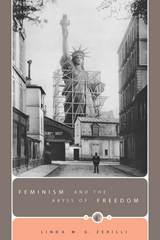 Feminism and the Abyss of Freedom
Linda M. G. Zerilli
University of Chicago Press, 2005 In contemporary feminist theory, the problem of feminine subjectivity persistently appears and reappears as the site that grounds all discussion of feminism. In Feminism and the Abyss of Freedom, Linda M. G. Zerilli argues that the persistence of this subject-centered frame severely limits feminists' capacity to think imaginatively about the central problem of feminist theory and practice: a politics concerned with freedom.
Offering both a discussion of feminism in its postmodern context and a critique of contemporary theory, Zerilli here challenges feminists to move away from a theory-based approach, which focuses on securing or contesting "women" as an analytic category of feminism, to one rooted in political action and judgment. She revisits the democratic problem of exclusion from participation in common affairs and elaborates a freedom-centered feminism as the political practice of beginning anew, world-building, and judging.
In a series of case studies, Zerilli draws on the political thought of Hannah Arendt to articulate a nonsovereign conception of political freedom and to explore a variety of feminist understandings of freedom in the twentieth century, including ones proposed by Judith Butler, Monique Wittig, and the Milan Women's Bookstore Collective. In so doing, Zerilli hopes to retrieve what Arendt called feminism's lost treasure: the original and radical claim to political freedom.
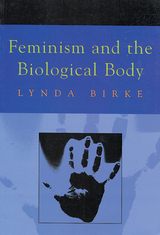 Feminism and the Biological Body
Birke, Lynda
Rutgers University Press, 2000 What is a body? What are our perceptions of our inner bodies? How are these perceptions influenced? In recent years, thinking about the body has become highly fashionable. However, the renewed focus, while certainly welcome, seems to always end at the corporeal surface. While recent sociological and feminist theory has made important claims about the process of cultural inscription on the body, and about the cultural representation of the body, what actually appears in this new theory seems to be, ironically, disembodied. If this newly theorized form has interiority, it is one that is explained predominantly through psychoanalysis. The physiological processes remain a mystery to be explained, if at all, only in the esoteric language of biomedicine. As a trained biologist, Lynda Birke was frustrated by the gap between feminist cultural analysis and her own scientific background. In this book, she seeks to bridge this gap using ideas in anatomy and physiology to develop the feminist view that the biological body is socially and culturally constructed. Birke rejects the assumption that bodily function is somehow fixed and unchanging, claiming that biology offers more than just a deterministic narrative of how nature works. Feminism and the Biological Body brings natural science and feminist theory together and suggests that we need a new politics that includes, rather than denies, our flesh.
 Feminism and the Cinema of Experience
Lori Jo Marso
Duke University Press, 2024 From popular films like Greta Gerwig’s Barbie (2023) to Chantal Akerman’s avant-garde classic Jeanne Dielman (1975), feminist cinema can provoke discomfort. Ambivalence, stasis, horror, cringe—these and other affects refuse the resolution of feeling good or bad, leaving viewers questioning and disoriented. In Feminism and the Cinema of Experience, Lori Jo Marso examines how filmmakers scramble our senses to open up space for encountering and examining the political conditions of patriarchy, racism, and existential anxiety. Building on Akerman’s cinematic lexicon and Simone de Beauvoir’s phenomenological attention to the lives of girls and women, Marso analyzes film and television by directors ranging from Akerman, Gerwig, Mati Diop, Catherine Breillat, and Joey Soloway to Emerald Fennell, Michaela Coel, Audrey Diwan, Alice Diop, and Julia Ducournau. Through their innovative and intentional uses of camera, sound, editing, and new forms of narrative, these directors use discomfort in order to invite viewers to feel like feminists and to sense the possibility of freedom.
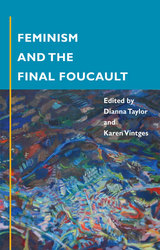 Feminism and the Final Foucault
Edited by Dianna Taylor and Karen Vintges
University of Illinois Press, 2004 Feminism and the Final Foucault is the first systematic offering of contemporary, international feminist perspectives on the later work of philosopher Michel Foucault.
Rather than simply debating the merits or limitations of Foucault's later work, the essays in this collection examine women's historical self-practices, conceive of feminism as a shared ethos, and consider the political significance of this conceptualization in order to elucidate, experiment with, and put into practice the conceptual "tools" that Foucault offers for feminist ethics and politics. The volume illustrates the ways in which Foucault's later thinking on ethics as "care of the self" can reintroduce a number of issues and themes that feminists jettisoned in the wake of postmodernism, including consciousness raising, feminist therapy, the subject woman, identity politics, and feminist agency.
Taken as a whole, the diversity of feminist viewpoints presented provide important new insights into "the final Foucault," and thus serve as a productive intervention in current Foucault scholarship.
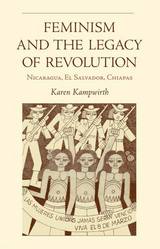 Feminism and the Legacy of Revolution: Nicaragua, El Salvador, Chiapas
Karen Kampwirth
Ohio University Press, 2004 In many Latin American countries, guerrilla struggle and feminism have been linked in surprising ways. Women were mobilized by the thousands to promote revolutionary agendas that had little to do with increasing gender equality. They ended up creating a uniquely Latin American version of feminism that combined revolutionary goals of economic equality and social justice with typically feminist aims of equality, nonviolence, and reproductive rights. Drawing on more than two hundred interviews with women in Nicaragua, El Salvador, and the Mexican state of Chiapas, Karen Kampwirth tells the story of how the guerrilla wars led to the rise of feminism, why certain women became feminists, and what sorts of feminist movements they built. Feminism and the Legacy of Revolution: Nicaragua, El Salvador, Chiapas explores how the violent politics of guerrilla struggle could be related to the peaceful politics of feminism. It considers the gains, losses, and internal conflicts within revolutionary women’s organizations. Feminism and the Legacy of Revolution challenges old assumptions regarding revolutionary movements and the legacy of those movements for the politics of daily life. It will appeal to a broad, interdisciplinary audience in political science, sociology, anthropology, women’s studies, and Latin American studies as well as to general readers with an interest in international feminism.
Feminism and the Politics of Childhood: Friends or Foes?
Edited by Rachel Rosen and Katherine Twamley
University College London, 2018 Feminism and the Politics of Childhood explores commonalities and conflicts between the various forms of feminism and the politics of childhood. This innovative collection introduces authors from a range of geographical contexts, social science disciplines, activist organizations, and theoretical perspectives. The wide variety of subjects covered includes refugee camps, care labor, family violence, and childhood education. Taken together, the contributions provide ways to conceptualize relations between women and children, addressing injustices faced by both groups.
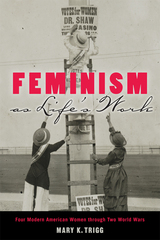 Feminism as Life's Work: Four Modern American Women through Two World Wars
Trigg, Mary K
Rutgers University Press, 2014 With suffrage secured in 1920, feminists faced the challenge of how to keep their momentum going. As the center of the movement shrank, a small, self-appointed vanguard of “modern” women carried the cause forward in life and work. Feminism as Life’s Work profiles four of these women: the author Inez Haynes Irwin, the historian Mary Ritter Beard, the activist Doris Stevens, and Lorine Pruette, a psychologist. Their life-stories, told here in full for the first time, embody the changes of the first four decades of the twentieth century—and complicate what we know of the period.
Through these women’s intertwined stories, Mary Trigg traces the changing nature of the women’s movement across turbulent decades rent by world war, revolution, global depression, and the rise of fascism. Criticizing the standard division of feminist activism as a series of historical waves, Trigg exposes how Irwin, Beard, Stevens, and Pruette helped push the U.S. feminist movement to victory and continued to propel it forward from the 1920s to the 1960s, decades not included in the “wave” model. At a time widely viewed as the “doldrums” of feminism, the women in this book were in fact taking the cause to new sites: the National Women’s Party; sexuality and relations with men; marriage; and work and financial independence. In their utopian efforts to reshape work, sexual relations, and marriage, modern feminists ran headlong into the harsh realities of male power, the sexual double standard, the demands of motherhood, and gendered social structures.
In Feminism as Life’s Work, Irwin, Beard, Stevens, and Pruette emerge as the heirs of the suffrage movement, guardians of a long feminist tradition, and catalysts of the belief in equality and difference. Theirs is a story of courage, application, and perseverance—a story that revisits the “bleak and lonely years” of the U.S. women’s movement and emerges with a fresh perspective of the history of this pivotal era.
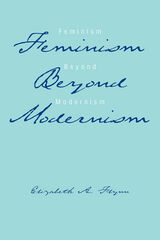 Feminism Beyond Modernism
Elizabeth Flynn
Southern Illinois University Press, 2002 Misunderstanding and denigration of postmodern feminism are widespread. Elizabeth Flynn’s Feminism Beyond Modernism comes to its defense in a cogent and astute manner by first distinguishing between postmodern and antimodern feminisms and then reclaiming postmodern feminism by reconfiguring its relationship to modernism. Too often postmodern feminism is unfairly identified as opposed to modernism and associated with subjectivism and relativism. Flynnaddresses these problems by provisionally defining postmodern feminism as problematizing and critiquing modernism without directly opposing it. Flynn also suggests that feminist traditions that reject modernism, such as radical and cultural feminisms, are antimodern rather than postmodern. In this interdisciplinary study, Flynn defines feminist traditions broadly, situating her discussions within the contexts of literary studies and rhetoric and composition while simultaneously exploring the troubled relationship between these fields. Departing from accepted definitions of modernism, Flynn distinguishes between aesthetic modernism and Enlightenment modernism and uses the work of John Locke, Sigmund Freud, Charlotte Perkins Gilman, Michel Foucault, Donna Haraway, and others as benchmarks for historical placement. In addition, rereadings of works by Virginia Woolf, Adrienne Rich, Alice Walker, Louise Rosenblatt, and others demonstrate the complex ways in which they respond to modernist pressures and tendencies. From this context, Flynn’s Feminism Beyond Modernism reconfigures feminist traditions by defining postmodern feminism as a critique of modernism rather than as an antimodern opponent.
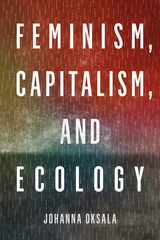 Feminism, Capitalism, and Ecology
Johanna Oksala
Northwestern University Press, 2023 A philosophical response that brings together feminist and ecological approaches to solving the global environmental crisis that the capitalist economic system has created
In the face of ecological catastrophe, neither feminists nor environmentalists have the option of merely supporting an environmental politics that would preserve an imagined nature somewhere outside capitalism. As Johanna Oksala contends, the political goal must be more radical: to challenge the capitalist economic system itself and the mechanisms by which it expropriates life on the planet.
Feminism, Capitalism, and Ecology lays the critical groundwork for this political project. It develops a new way of bringing feminist and ecological responses to capitalism together into a cohesive framework. By exposing the systemic logic by which environmental destruction and gender oppression are jointly rooted in capitalism, Oksala establishes the theoretical foundations for an effective political alliance. The traditions of materialist ecofeminism and Marxist feminism are critical starting points. But the rapid rise of biotechnology and the steady increase of precarity necessitate a model of resistance that responds to the distinctive challenges of contemporary biocapitalism. Timely and urgent, this book articulates a theoretically sophisticated response and maps out our real-world options in this existential struggle.
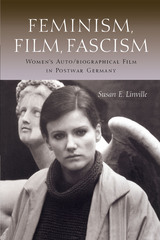 Feminism, Film, Fascism: Women's Auto/biographical Film in Postwar Germany
By Susan E. Linville
University of Texas Press, 1998 German society's inability and/or refusal to come to terms with its Nazi past has been analyzed in many cultural works, including the well-known books Society without the Father and The Inability to Mourn. In this pathfinding study, Susan Linville challenges the accepted wisdom of these books by focusing on a cultural realm in which mourning for the Nazi past and opposing the patriarchal and authoritarian nature of postwar German culture are central concerns—namely, women's feminist auto/biographical films of the 1970s and 1980s. After a broad survey of feminist theory, Linville analyzes five important films that reflect back on the Third Reich through the experiences of women of different ages—Marianne Rosenbaum's Peppermint Peace, Helma Sanders-Brahms's Germany, Pale Mother, Jutta Brückner's Hunger Years, Margarethe von Trotta's Marianne and Juliane, and Jeanine Meerapfel's Malou. By juxtaposing these films with the accepted theories on German culture, Linville offers a fresh appraisal not only of the films' importance but especially of their challenge to misogynist interpretations of the German failure to grieve for the horrors of its Nazi past.
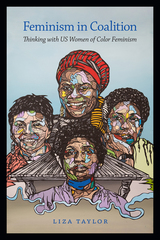 Feminism in Coalition: Thinking with US Women of Color Feminism
Liza Taylor
Duke University Press, 2022 In Feminism in Coalition Liza Taylor examines how US women of color feminists’ coalitional politics provides an indispensable resource to contemporary political theory, feminist studies, and intersectional social justice activism. Taylor charts the theorization of coalition in the work of Bernice Johnson Reagon, Audre Lorde, Barbara Smith, the Combahee River Collective, Gloria Anzaldúa, Cherríe Moraga, and others. For these activist-scholars, coalition is a dangerous struggle that emerges from a shared political commitment to undermining oppression and an emphasis on self-transformation. Taylor shows how their coalitional understandings of group politics, identity, consciousness, and scholarship have transformed how activists and theorists build alliances across race, class, gender, sexuality, faith, and ethnicity to tackle systems of domination. Their coalitional politics enrich current discussions surrounding the impetus and longevity of effective activism, present robust theoretical accounts of political subject formation and political consciousness, and demonstrate the promise of collective modes of scholarship. In this way, women of color feminists have been formulating solutions to long-standing problems in political theory. By illustrating coalition’s vitality to a variety of practical and philosophical interdisciplinary discussions, Taylor encourages us to rethink feminist and political theory.
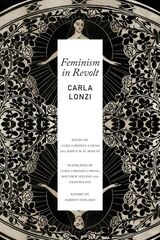 Feminism in Revolt: An Anthology
Carla Lonzi
Seagull Books, 2023 A comprehensive collection of texts from the most influential and iconic figure of Italian second-wave feminism.
Recently rediscovered in Italy and abroad, the works of Carla Lonzi tend to fall under the remit of art history or feminist theory. Art historians focus on the texts written in the 1960s, when Lonzi was still actively working as a critic, whereas feminist scholars engage with her more openly political interventions, published after her declared embrace of a separatist feminism. In 1970 Lonzi decided to leave the art world for good and dedicate herself to her newly founded feminist collective, Rivolta Femminile. While recognizing the break in Lonzi’s life and work, this anthology maps the overall arc of her intellectual and political production, giving equal weight to her seminal contributions to art criticism and her trailblazing feminist writings. A comprehensive collection of texts from the most influential and iconic figure of Italian second-wave feminism, Feminism in Revolt seeks to shed light on Lonzi’s versatile approach to literary genres and compositions by juxtaposing essayistic texts, poems, diary excerpts, and manifestos.
Feminism in Time, Volume 65
Margaret Ferguson and Marshall Brown, eds.
Duke University Press The essays in this special issue of Modern Language Quarterly reflect intensively on feminism during various periods and build conceptual bridges linking early modern female writers, such as Marguerite de Navarre and Mary Wollstonecraft, with theorists, poets, and fiction writers of the postmodern era. Contributors. Jonathan Culler, Joan DeJean, Rachel Blau DuPlessis, Carla Freccero, Angela Leighton, Laura Mandell, Jeffrey Masten, Robyn Wiegman
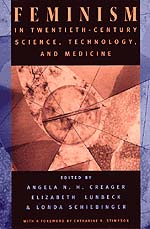 Feminism in Twentieth-Century Science, Technology, and Medicine
Edited by Angela N. H. Creager, Elizabeth Lunbeck, and Londa Schiebinger
University of Chicago Press, 2001 What useful changes has feminism brought to science? Feminists have enjoyed success in their efforts to open many fields to women as participants. But the effects of feminism have not been restricted to altering employment and professional opportunities for women. The essays in this volume explore how feminist theory has had a direct impact on research in the biological and social sciences, in medicine, and in technology, often providing the impetus for fundamentally changing the theoretical underpinnings and practices of such research. In archaeology, evidence of women's hunting activities suggested by spears found in women's graves is no longer dismissed; computer scientists have used feminist epistemologies for rethinking the human-interface problems of our growing reliance on computers. Attention to women's movements often tends to reinforce a presumption that feminism changes institutions through critique-from-without. This volume reveals the potent but not always visible transformations feminism has brought to science, technology, and medicine from within.
Contributors:
Ruth Schwartz Cowan
Linda Marie Fedigan
Scott Gilbert
Evelynn M. Hammonds
Evelyn Fox Keller
Pamela E. Mack
Michael S. Mahoney
Emily Martin
Ruth Oldenziel
Nelly Oudshoorn
Carroll Pursell
Karen Rader
Alison Wylie
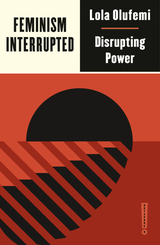 Feminism, Interrupted: Disrupting Power
Lola Olufemi
Pluto Press, 2020 "I was blown away"—Angela Davis
"Reading her is to believe that another world is possible."—The Guardian
More than just a slogan on a t-shirt, feminism is a radical tool for fighting back against structural violence and injustice. Feminism, Interrupted is a bold call to seize feminism back from the cultural gatekeepers and return it to its radical roots.
Writer and organizer Lola Olufemi explores state violence against women, the fight for reproductive justice, transmisogyny, gendered Islamophobia and solidarity with global struggles, showing that the fight for gendered liberation can change the world for everybody when we refuse to think of it solely as women's work. Chapters include:
*Know your history
*The sexist state
*The fight for reproductive justice
*The savior complex: Muslim women and gendered Islamophobia
*Complicated consent: How to support sex workers
*The answer to sexual violence is not more prisons
*Feminism and food
*Solidarity is a doing word
Including testimonials from Sisters Uncut, migrant groups working for reproductive justice, prison abolitionists and activists involved in the international fight for Kurdish and Palestinian rights, Olufemi emphasizes the link between feminism and grassroots organizing. Reclaiming feminism from the clutches of the consumerist, neoliberal model, Feminism, Interrupted shows that when “feminist” is more than a label, it holds the potential for radical transformative work.
Olufemi writes in her Introduction, "Feminism is a political project about what could be. It’s always looking forward, investing in future we can’t quite grasp yet. It’s a way of swishing, hoping, aiming at everything that has been deemed impossible. It’s a task that has to be approached seriously. This book is for anyone who is beginning to think critically….If this book makes you pick up another book, or watch a documentary, search the archive, reach for a poetry book—if it spars or reignites your interest in feminism, then it has served its purpose."
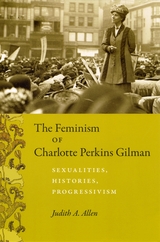 The Feminism of Charlotte Perkins Gilman: Sexualities, Histories, Progressivism
Judith A. Allen
University of Chicago Press, 2009 Famous for her short fiction—most notably “The Yellow Wallpaper”—Charlotte Perkins Gilman also produced a vast body of nonfiction in tandem with her work as a Progressive-era feminist reformer. Rooted in groundbreaking research on Gilman’s extensive correspondence, publications, and speeches, this keenly argued intellectual biography reconstructs her controversial output and the heady context in which she produced it. Judith Allen provides the first comprehensive assessment of Gilman’s complicated feminism by exploring the renowned writer’s theories of sexuality and evolutionary analyses of androcentric—or male-dominated—culture. These ideas, Allen shows, informed Gilman’s many contributions to the suffrage movement, the fight to abolish regulated prostitution, and efforts to legalize birth control. Restoring a previously overlooked public intellectual to her preeminent place in Progressive-era politics and the history of feminism at home and abroad, Allen’s landmark study provides the fullest account available of Gilman’s consequential life and profoundly influential work.
The Feminism of Uncertainty: A Gender Diary
Ann Snitow
Duke University Press, 2015 The Feminism of Uncertainty brings together Ann Snitow’s passionate, provocative dispatches from forty years on the front lines of feminist activism and thought. In such celebrated pieces as "A Gender Diary"—which confronts feminism’s need to embrace, while dismantling, the category of "woman"—Snitow is a virtuoso of paradox. Freely mixing genres in vibrant prose, she considers Angela Carter, Doris Lessing, and Dorothy Dinnerstein and offers self-reflexive accounts of her own organizing, writing, and teaching. Her pieces on international activism, sexuality, motherhood, and the waywardness of political memory all engage feminism’s impossible contradictions—and its utopian hopes.
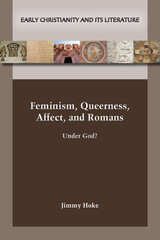 Feminism, Queerness, Affect, and Romans:Under God?
Jimmy Hoke
SBL Press, 2021 "This is a book about submission and subversion, injustice and justice, heroes and villains."
In Feminism, Queerness, Affect, and Romans: Under God? Jimmy Hoke reads Romans with an innovative, intersectional approach that produces distinctive meanings for passages that probe how queer wo/men who first encountered Paul's letter could have engaged with it. Though Paul's letter to the Romans arguably contains the Bible’s strongest condemnation of queer wo/men (1:26–27), that is not the letter's full story. Hoke turns a feminist and queer gaze toward Paul’s conception of faith and ethics, making explicit how Paul's theology throughout Romans has been affectively motivated by imperial notions of gender, race, and sexuality. Moving beyond Paul's singular voice, Hoke engages with a feminist and queer praxis of assemblage to generate plausible ways wo/men of Rome interacted with this epistle. By engaging affect theory, Hoke brings to life not only ideas and words but the feelings and sensations that moved in-between some of the earliest Christ-followers, revealing how queer wo/men were there among them and what that means for queer wo/men today. Hoke includes a reader's guide with key terms used throughout the book, making this an excellent option for both students and scholars beginning to engage not only Paul's letters but also the complex worlds of feminist, queer, and affect theories.
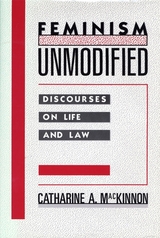 Feminism Unmodified: Discourses on Life and Law
Catharine A. MacKinnon
Harvard University Press, 1987 Catharine A. MacKinnon, noted feminist and legal scholar, explores and develops her original theories and practical proposals on sexual politics and law. These discourses, originally delivered as speeches, have been brilliantly woven into a book that retains all the spontaneity and accessibility of a live presentation. MacKinnon offers a unique retrospective on the law of sexual harassment, which she designed and has worked for a decade to establish, and a prospectus on the law of pornography, which she proposes to change in the next ten years. Authentic in voice, sweeping in scope, startling in clarity, urgent, never compromised and often visionary, these discourses advance a new theory of sex inequality and imagine new possibilities for social change.
Through these engaged works on issues such as rape, abortion, athletics, sexual harassment, and pornography, MacKinnon seeks feminism on its own terms, unconstrained by the limits of prior traditions. She argues that viewing gender as a matter of sameness and difference—as virtually all existing theory and law have done—covers up the reality of gender, which is a system of social hierarchy, an imposed inequality of power. She reveals a political system of male dominance and female subordination that sexualizes power for men and powerlessness for women. She analyzes the failure of organized feminism, particularly legal feminism, to alter this condition, exposing the way male supremacy gives women a survival stake in the system that destroys them.
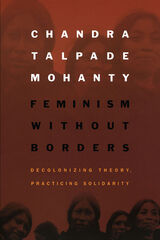 Feminism without Borders: Decolonizing Theory, Practicing Solidarity
Chandra Talpade Mohanty
Duke University Press, 2003 Bringing together classic and new writings of the trailblazing feminist theorist Chandra Talpade Mohanty, Feminism without Borders addresses some of the most pressing and complex issues facing contemporary feminism. Forging vital links between daily life and collective action and between theory and pedagogy, Mohanty has been at the vanguard of Third World and international feminist thought and activism for nearly two decades. This collection highlights the concerns running throughout her pioneering work: the politics of difference and solidarity, decolonizing and democratizing feminist practice, the crossing of borders, and the relation of feminist knowledge and scholarship to organizing and social movements. Mohanty offers here a sustained critique of globalization and urges a reorientation of transnational feminist practice toward anticapitalist struggles. Feminism without Borders opens with Mohanty's influential critique of western feminism ("Under Western Eyes") and closes with a reconsideration of that piece based on her latest thinking regarding the ways that gender matters in the racial, class, and national formations of globalization. In between these essays, Mohanty meditates on the lives of women workers at different ends of the global assembly line (in India, the United Kingdom, and the United States); feminist writing on experience, identity, and community; dominant conceptions of multiculturalism and citizenship; and the corporatization of the North American academy. She considers the evolution of interdisciplinary programs like Women's Studies and Race and Ethnic Studies; pedagogies of accommodation and dissent; and transnational women's movements for grassroots ecological solutions and consumer, health, and reproductive rights. Mohanty's probing and provocative analyses of key concepts in feminist thought—"home," "sisterhood," "experience," "community"—lead the way toward a feminism without borders, a feminism fully engaged with the realities of a transnational world.
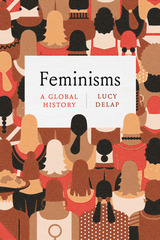 Feminisms: A Global History
Lucy Delap
University of Chicago Press, 2020 A global, useable history of feminism that incorporates alternative starting points and new thinkers, challenging the presumed priority of European feminism and offering a reinterpretation of the historical record.
Feminism’s origins have often been framed around a limited cast of mostly white and educated foremothers, but the truth is that feminism has been and continues to be a global movement. For centuries, women from all walks of life have been mobilizing for gender justice. As the last decade has reminded even the most powerful women, there is nothing “post-feminist” about our world. And there is much to be learned from the passion and protests of the past.
Historian Lucy Delap looks to the global past to give us a usable history of the movement against gender injustice—one that can help clarify questions of feminist strategy, priority and focus in the contemporary moment. Rooted in recent innovative histories, the book incorporates alternative starting points and new thinkers, challenging the presumed priority of European feminists and ranging across a global terrain of revolutions, religions, empires and anti-colonial struggles.
In Feminisms, we find familiar stories—of suffrage, of solidarity, of protest—yet there is no assumption that feminism looks the same in each place or time. Instead, Delap explores a central paradox: feminists have demanded inclusion but have persistently practiced their own exclusions. Some voices are heard and others are routinely muted. In amplifying the voices of figures at the grassroots level, Delap shows us how a rich relationship to the feminist past can help inform its future.
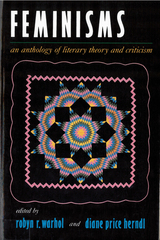 Feminisms: An Anthology
Warhol-Down, Robyn
Rutgers University Press, 1991 In the landmark 1991 edition of Feminisms, Robyn Warhol and Diane Price Herndl assembled the most comprehensive collection of American and British feminist literary criticism ever published. In this revised edition, the editors have updated the volume, in keeping with the expanding parameters of feminist literary discourse. With the inclusion of more than two dozen new essays, along with a major reorganization of the sections in which they appear, Warhol and Price Herndl have again established the measure for representing the latest developments in the field of feminist literary theory. Believing that the feminist movement can only move forward "where difference commands attention, not dismissal or negativism," they have continued the original collection's mission of providing a multiplicity of perspectives and approaches. This revised edition contains three new sections ("Conflict," "Gaze," and "Practice") and includes more selections by and about women of color and lesbians.
Feminisms and Contemporary Art in Indonesia: Defining Experiences
Wulan Dirgantoro
Amsterdam University Press, 2017 While Indonesian contemporary art is currently on the rise on the international art scene, there hasn't yet been an in-depth study of the works of Indonesian women artists and the feminist strategies they employ within the art world. This book fills that gap, presenting the first comprehensive study of feminisms and contemporary art in Indonesia; using feminist readings to analyse the works of Indonesian women artists historically and today; illuminating the sociocultural contexts in which they have worked; and offering a nuanced understanding of local feminisms in the nation.
Feminisms at a Millennium
Edited by Judith A. Howard and Carolyn Allen
University of Chicago Press, 2001 Last year the editors of Signs: Journal of Women in Culture and Society invited feminists worldwide to comment on the millennial transition. Representing a disciplinary and generational range of writers, the resulting collection is at turns inspiring, troubling, provocative, despairing, celebratory. Some of the essays give voice to anxieties, others are more hopeful; some reflect back, others look forward. Many of these fifty-plus short essays speak to themes of gender, nationality, global independence, transnational corporate domination, racial and ethnic identities, and complex intersections among these systems. Readers will find eye-opening writing that is thoughtful, committed, and passionate about feminist futures.
Feminisms: Diversity, Difference and Multiplicity in Contemporary Film Cultures
Edited by Laura Mulvey and Anna Backman Rogers
Amsterdam University Press, 2015 This collection brings together an exciting group of established and emerging scholars to consider the history of feminist film theory and new developments in the field and in film culture itself. Opening the field up to urgent questions and covering such topics as new experimental film, the digital image, consumerism, activism, and pornography, Feminisms will be essential reading for scholars of both film and feminism.
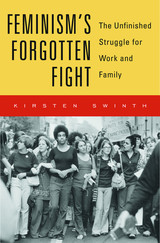 Feminism’s Forgotten Fight: The Unfinished Struggle for Work and Family
Kirsten Swinth
Harvard University Press, 2018 A spirited defense of feminism, arguing that the lack of support for working mothers is less a failure of second-wave feminism than a rejection by reactionaries of the sweeping changes they campaigned for.
When people discuss feminism, they often lament its failure to deliver on the promise that women can “have it all.” But as Kirsten Swinth argues in this provocative book, it is not feminism that has betrayed women, but a society that balked at making the far-reaching changes for which activists fought. Feminism’s Forgotten Fight resurrects the comprehensive vision of feminism’s second wave at a time when its principles are under renewed attack.
Through compelling stories of local and national activism and crucial legislative and judicial battles, Swinth’s history spotlights concerns not commonly associated with the movement of the 1960s and 1970s. We see liberals and radicals, white women and women of color, rethinking gender roles and redistributing housework. They brought men into the fold, and together demanded bold policy changes to ensure job protection for pregnant women and federal support for child care. Many of the creative proposals they devised to reshape the workplace and rework government policy—such as guaranteed incomes for mothers and flex time—now seem prescient.
Swinth definitively dispels the notion that second-wave feminists pushed women into the workplace without offering solutions to issues they faced at home. Feminism’s Forgotten Fight examines activists’ campaigns for work and family in depth, and helps us see how feminism’s opponents—not feminists themselves—blocked the movement’s aspirations. Her insights offer key lessons for women’s ongoing struggle to achieve equality at home and work.
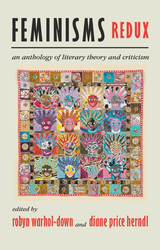 Feminisms Redux: An Anthology of Literary Theory and Criticism
Warhol-Down, Robyn
Rutgers University Press, 2009 The 1991 landmark edition of Feminisms presented the most comprehensive collection of American and British feminist literary criticism ever published. By 1997, realizing the need to update the work to remain within the expanded parameters of feminist literary discourse, the volume was revised to include more than two dozen new essays. Now, at the dawn of a new century of thought and action, it is important once again to revisit the canon of feminist literary criticism and theory and re-establish the measure for representing the latest developments in the field. Robyn Warhol-Down and Diane Price Herndl have joined together once more to provide academics and general readers with a newly revised and indispensable collection of essays representing the range of feminist literary criticism. Feminisms Redux, presented in a concise format, includes many essays from the second edition that continue to speak to current concerns and also provides readers with new contributions that address work in postcolonial studies, queer theory, and disability studies. As in the earlier volumes, the editors have gathered the full text of original articles and book chapters, with no edited excerpts. The range of essays focuses not only on gender and sex, but also on sexuality, race, class, nationality, and (dis)ability, and the intersections among these categories as they play out in writing by and about women. More than a revision of archetypal work, Feminisms Redux represents the dawning of a new classic.
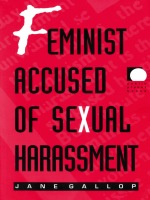 Feminist Accused of Sexual Harassment
Jane Gallop
Duke University Press, 1997 Sexual harassment is an issue in which feminists are usually thought to be on the plaintiff’s side. But in 1993—amid considerable attention from the national academic community—Jane Gallop, a prominent feminist professor of literature, was accused of sexual harassment by two of her women graduate students. In Feminist Accused of Sexual Harassment, Gallop tells the story of how and why she was charged with sexual harassment and what resulted from the accusations. Weaving together memoir and theoretical reflections, Gallop uses her dramatic personal experience to offer a vivid analysis of current trends in sexual harassment policy and to pose difficult questions regarding teaching and sex, feminism and knowledge.
Comparing “still new” feminism—as she first encountered it in the early 1970s—with the more established academic discipline that women’s studies has become, Gallop makes a case for the intertwining of learning and pleasure. Refusing to acquiesce to an imperative of silence that surrounds such issues, Gallop acknowledges—and describes—her experiences with the eroticism of learning and teaching. She argues that antiharassment activism has turned away from the feminism that created it and suggests that accusations of harassment are taking aim at the inherent sexuality of professional and pedagogic activity rather than indicting discrimination based on gender—that antiharassment has been transformed into a sensationalist campaign against sexuality itself.
Feminist Accused of Sexual Harassment offers a direct and challenging perspective on the complex and charged issues surrounding the intersection of politics, sexuality, feminism, and power. Gallop’s story and her characteristically bold way of telling it will be compelling reading for anyone interested in these issues and particularly to anyone interested in the ways they pertain to the university.
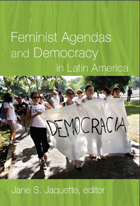 Feminist Agendas and Democracy in Latin America
Jane S. Jaquette, ed.
Duke University Press, 2009 Latin American women’s movements played important roles in the democratic transitions in South America during the 1980s and in Central America during the 1990s. However, very little has been written on what has become of these movements and their agendas since the return to democracy. This timely collection examines how women’s movements have responded to the dramatic political, economic, and social changes of the last twenty years. In these essays, leading scholar-activists focus on the various strategies women’s movements have adopted and assess their successes and failures. The book is organized around three broad topics. The first, women’s access to political power at the national level, is addressed by essays on the election of Michelle Bachelet in Chile, gender quotas in Argentina and Brazil, and the responses of the women’s movement to the “Bolivarian revolution” in Venezuela. The second topic, the use of legal strategies, is taken up in essays on women’s rights across the board in Argentina, violence against women in Brazil, and gender in the work of the Truth and Reconciliation Commission in Peru. Finally, the international impact of Latin American feminists is explored through an account of their participation in the World Social Forum, an assessment of a Chilean-led project carried out by women’s organizations in several countries to hold governments to the promises they made at international conferences in Cairo and Beijing, and an account of cross-border organizing to address femicides and domestic abuse in the Juárez-El Paso border region. Jane S. Jaquette provides the historical and political context of women’s movement activism in her introduction, and concludes the volume by engaging contemporary debates about feminism, civil society, and democracy. Contributors. Jutta Borner, Mariana Caminotti, Alina Donoso, Gioconda Espina, Jane S. Jaquette, Beatriz Kohen, Julissa Mantilla Falcón, Jutta Marx, Gabriela L. Montoya, Flávia Piovesan, Marcela Ríos Tobar, Kathleen Staudt, Teresa Valdés, Virginia Vargas
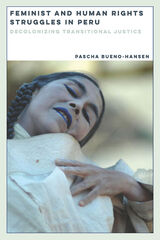 Feminist and Human Rights Struggles in Peru: Decolonizing Transitional Justice
Pascha Bueno-Hansen
University of Illinois Press, 2015 In 2001, following a generation of armed conflict and authoritarian rule, the Peruvian state created a Truth and Reconciliation Committee (TRC). Pascha Bueno-Hansen places the TRC, feminist and human rights movements, and related non-governmental organizations within an international and historical context to expose the difficulties in addressing gender-based violence. Her innovative theoretical and methodological framework based on decolonial feminism and a critical engagement with intersectionality facilitates an in-depth examination of the Peruvian transitional justice process based on field studies and archival research. Bueno-Hansen uncovers the colonial mappings and linear temporality underlying transitional justice efforts and illustrates why transitional justice mechanisms must reckon with the societal roots of atrocities, if they are to result in true and lasting social transformation. Original and bold, Feminist and Human Rights Struggles in Peru elucidates the tension between the promise of transitional justice and persistent inequality and impunity.
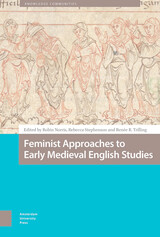 Feminist Approaches to Early Medieval English Studies
Robin Norris
Amsterdam University Press, 2023 Scholarship on early medieval England has seen an exponential increase in scholarly work by and about women over the past twenty years, but the field has remained peculiarly resistant to the transformative potential of feminist critique. Since 2016, Medieval Studies has been rocked by conversations about the state of the field, shifting from #MeToo to #WhiteFeminism to the purposeful rethinking of the label “Anglo-Saxonist.” This volume takes a step toward decentering the traditional scholarly conversation with thirteen new essays by American, Canadian, European, and UK professors, along with independent scholars and early career researchers from a range of disciplinary perspectives. Topics range from virginity, women’s literacy, and medical discourse to affect, medievalism, and masculinity. The theoretical and political commitments of this volume comprise one strand of a multivalent effort to rethink the parameters of the discipline and to create a scholarly community that is innovative, inclusive, and diverse.
The Feminist Avant-Garde In American Poetry
Elisabeth A. Frost
University of Iowa Press, 2005 The Feminist Avant-Garde in American Poetry offers a historical and theoretical account of avant-garde women poets in America from the 1910s through the 1990s and asserts an alternative tradition to the predominantly male-dominated avant-garde movements. Elisabeth Frost argues that this alternative lineage distinguishes itself by its feminism and its ambivalence toward existing avant-garde projects; she also thoroughly explores feminist avant-garde poets' debts and contributions to their male counterparts.
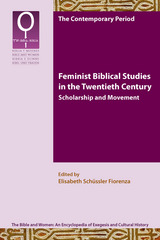 Feminist Biblical Studies in the Twentieth Century: Scholarship and Movement
Elisabeth Schüssler Fiorenza
SBL Press, 2014 Chart the development of feminist approaches and theories of interpretation during the period when women first joined the ranks of biblical scholars
This collection of essays on feminist biblical studies in the twentieth century seeks to explore four areas of inquiry demanding further investigation. In the first section, articles chart the beginnings and developments of feminist biblical studies as a conversation among feminists around the world. The second section introduces, reviews, and discusses the hermeneutic religious spaces created by feminist biblical studies. The third segment discusses academic methods of reading and interpretation that dismantle androcentric language and kyriarchal authority. The fourth section returns to the first with work that transgresses academic boundaries in order to exemplify the transforming, inspiring, and institutionalizing feminist work that has been and is being done to change religious mindsets of domination and to enable wo/men to engage in critical readings of the Bible.
Features:
- Essays examine the rupture or break in the malestream reception history of the Bible
- Exploration of the term feminism in different social-cultural and theoretical-religious locations
- Authors from around the world present research and future directions for research challenging the next generation of feminist interpreters
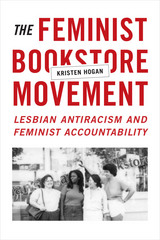 The Feminist Bookstore Movement: Lesbian Antiracism and Feminist Accountability
Kristen Hogan
Duke University Press, 2016 From the 1970s through the 1990s more than one hundred feminist bookstores built a transnational network that helped shape some of feminism's most complex conversations. Kristen Hogan traces the feminist bookstore movement's rise and eventual fall, restoring its radical work to public feminist memory. The bookwomen at the heart of this story—mostly lesbians and including women of color—measured their success not by profit, but by developing theories and practices of lesbian antiracism and feminist accountability. At bookstores like BookWoman in Austin, the Toronto Women’s Bookstore, and Old Wives’ Tales in San Francisco, and in the essential Feminist Bookstore News, bookwomen changed people’s lives and the world. In retelling their stories, Hogan not only shares the movement's tools with contemporary queer antiracist feminist activists and theorists, she gives us a vocabulary, strategy, and legacy for thinking through today's feminisms.
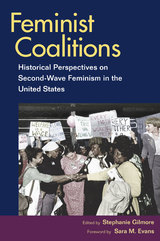 Feminist Coalitions: Historical Perspectives on Second-Wave Feminism in the United States
Edited by Stephanie Gilmore. Foreword by Sara Evans.
University of Illinois Press, 2007 Much of the scholarship on second-wave feminism has focused on divisions within the women's movement and its narrow conception of race and class, but the contributors to this volume remind readers that feminists in the 1960s and 1970s also formed many strong partnerships, often allying themselves with a diverse range of social justice efforts on a local grassroots level. These essays focus on coalitions and alliances in which feminists and other activists joined forces to address crucial social justice issues such as reproductive rights, the peace movement, women's health, Christianity and other religions, and neighborhood activism, as well as alliances crossing boundaries of race, class, political views, and sexual identity. The contributors bring fresh perspectives to feminist history by calling attention to how women struggled to include and represent diverse women without minimizing the difficulties of conceptualizing a singular feminism. Contributors are Maria Bevacqua, Tamar Carroll, Marisa Chappell, Andrea Estepa, Sara M. Evans, Amy Farrell, Stephanie Gilmore, Cynthia Harrison, Elizabeth Kaminski, Wendy Kline, Premilla Nadasen, Caryn Neumann, Anne M. Valk, and Emily Zuckerman.
Feminist Comedy: Women Playwrights of London
Willow White
University of Delaware Press, 2024 Feminist Comedy: Women Playwrights of London identifies the eighteenth-century comedic stage as a key site of feminist critique, practice, and experimentation. While the history of feminism and comedy is undeniably vexed, by focusing on five women playwrights of the latter half of the eighteenth century--Catherine Clive, Frances Brooke, Frances Burney, Hannah Cowley, and Elizabeth Inchbald--this book demonstrates that stage comedy was crucial to these women’s professional success in a male-dominated industry and reveals a unifying thread of feminist critique that connects their works. Though male detractors denied women’s comic ability throughout the era, eighteenth-century women playwrights were on the cutting edge of comedy and their work had important feminist influence that can be traced to today’s stages and screens.
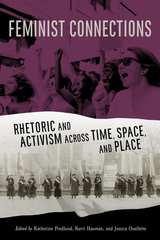 Feminist Connections: Rhetoric and Activism across Time, Space, and Place
Edited by Katherine Fredlund, Kerri Hauman, and Jessica Ouellette
University of Alabama Press, 2020 Highlights feminist rhetorical practices that disrupt and surpass boundaries of time and space
In 1917, Alice Paul and other suffragists famously picketed in front of the White House while holding banners with short, pithy sayings such as “Mr. President: How long must women wait for Liberty?” Their juxtaposition of this short phrase with the image of the White House (a symbol of liberty and justice) relies on the same rhetorical tactics as memes, a genre contemporary feminists use frequently to make arguments about reproductive rights, Black Lives Matter, sex-positivity, and more. Many such connections between feminists of different spaces, places, and eras have yet to be considered, let alone understood. Feminist Connections: Rhetoric and Activism across Time, Space, and Place reconsiders feminist rhetorical strategies as linked, intergenerational, and surprisingly consistent despite the emergence of new forms of media and intersectional considerations.
Contributors to this volume highlight continuities in feminist rhetorical practices that are often invisible to scholars, obscured by time, new media, and wildly different cultural, political, and social contexts. Thus, this collection takes a nonchronological approach to the study of feminist rhetoric, grouping chapters by rhetorical practice rather than time, content, or choice of media.
By connecting historical, contemporary, and future trajectories, this collection develops three feminist rhetorical frameworks: revisionary rhetorics, circulatory rhetorics, and response rhetorics. A theorization of these frameworks explains how feminist rhetorical practices (past and present) rely on similar but diverse methods to create change and fight oppression. Identifying these strategies not only helps us rethink feminist rhetoric from an academic perspective but also allows us to enact feminist activist rhetorics beyond the academy during a time in which feminist scholarship cannot afford to remain behind its hallowed yet insular walls.
 The Feminist Difference: Literature, Psychoanalysis, Race, and Gender
Barbara Johnson
Harvard University Press, 1998 Embattled and belittled, demonized and deemed passé, feminism today seems becalmed without being calm. This is as true in literary criticism as elsewhere in the culture--yet it is in literary criticism that these essays locate the renewed promises, possibilities, and applications of feminist thought. In fresh readings of a wide array of texts--legal, literary, cinematic, philosophical, and psychoanalytical--renowned literary theorist Barbara Johnson demonstrates that the conflicts and uncertainties that beset feminism are signs not of a dead end, but of a creative turning-point.
Employing surprising juxtapositions, The Feminist Difference looks at fiction by black writers from a feminist/psychoanalytic perspective; at poetry from Phillis Wheatley to Baudelaire and Marceline Desbordes-Valmore; and at feminism and law, particularly in the work of Patricia Williams and the late Mary Joe Frug. Toni Morrison and Sigmund Freud, John Keats and Jane Campion, Charlotte Perkins Gilman and Nathaniel Hawthorne, Nella Larson and Heinz Kohut are among the many occasions for Johnson's rich, stimulating, unfailingly close reading of moments at which feminism seems to founder in its own contradictions--moments that re-emerge here as sources of a revitalized critical awareness.
In the final analysis, Johnson argues, literature is essential for feminism because it is the place where impasses can be kept and opened for examination, where questions can be guarded and not forced into a premature validation of the available paradigms. In her book literature appears not as a predetermined set of works but as a mode of cultural work, the work of making readable those impossible and necessary things that cannot yet be spoken.
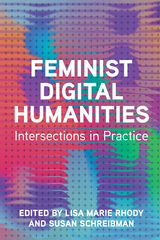 Feminist Digital Humanities: Intersections in Practice
Edited by Lisa Marie Rhody and Susan Schreibman
University of Illinois Press, 2025 Feminist digital humanities offers opportunities for exploring, exposing, and revaluing marginalized forms of knowledge and enacting new processes for creating meaning. Lisa Marie Rhody and Susan Schreibman present essays that explore digital humanities practice as rich terrain for feminist creativity and critique. The editors divide the works into three categories. In the first section, contributors offer readings that demonstrate how feminist thought can be put into operation through digital practice or via analytical approaches, methodologies, and interpretations. A second section structured around infrastructure considers how technologies of knowledge creation, publication, access, and sharing can be formed or reformed through feminist values. The final section focuses on pedagogies and proposes feminist strategies for preparing students to become critical and confident readers with and against technologies. Aimed at readers in and out of the classroom, Feminist Digital Humanities reveals the many ways scholars have pushed beyond critique to practice digital humanities in new ways. Contributors: Daniela Agostinho, Monika Barget, Jenny Bergenmar, Susan Brown, Tanya E Clement, Katrine Dirckinck-Holmfeld, Jaime Lee Kirtz, Cecilia Lindhé, Laura Mandell, Lisa Marie Rhody, Mark Sample, Susan Schreibman, Andie Silva, Nikki L. Stevens, Ravynn K. Stringfield, Dhanashree Thorat, Nanna Bonde Thylstrup, Kristin Veel, Astrid von Rosen, and Jacqueline Wernimont
Feminist Economics Today: Beyond Economic Man
Edited by Marianne A. Ferber and Julie A. Nelson
University of Chicago Press, 2003 The 1993 publication of Marianne A. Ferber and Julie A. Nelson's Beyond Economic Man was a landmark in both feminist scholarship and the discipline of economics, and it quickly became a handbook for those seeking to explore the emerging connections between the two. A decade later, this book looks back at the progress of feminist economics and forward to its future, offering both a thorough overview of feminist economic thought and a collection of new, high-quality work from the field's leading scholars.
Feminist Ethics in Film: Reconfiguring Care through Cinema
Joseph H. Kupfer
Intellect Books, 2012 Popular films can do more than merely entertain us; they can contribute to our understanding of human nature and the ethical theory that informs it. Feminist Ethics in Film explores a varied group of cinematic narratives from the perspective of care-based ethics. The interpersonal relationships they portray disclose important dimensions of care that have been overlooked in less contextualized discussions. In particular, the book examines the relationships between care and community, autonomy, family, and self transformation. Interpreting films from the perspective of the feminist ethics of care both expands our knowledge of this burgeoning area of philosophy and adds depth to our appreciation of the films.
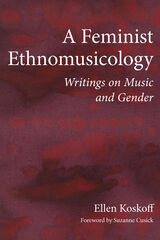 A Feminist Ethnomusicology: Writings on Music and Gender
Ellen Koskoff
University of Illinois Press, 2014 One of the pioneers of gender studies in music, Ellen Koskoff edited the foundational text Women and Music in Cross Cultural Perspective, and her career evolved in tandem with the emergence and development of the field.
In this intellectual memoir, Koskoff describes her journey through the maze of social history and scholarship related to her work examining the intersection of music and gender. Koskoff collects new, revised, and hard-to-find published material from mid-1970s through 2010 to trace the evolution of ethnomusicological thinking about women, gender, and music, offering a perspective of how questions emerged and changed in those years, as well as Koskoff's reassessment of the early years and development of the field. Her goal: a personal map of the different paths to understanding she took over the decades, and how each inspired, informed, and clarified her scholarship. For example, Koskoff shows how a preference for face-to-face interactions with living people served her best in her research, and how her now-classic work within Brooklyn's Hasidic community inflamed her feminist consciousness while leading her into ethnomusicological studies.
An uncommon merging of retrospective and rumination, A Feminist Ethnomusicology: Writings on Music and Gender offers a witty and disarmingly frank tour through the formative decades of the field and will be of interest to ethnomusicologists, anthropologists, scholars of the history and development of feminist thought, and those engaged in fieldwork.
Includes a foreword by Suzanne Cusick framing Koskoff's career and an extensive bibliography provided by the author.
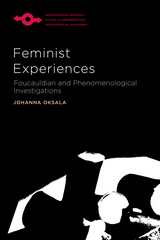 Feminist Experiences: Foucauldian and Phenomenological Investigations
Johanna Oksala
Northwestern University Press, 2016 Feminist Experiences develops and defends a distinctive understanding of feminist philosophy as social critique. Feminist philosophy is essentially a political endeavor, Johanna Oksala argues, aiming to expose, analyze, and ultimately change gendered power relations. However, such an understanding of feminist philosophy raises a host of theoretical problems and paradoxes. Oksala investigates the philosophical challenges and outlines the ontological presuppositions and methodological innovations the project requires.
Drawing on conceptual tools from the thought of Michel Foucault, but also from the tradition of phenomenology, she explores the role of experience in feminist philosophy and its relationship to language and linguistic meaning. Oksala concludes by sketching a feminist ontology of the present through a critical investigation of neoliberalism and the challenges it presents to feminist theory and politics.
Feminist Fabulation: Space/Postmodern Fiction
Marleen S. Barr
University of Iowa Press, 1992 The surprising and controversial thesis of Feminist Fabulation is unflinching: the postmodern canon has systematically excluded a wide range of important women's writing by dismissing it as genre fiction. Marleen Barr issues an urgent call for a corrective, for the recognition of a new meta- or supergenre of contemporary writing--feminist fabulation--which includes both acclaimed mainstream works and works which today's critics consistently ignore.
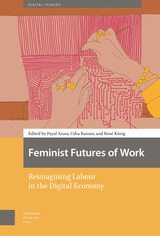 Feminist Futures of Work: Reimagining Labour in the Digital Economy
Payal Arora
Amsterdam University Press, 2023 The future of work is at the centre of debates related to the emerging digital society. Concerns range from the inclusion, equity, and dignity of those at the far end of the value chain, who participate on and off platforms, often in the shadows, invisible to policymakers, designers, and consumers. Precarity and informality characterize this largely female workforce, across sectors ranging from artisanal work to salon services to ride hailing and construction. A feminist reimagining of the futures of work—what we term as “FemWork” —is the need of the day and should manifest in multiple and various forms, placing the worker at the core and drawing on her experiences, aspirations, and realities. This volume offers grounded insights from academic, activist, legal, development and design perspectives that can help us think through these inclusive futures and possibly create digital, social, and governance infrastructures of work that are fairer and more meaningful.
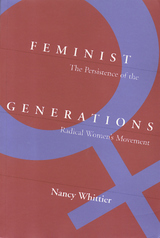 Feminist Generations: The Persistence of the Radical Women's Movement
Nancy Whittier
Temple University Press, 1995 The radical feminist movement has undergone significant transformation over the past four decades—from the direct action of the 1960s and 1970s to the backlash against feminism in the 1980s and 1990s. Drawing on organizational documents and interviews with both veterans of the women's movement and younger feminists in Columbus, Ohio, Nancy Whittier traces the changing definitions of feminism as the movement has evolved. She documents subtle variations in feminist identity and analyzes the striking differences, conflicts, and cooperation between longtime and recent activists. The collective stories of the women—many of them lesbians and lesbian feminists whom the author shows to be central to the women's movement and radical feminism—illustrate that contemporary radical feminism is very much alive. It is sustained through protests, direct action, feminist bookstores, rape crisis centers, and cultural activities like music festivals and writers workshops, which Whittier argues are integral—and political—aspects of the movement's survival. Her analysis includes discussions of a variety of both liberal and radical organizations, including the Women's Action Collective, Women Against Rape, Fan the Flames Bookstore, the Ohio ERA Task Force, and NOW. Unlike many studies of feminist organizing, her study also considers the difference between Columbus, a Midwest, medium-sized city, and feminist activities in major cities like New York, San Francisco, and Chicago, as well as the roles of radical feminists in the development of women's studies departments and other social movements like AIDS education and self-help.
In the series Women in the Political Economy, edited by Ronnie J. Steinberg.
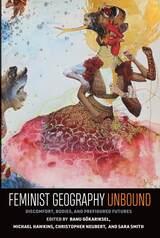 Feminist Geography Unbound: Discomfort, Bodies, and Prefigured Futures
Banu Gokariksel
West Virginia University Press, 2021 A field-defining collection of new voices on gender, feminism, and geography.
Feminist Geography Unbound is a call to action—to expand imaginations and to read and travel more widely and carefully through terrains that have been cast as niche, including Indigenous and decolonial feminisms, Black geographies, and trans geographies. The original essays in this collection center three themes to unbind and enable different feminist futures: discomfort as a site where differences generate both productive and immobilizing frictions, gendered and racialized bodies as sites of political struggle, and the embodied work of building the future.
Drawing on diverse theoretical backgrounds and a range of field sites, contributors consider how race, gender, citizenship, and class often determine who feels comfort and who is tasked with producing it. They work through bodies as terrains of struggle that make claims to space and enact political change, and they ask how these politics prefigure the futures that we fear or desire. The book also champions feminist geography as practice, through interviews with feminist scholars and interludes in which feminist collectives speak to their experience inhabiting and transforming academic spaces. Feminist Geography Unbound is grounded in a feminist geography that has long forced the discipline to grapple with the production of difference, the unequal politics of knowledge production, and gender’s constitutive role in shaping social life.
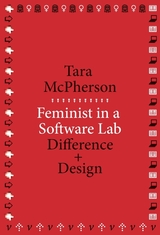 Feminist in a Software Lab: Difference + Design
Tara McPherson
Harvard University Press, 2018 For over a dozen years, the Vectors Lab has experimented with digital scholarship through its online publication, Vectors, and through Scalar, a multimedia authoring platform. The history of this software lab intersects a much longer tale about computation in the humanities, as well as tensions about the role of theory in related projects.
Tara McPherson considers debates around the role of cultural theory within the digital humanities and addresses Gary Hall’s claim that the goals of critical theory and of quantitative or computational analysis may be irreconcilable (or at the very least require “far more time and care”). She then asks what it might mean to design—from conception—digital tools and applications that emerge from contextual concerns of cultural theory and, in particular, from a feminist concern for difference. This path leads back to the Vectors Lab and its ongoing efforts at the intersection of theory and praxis.
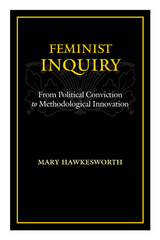 Feminist Inquiry: From Political Conviction to Methodological Innovation
Hawkesworth, Mary
Rutgers University Press, 2006 Over the past three decades, feminist scholars have rocked the foundation of academia by challenging long-established beliefs, contesting dominant research paradigms, and identifying new strategies of analysis. How are we to understand these feminist interventions? Do they capture a truth about race and gender that mainstream scholarship has missed? Do they provide important insights into the politics of knowledge? How do feminist uses of traditional research methods differ from their deployment by nonfeminist scholars? What is distinctive and innovative about feminist research?
Feminist Inquiry provides scholars and students with a comprehensive guide to methodological issues within feminist scholarship. Mary Hawkesworth presents lucid introductions to key philosophical debates about the nature of knowledge, an original account of feminist scholarship’s contributions to these debates, and a sophisticated assessment of the analytical tools that feminist scholars have created to improve understandings of the world. Drawing upon contentious debates concerning the incidence of rape, public support for reproductive rights, affirmative action, and welfare reform, Hawkesworth demonstrates how seemingly abstract questions about the nature of knowledge have palpable effects on the lives of contemporary women and men.
Feminist Inquiry makes epistemological debates—previously the exclusive preserve of philosophers—accessible to a wider audience, and demonstrates the practical and academic importance of these issues.
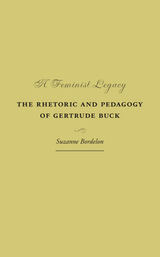 A Feminist Legacy: The Rhetoric and Pedagogy of Gertrude Buck
Suzanne Bordelon
Southern Illinois University Press, 2007 The first book-length investigation of a pioneering English professor and theorist at Vassar College, A Feminist Legacy: The Rhetoric and Pedagogy of Gertrude Buck explores Buck’s contribution to the fields of education and rhetoric during the Progressive Era. By contextualizing Buck’s academic and theoretical work within the rise of women’s educational institutions like Vassar College, the social and political movement toward suffrage, and Buck’s own egalitarian political and social ideals, Suzanne Bordelon offers a scholarly and well-informed treatment of Buck’s achievements that elucidates the historical and contemporary impact of her work and life. Bordelon argues that while Buck did not call herself a feminist, she embodied feminist ideals by demanding the full participation of her female students and by challenging power imbalances at every academic, social, and political level. A Feminist Legacy reveals that Vassar College is an undervalued but significant site in the history of women’s argumentation and pedagogy. Drawing on a rich variety of archival sources, including previously unexamined primary material, A Feminist Legacy traces the beginnings of feminist theories of argumentation and pedagogy and their lasting legacy within the fields of education and rhetoric.
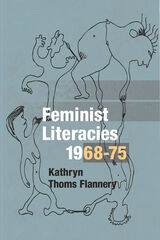 Feminist Literacies, 1968-75
Kathryn Thoms Flannery
University of Illinois Press, 2010 In the late 1960s and early 1970s, ordinary women affiliated with the women's movement were responsible for a veritable explosion of periodicals, poetry, and manifestos, as well as performances designed to support "do-it-yourself" education and consciousness-raising. Kathryn Thoms Flannery discusses this outpouring and the group education, brainstorming, and creative activism it fostered as the manifestation of a feminist literacy quite separate from women's studies programs at universities or the large-scale political workings of second-wave feminism. Seeking to break down traditional barriers such as the dichotomies of writer/reader or student/teacher, these new works also forged polemical alternatives to the forms of argumentation traditionally used to silence women, creating a space for fresh voices. Feminist Literacies explores these truly radical feminist literary practices and pedagogies that flourished during a brief era of volatility and hope.
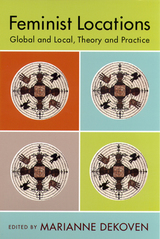 Feminist Locations: Global and Local, Theory and Practice
DeKoven, Marianne
Rutgers University Press, 2001 Contemporary feminist scholarship has done much to challenge the many binary constructions at the heart of Western culture: white/nonwhite, theory/practice, and, most notably, masculine/feminine. Feminist criticism has reshaped these conceptions by breaking them apart and reconfiguring them into intersecting, relational fields of difference. The contributors to this collection look to the future of feminist theory and practice, specifically in terms of their complex relationship with the global and local configurations of postmodernity. In the first part of this book, current feminist theory is assessed for possible future directions. Part two focuses primarily on political issues and part three on questions of the body. Topics include feminist success versus social backlash, global womens human rights, postcolonial feminism, the politics of reproduction, and narratives of womens aging in postmodern culture. Contributors: Karen Barad, Anne C. Bellows, Charlotte Bunch, Nao Bustamante, Elaine K. Chang, Marianne DeKoven, Leela Fernandes, Susan Stanford Friedman, Coco Fusco, Radha S. Hegde, Cheryl Johnson-Odim, E. Ann Kaplan, Debra J. Liebowitz, Rajeswari Sunder Rajan, Cynthia Saltzman, Lynne Segal
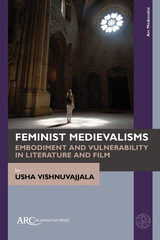 Feminist Medievalisms: Embodiment and Vulnerability in Literature and Film
Usha Vishnuvajjala
Arc Humanities Press, 2024 This book examines feminist textual and cinematic engagements with the idea of the Middle Ages in the nineteenth and twentieth centuries, arguing that the idea of the medieval past is central to the work of novelists and directors interested in embodiment and vulnerability. Careful and illuminating analysis of particular moments in fiction, film, and political discourse dismantles the false binary between popular and intellectual medievalisms, which rests on gendered understandings of genre and audience, while demonstrating that masculinist or patriarchal medievalisms have an equal but understudied counterpart. The book's first three chapters cover Jane Austen’s Northanger Abbey and its afterlives, the final works of Virginia Woolf, and late twentieth-century film and music videos from the United States. The final chapter examines the treatment of women's bodies and vulnerability in both political theory and recent electoral politics, arguing that they share a common thread of misogyny rooted in the idea of the medieval past, and that one way to challenge that misogyny is by looking at complex feminist engagements with that same past, both real and imagined.
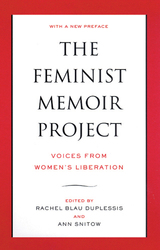 The Feminist Memoir Project: Voices from Women's Liberation
DuPlessis, Rachel B
Rutgers University Press, 2007 The women of The Feminist Memoir Project give voice to the spirit, the drive, and the claims of the Women's Liberation Movement they helped shape, beginning in the late 1960s. These thirty-two writers were among the thousands to jump-start feminism in the late twentieth century. Here, in pieces that are passionate, personal, critical, and witty, they describe what it felt like to make history, to live through and contribute to the massive social movement that transformed the nation.
What made these particular women rebel? And what experiences, ideas, feelings, and beliefs shaped their activism? How did they maintain the will and energy to keep such a struggle going for so long, and continuing still?
Memoirs and responses by Kate Millett, Vivian Gornick, Michele Wallace, Alix Kates Shulman, Joan Nestle, Jo Freeman, Yvonne Rainer, Barbara Smith, Ellen Willis, Eve Ensler, Shirley Geok-lin Lim, Roxanne Dunbar, Naomi Weisstein, Alice Wolfson and many more embody the excitement that fueled the movement and the conflicts that threatened it from within. Their stories trace the ways the world has changed.
Feminist Messages: CODING IN WOMEN'S FOLK CULTURE
Edited by Joan Newlon Radner
University of Illinois Press, 1993 Burning dinners, stitching "scandalous" quilts, talking "hard" in the male dominated world of rap music---Feminist Messages interprets such acts as instances of coding, or covert expressions of subversive or disturbing ideas. While coding may be either deliberated or unconscious, it is a common phenomenon in women's stories, art, and daily routines. Because it is essentially ambiguous, coding protects women from potentially dangerous responses from those who might be troubled by their messages.
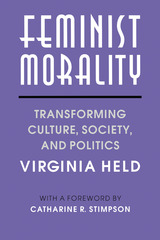 Feminist Morality: Transforming Culture, Society, and Politics
Virginia Held
University of Chicago Press, 1993 How is feminism changing the way women and men think, feel, and act? Virginia Held explores how feminist theory is changing contemporary views of moral choice. She proposes a comprehensive philosophy of feminist ethics, arguing persuasively for reconceptualizations of the self; of relations between the self and others; and of images of birth and death, nurturing and violence. Held shows how social, political, and cultural institutions have traditionally been founded upon masculine ideals of morality. She then identifies a distinct feminist morality that moves beyond culturally embedded notions about motherhood and female emotionality. Examining the effects of this alternative moral and ethical system on changing social values, Held discusses its far-reaching implications for altering standards of freedom, democracy, equality, and personal development. Ultimately, she concludes, the culture of feminism could provide a fresh perspective on—even solutions to—contemporary social problems.
Feminist Morality makes a vital contribution to the ongoing debate in feminist theory on the importance of motherhood. For philosophers and other readers outside feminist theory, it offers a feminist moral and social critique in clear and accessible terms.
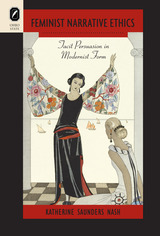 Feminist Narrative Ethics: Tacit Persuasion in Modernist Form
Katherine Saunders Nash
Ohio State University Press, 2014 Feminist Narrative Ethics: Tacit Persuasion in Modernist Form establishes a new theory of narrative ethics by analyzing rhetorical techniques prompt readers of novels to reconsider their ethical convictions about women’s rights. Katherine Saunders Nash proposes four new theoretical paradigms: the ethics of persuasion (Virginia Woolf), of fair play (Dorothy L. Sayers), of distance (E. M. Forster), and of attention (John Cowper Powys). While offering close readings of novels by each author, this book also provides a new, interdisciplinary basis for coordinating feminist and rhetorical theories, history, and narrative technique.
Despite pronouncements by many theorists about the difficulty—even the impossibility—of doing justice in a single study to both history and form, Feminist Narrative Ethics proves that they can be mutually illuminating. Its approach is not only resolutely rhetorical, but resolutely historical as well. It strikes a felicitous balance between history and form that affords new understanding of the implied author concept.
Feminist Narrative Ethics makes a persuasive case for the necessity of locating authorial agency in the implied (rather than the actual) author and cogently explains why rhetorical theory insists on the concept of an implied (rather than an inferred) author. And it proposes a new facet of agency that rhetorical theorists have heretofore neglected: the ethics of progressive revisions to a project in manuscript.
Feminist Organizations: Harvest of the New Women's Movement
edited by Myra Marx Ferree and Patricia Yancey Martin
Temple University Press, 1995 This collection of twenty-six original essays looks at contemporary feminist organizations, how they've survived, the effects of their work, the problems they face, the strategies they develop, and where the women's movement is headed. The contributors, leading feminist scholars from nine social science disciplines, examine a wide variety of local feminist organizations, past and preset, illuminating the struggles of feminist organizers and activists. In the series Women in the Political Economy, edited by Ronnie J. Steinberg.
A Feminist Perspective in the Academy: The Difference It Makes
Edited by Elizabeth Langland and Walter Gove
University of Chicago Press, 1983 The advent of women's studies has brought a feminist perspective into the academy—but has it made a difference there? Has it transformed our curriculum; has it reshaped our materials; has it altered our knowledge?
In the essays collected here, nine distinguished scholars provide an overview of the differences the feminist perspective makes—and could make—in scholarship in the humanities and social sciences. Carefully documented and judiciously critical, these essays inform the reader about developments in feminist scholarship in literary criticism, the performing arts, religion, history, political science, economics, anthropology, psychology, and sociology. The authors point out achievements of lasting value and indicate how these might become an integral part of the various disciplines.
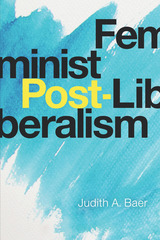 Feminist Post-Liberalism
Judith A. Baer
Temple University Press, 2020 Feminism and liberalism need each other, argues Judith Baer. Her provocative book, Feminist Post-Liberalism, refutes both conservative and radical critiques. To make her case, she rejects classical liberalism in favor of a welfare—and possibly socialist—post-liberalism that will prevent capitalism and a concentration of power that reinforces male supremacy. Together, feminism and liberalism can better elucidate controversies in American politics, law, and society. Baer emphasizes that tolerance and self-examination are virtues, but within both feminist and liberal thought these virtues have been carried to extremes. Feminist theory needs liberalism's respect for reason, while liberal theory needs to incorporate emotion. Liberalism focuses too narrowly on the individual, while feminism needs a dose of individualism. Feminist Post-Liberalism includes anthropological foundations of male dominance to explore topics ranging from crime to cultural appropriation. Baer develops a theory that is true to the principles of both feminist and liberal ideologies.
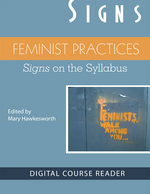 Feminist Practices: Signs on the Syllabus
Edited by Mary Hawkesworth
University of Chicago Press, 2013 A classroom resource for instructors that includes full syllabi and teaching modules, Feminist Practices will be of interest to anyone who teaches in women’s, gender, and sexuality studies. Feminist Practices is intended for use in classrooms and to spark creative ideas for teaching a diverse array of topics.
What makes a practice feminist? What is at stake in claiming the feminist label? Whether within a university context or in larger national and global ones, feminist projects involve challenging established relations of power (critique), envisioning alternative possibilities (theory), and employing activism to change social relations. By taking diverse forms of feminist practice as its focal point, this course reader investigates how to study the complexity of women’s and men’s lives in ways that take race, gender-power, ethnicity, class, and nationality seriously. Feminist Practices also shows how the production of such feminist knowledge challenges long-established beliefs about the world.
Topics covered include
• Gendered labor,
• Commercialization of sexuality and reproduction,
• Love and marriage in the twenty-first century,
• Violence against women,
• Varieties of feminist activism, and
• Women’s leadership and governance.
Feminist Practices draws upon articles published in Signs: Journal of Women in Culture and Society to explore the nature of feminist practices in the twenty-first century and the range of issues these practices address. Organized thematically the collection captures the complexity of a global movement that emerges in the context of local struggles over diverse modes of injustice.
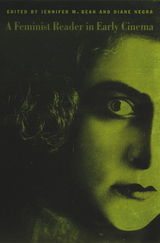 A Feminist Reader in Early Cinema
Jennifer M. Bean and Diane Negra, eds.
Duke University Press, 2002 A Feminist Reader in Early Cinema marks a new era of feminist film scholarship. The twenty essays collected here demonstrate how feminist historiographies at once alter and enrich ongoing debates over visuality and identification, authorship, stardom, and nationalist ideologies in cinema and media studies. Drawing extensively on archival research, the collection yields startling accounts of women's multiple roles as early producers, directors, writers, stars, and viewers. It also engages urgent questions about cinema's capacity for presenting a stable visual field, often at the expense of racially, sexually, or class-marked bodies. While fostering new ways of thinking about film history, A Feminist Reader in Early Cinema illuminates the many questions that the concept of "early cinema" itself raises about the relation of gender to modernism, representation, and technologies of the body. The contributors bring a number of disciplinary frameworks to bear, including not only film studies but also postcolonial studies, dance scholarship, literary analysis, philosophies of the body, and theories regarding modernism and postmodernism. Reflecting the stimulating diversity of early cinematic styles, technologies, and narrative forms, essays address a range of topics—from the dangerous sexuality of the urban flâneuse to the childlike femininity exemplified by Mary Pickford, from the Shanghai film industry to Italian diva films—looking along the way at birth-control sensation films, French crime serials, "war actualities," and the stylistic influence of art deco. Recurring throughout the volume is the protean figure of the New Woman, alternately garbed as childish tomboy, athletic star, enigmatic vamp, languid diva, working girl, kinetic flapper, and primitive exotic. Contributors. Constance Balides, Jennifer M. Bean, Kristine Butler, Mary Ann Doane, Lucy Fischer, Jane Gaines, Amelie Hastie, Sumiko Higashi, Lori Landay, Anne Morey, Diane Negra, Catherine Russell, Siobhan B. Somerville, Shelley Stamp, Gaylyn Studlar, Angela Dalle Vacche, Radha Vatsal, Kristen Whissel, Patricia White, Zhang Zhen
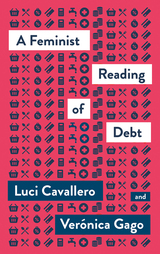 A Feminist Reading of Debt
Luci Cavallero
Pluto Press, 2021 ***Winner of an English PEN Award 2021***
In this sharp intervention, authors Lucí Cavallero and Verónica Gago defiantly develop a feminist understanding of debt, showing its impact on women and members of the LGBTQ+ community and examining the relationship between debt and social reproduction.
Exploring the link between financial activity and the rise of conservative forces in Latin America, the book demonstrates that debt is intimately linked to gendered violence and patriarchal notions of the family. Yet, rather than seeing these forces as insurmountable, the authors also show ways in which debt can be resisted, drawing on concrete experiences and practices from Latin America and around the world.
Featuring interviews with women in Argentina and Brazil, the book reveals the real-life impact of debt and how it falls mainly on the shoulders of women, from the household to the wider effects of national debt and austerity. However, through discussions around experiences of work, prisons, domestic labour, agriculture, family, abortion and housing, a narrative of resistance emerges. Translated by Liz Mason-Deese.
 A Feminist Reading of Debt
Luci Cavallero
Pluto Press, 2021 ***Winner of an English PEN Award 2021***
"Of great value to those interested in the financialisation of everyday life and social reproduction."—LSE Review of Books
In this sharp evaluation and call to action, authors Lucí Cavallero and Verónica Gago defiantly develop a feminist understanding of debt, showing its impact on women and members of the LGBTQ+ community and examining the relationship between debt and social reproduction.
Exploring the link between financial activity and the rise of conservative forces in Latin America, the book demonstrates that debt is intimately linked to gendered violence and patriarchal notions of the family. Yet, rather than seeing these forces as insurmountable, the authors also show ways in which debt can be resisted, drawing on concrete experiences and practices from Latin America and around the world. Chapters include:
*Debt and Social Reproduction
*Debt as a “Counter-revolution” of Everyday Life
*The writing on the Body of Women
*Neither Victims not Entrepreneurs
*Feminist Insubordination and Fascist Neoliberalism
*The Patriarchy Has My Missing Contributions
*Hunger and Gender Mandates
*Us Against Debt
The authors state in their Introduction, “Our investigations and activism show that there is an urgent need to develop a specifically feminist analysis of finance. Here we do so by bringing together methodological elements, political hypotheses, and narratives of practices elaborated by the feminist movement that are challenging finance.”
Featuring interviews with women in Argentina and Brazil, the book reveals the real-life impact of debt and how it falls mainly on the shoulders of women, from the household to the wider effects of national debt and austerity. However, through discussions around experiences of work, prisons, domestic labor, agriculture, family, abortion and housing, a narrative of resistance emerges.
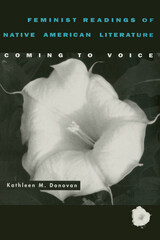 Feminist Readings of Native American Literature: Coming to Voice
Kathleen M. Donovan
University of Arizona Press, 1998 Who in a society can speak, and under what circumstances? These questions are at the heart of both Native American literature and feminist literary and cultural theory. Despite the recent explosion of publication in each of these fields, almost nothing has been written to date that explores the links between the two. With Feminist Readings of Native American Literature, Kathleen Donovan takes an important first step in examining how studies in these two fields inform and influence one another. Focusing on the works of N. Scott Momaday, Joy Harjo, Paula Gunn Allen, and others, Donovan analyzes the texts of these well-known writers, weaving a supporting web of feminist criticism throughout. With careful and gracefully offered insights, the book explores the reciprocally illuminating nature of culture and gender issues.
The author demonstrates how Canadian women of mixed-blood ancestry achieve a voice through autobiographies and autobiographical novels. Using a framework of feminist reader response theory, she considers an underlying misogyny in the writings of N. Scott Momaday. And in examining commonalities between specific cultures, she discusses how two women of color, Paula Gunn Allen and Toni Morrison, explore representations of femaleness in their respective cultures. By synthesizing a broad spectrum of critical writing that overlaps women's voices and Native American literature, Donovan expands on the frame of dialogue within feminist literary and cultural theory. Drawing on the related fields of ethnography, ethnopoetics, ecofeminism, and post-colonialism, Feminist Readings of Native American Literature offers the first systematic study of the intersection between two dynamic arenas in literary studies today.
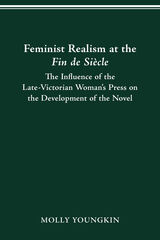 FEMINIST REALISM AT THE FIN DE SIÈCLE: The Influence of the Late-Victorian Woman’s Press on the Development of the Novel
Molly Youngkin
Ohio State University Press, 2007 Molly Youngkin takes on a major literary problem of the turn-of-the-century: Was the transition from the Victorian novel to the modern novel enabled by antirealist or realist narrative strategies? To answer this question, Youngkin analyzes book reviews that appeared in two prominent feminist periodicals circulated during the late-Victorian era—Shafts and The Woman’s Herald. Through reviews of the works of important male and female authors of the decade—Thomas Hardy, Sarah Grand, George Gissing, Mona Caird, George Meredith, Ménie Dowie, George Moore, and Henrietta Stannard—these periodicals developed a feminist realist aesthetic that drew on three aspects of woman’s agency (consciousness, spoken word, and action) and emphasized corresponding narrative strategies (internal perspective, dialogue, and description of characters’ actions). Still, these periodicals privileged consciousness over spoken word and action and, by doing so, encouraged authors to push the boundaries of traditional realism and anticipate the modernist aesthetic. By acknowledging the role of the woman’s press in the development of the novel, this book revises our understanding of the transition from Victorianism to modernism, which often is characterized as antirealist. Late-Victorian authors working within the realist tradition also contributed to this transition, particularly through their engagement with feminist realism. Youngkin deftly illustrates this transition and in so doing proves that it cannot be attributed to antirealist narrative strategies alone.
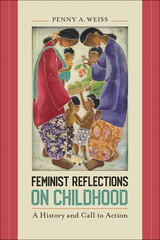 Feminist Reflections on Childhood: A History and Call to Action
Penny A. Weiss
Temple University Press, 2021 In Feminist Reflections on Childhood, Penny Weiss rediscovers the radically feminist tradition of advocating for the liberatory treatment of youth. Weiss looks at both historical and contemporary feminists to understand what issues surrounding the inequality experienced by both women and children were important to the authors as feminist activists and thinkers. She uses the writings of Mary Wollstonecraft, Elizabeth Cady Stanton, and Simone de Beauvoir to show early feminist arguments for the improved status and treatment of youth. Weiss also shows how Charlotte Perkins Gilman, a socialist feminist, and Emma Goldman, an anarchist feminist, differently understood and re-visioned children’s lives, as well as how children continue to show up on feminist agendas and in manifestos that demand better conditions for children’s lives. Moving to contemporary theory, Feminist Reflections on Childhood also looks at how feminist disability theory is well-positioned to recognize the voices of children, and how queer theory provides lessons on contemporary trends that provide visions and strategies for more constructive adult-child relations. Weiss, who includes her own experiences as a mother and foster mother throughout the book, closes her distinctively feminist takes on childhood with a consideration of speculative fiction stories that offer examples of what feminists think makes childhood (un)livable.
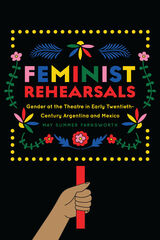 Feminist Rehearsals: Gender at the Theatre in Early Twentieth-Century Argentina and Mexico
May Summer Farnsworth
University of Iowa Press, 2023 2024 ATHE Outstanding Book Award, Shortlisted
2023 George Freedley Memorial Award, Finalist
As feminism gained prominence in twentieth-century popular culture, dramatic conventions progressed accordingly, offering larger and more diverse roles for women characters. Feminist Rehearsals documents the early stages of feminist theatre in Argentina and Mexico, revealing how various aspects of performance culture—spectator formation, playwriting, professional acting and directing, and dramatic techniques—paralleled political activism and championed the goals of the women’s rights movement. Through performance and protest, feminists enacted new identities and pushed for myriad social and legislative reforms during a time when women were denied suffrage and full citizenship status. Together, feminist theatre and demonstrations politicized women spectators’ collective presence and promoted women’s rights in the public sphere.
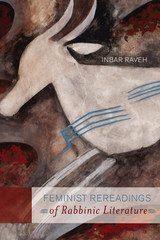 Feminist Rereadings of Rabbinic Literature
Inbar Raveh
Brandeis University Press, 2014 This book offers a fresh perspective on classical Jewish literature by providing a gender-based, feminist reading of rabbinical anecdotes and legends. Viewing rabbinical legends as sources that generate perceptions about women and gender, Inbar Raveh provides answers to questions such as how the Sages viewed women; how they formed and molded their characterization of them; how they constructed the ancient discourse on femininity; and what the status of women was in their society. Raveh also re-creates the voices and stories of the women themselves within their sociohistorical context, moving them from the periphery to the center and exposing how men maintain power. Chapter topics include desire and control, pain, midwives, prostitutes, and myth. A major contribution to the fields of literary criticism and Jewish studies, Raveh’s book demonstrates the possibility of appreciating the aesthetic beauty and complexity of patriarchal texts, while at the same time recognizing their limitations.
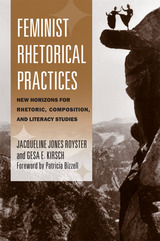 Feminist Rhetorical Practices: New Horizons for Rhetoric, Composition, and Literacy Studies
Jacqueline Jones Royster and Gesa E. Kirsch
Southern Illinois University Press, 2012 From two leading scholars in the field comes this landmark assessment of the shifting terrain of feminist rhetorical practices in recent decades. Jacqueline Jones Royster and Gesa E. Kirsch contend the field of rhetorical studies is being transformed through the work of feminist rhetoricians who have brought about notable changes in who the subjects of rhetorical study can be, how their practices can be critiqued, and how the effectiveness and value of the inquiry frameworks can be articulated. To contextualize a new and changed landscape for narratives in the history of rhetoric, Royster and Kirsch present four critical terms of engagement—critical imagination, strategic contemplation, social circulation, and globalization—as the foundation for a new analytical model for understanding, interpreting, and evaluating feminist rhetorical inquiry and the study and teaching of rhetoric in general. This model draws directly on the wealth of knowledge and understanding gained from feminist rhetorical practices, especially sensitivity toward meaningfully and respectfully rendering the work, lives, cultures, and traditions of historical and contemporary women in rhetorical scholarship. Proposing ambitious new standards for viewing and valuing excellence in feminist rhetorical practice, Royster and Kirsch advocate an ethos of respect and humility in the analysis of communities and specific rhetorical performances neglected in rhetorical history, recasting rhetorical studies as a global phenomenon rather than a western one. They also reflect on their own personal and professional development as researchers as they highlight innovative feminist research over the past thirty years to articulate how feminist work is changing the field and pointing to the active participation of women in various discourse arenas and to the practices and genres they use. Valuable to new and established scholars of rhetoric, Feminist Rhetorical Practice: New Horizons for Rhetoric, Composition, and Literacy Studies is essential for understanding the theoretical, methodological, and ethical impacts of feminist rhetorical studies on the wider field.
Winner, 2014 Winifred Bryan Horner Outstanding Book Award
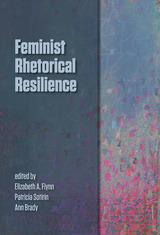 Feminist Rhetorical Resilience
Elizabeth A. Flynn, Patricia Sotirin, and Ann Brady
Utah State University Press, 2012 Although it is well known in other fields, the concept of “resilience” has not been addressed explicitly by feminist rhetoricians. This collection develops it in readings of rhetorical situations across a range of social contexts and national cultures. Contributors demonstrate that resilience offers an important new conceptual frame for feminist rhetoric, with emphasis on agency, change, and hope in the daily lives of individuals or groups of individuals disempowered by social or material forces. Collectively, these chapters create a robust conception of resilience as a complex rhetorical process, redeeming it from its popular association with individual heroism through an important focus on relationality, community, and an ethics of connection. Resilience, in this volume, is a specifically rhetorical response to complicated forces in individual lives. Through it, Feminist Rhetorical Resilience widens the interpretive space within which rhetoricians can work.
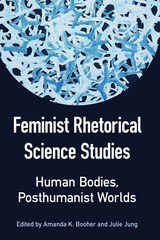 Feminist Rhetorical Science Studies: Human Bodies, Posthumanist Worlds
Edited by Amanda K. Booher and Julie Jung
Southern Illinois University Press, 2018 This edited collection disrupts tendencies in feminist science studies to dismiss rhetoric as having concern only for language, and it counters posthumanist theories that ignore human materialities and asymmetries of power as co-constituted with and through distinctions such as gender, sex, race, and ability. The eight essays of Feminist Rhetorical Science Studies: Human Bodies, Posthumanist Worlds model methodologies for doing feminist research in the rhetoric of science. Collectively they build innovative interdisciplinary bridges across the related but divergent fields of feminism, posthumanism, new materialism, and the rhetoric of science.
Each essay addresses a question: How can feminist rhetoricians of science engage responsibly with emerging theories of the posthuman? Some contributors respond with case studies in medical practice (fetal ultrasound; patient noncompliance), medical science (the neuroscience of sex differences), and health policy (drug trials of the U.S. Food and Drug Administration); others respond with a critical review of object-oriented ontology and a framework for researching women technical writers in the workplace. The contributed essays are in turn framed by a comprehensive introduction and a final chapter from the editors, who argue that a key contribution of feminist posthumanist rhetoric is that it rethinks the agencies of people, things, and practices in ways that can bring about more ethical human relations.
Individually the contributions offer as much variety as consensus on matters of methodology. Together they demonstrate how feminist posthumanist and materialist approaches to science expand our notions of what rhetoric is and does, yet they manage to do so without sacrificing what makes their inquiries distinctively rhetorical.
 Feminist Sociology: Life Histories of a Movement
Edited by Barbara Laslett and Barrie Thorne
Rutgers University Press, 1997 This collection of thirteen life stories recaptures the history of a political and intellectual movement that created feminist sociology as a field of inquiry. As the editors' introduction notes, the life history is a crucial tool for sociological thought. Life histories can be a bridge between individual experience and codified knowledge, between human agency and social structure. Life histories can enhance social theory by revealing categories of meaning usually submerged in the conventions of social science. The authors in this volume, all sociologists who have had great impact upon the field in which they write, show how personal relationships, experiences of inequality, and professional conflict and camaraderie interweave with the formation of social theory, political movements, and intellectual thought. The book makes a powerful impression upon anyone who has struggled with the relationship between social theory and everyday life. -- Accessible, lively articles that combine personal narrative with sociological theory. -- Contributors are some of the leading voices in feminist sociology.
Feminist Solutions for Ending War
Megan MacKenzie
Pluto Press, 2021 ‘War is a man’s game,’ or so goes the saying. Whether this is true or not, patriarchal capitalism is certainly one of the driving forces behind war in the modern era. So can we end war with feminism? This book argues that this is possible, and is in fact already happening.
Each chapter provides a solution to war using innovative examples of how feminist and queer theory and practice inform pacifist treaties, movements and methods, from the international to the domestic spheres. Chapters propose a range of solutions that include arms abolition, centering Indigenous knowledge, economic restructuring, and transforming how we ‘count’ civilian deaths.
Ending war requires challenging complex structures, but the solutions found in this edition have risen to this challenge. By thinking beyond the violence of the capitalist patriarchy, this book makes the powerful case that the possibility of life without war is real.
The Feminist Spectator as Critic
Jill Dolan
University of Michigan Press, 2012 The Feminist Spectator as Criticbroke new ground as one of the pioneering books on feminist spectatorship, encouraging resistant readings to generate feminist meanings in performance. Approaching live spectatorship through a range of interdisciplinary methods, the book has been foundational in theater studies, performance studies, and gender/sexuality/women's studies. This updated and enlarged second edition celebrates the book's twenty-fifth anniversary with a substantial new introduction and up-to-the-moment bibliography, detailing the progress to date in gender equity in theater and the arts, and suggesting how far we have yet to go.
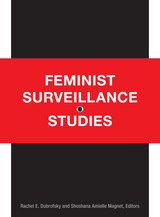 Feminist Surveillance Studies
Rachel E. Dubrofsky and Soshana Amielle Magnet, eds.
Duke University Press, 2015 Questions of gender, race, class, and sexuality have largely been left unexamined in surveillance studies. The contributors to this field-defining collection take up these questions, and in so doing provide new directions for analyzing surveillance. They use feminist theory to expose the ways in which surveillance practices and technologies are tied to systemic forms of discrimination that serve to normalize whiteness, able-bodiedness, capitalism, and heterosexuality. The essays discuss the implications of, among others, patriarchal surveillance in colonial North America, surveillance aimed at curbing the trafficking of women and sex work, women presented as having agency in the creation of the images that display their bodies via social media, full-body airport scanners, and mainstream news media discussion of honor killings in Canada and the concomitant surveillance of Muslim bodies. Rather than rehashing arguments as to whether or not surveillance keeps the state safe, the contributors investigate what constitutes surveillance, who is scrutinized, why, and at what cost. The work fills a gap in feminist scholarship and shows that gender, race, class, and sexuality should be central to any study of surveillance.
Contributors. Seantel Anaïs, Mark Andrejevic, Paisley Currah, Sayantani DasGupta, Shamita Das Dasgupta, Rachel E. Dubrofsky, Rachel Hall, Lisa Jean Moore, Yasmin Jiwani, Ummni Khan, Shoshana Amielle Magnet, Kelli Moore, Lisa Nakamura, Dorothy Roberts, Andrea Smith, Kevin Walby, Megan M. Wood, Laura Hyun Yi Kang
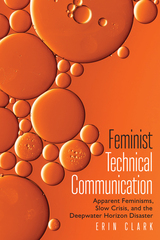 Feminist Technical Communication: Apparent Feminisms, Slow Crisis, and the Deepwater Horizon Disaster
Erin Clark
Utah State University Press, 2023 Feminist Technical Communication introduces readers to technical communication methodology, demonstrating how rhetorical feminist approaches are vital to the future of technical communication. Using an intersectional and transcultural approach, Erin Clark fuses the well-documented surge of work in feminist technical communication throughout the 1990s with the larger social justice turn in the discipline.
The first book to situate feminisms and technical communication in relationship as the focal point, Feminist Technical Communication traces the thread of feminisms through technical communication’s connection to social justice studies. Clark theorizes “slow crisis,” a concept made readable to technical communicators by apparent feminisms that can help technical communicators readily recognize and address social justice problems. Clark then applies this framework to the Deepwater Horizon Disaster, an extended crisis that has been publicly framed by a traditional view of efficiency that privileges economic impact. Through rich description of apparent feminist information-gathering techniques and a layered analysis this study offers application far beyond this single disaster, making available new crisis-response possibilities that consider the economy without eliding ecological and human health concerns.
Feminist Technical Communication offers a methodological approach to the systematic interrogation of power structures that operate on hidden misogynies. This book is useful to technical communicators, scholars of technical communication and rhetoric, and readers interested in gender studies and public health and is an ideal text for graduate-level seminars focused on feminisms, social justice, and cultural studies.
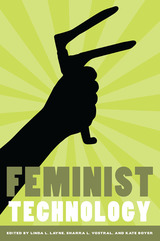 Feminist Technology
Edited by Linda L. Layne, Sharra L. Vostral, and Kate Boyer
University of Illinois Press, 2010 Is there such a thing as a "feminist technology"? If so, what makes a technology feminist? Is it in the design process, in the thing itself, in the way it is marketed, or in the way it is used by women (or by men)? In this collection, feminist scholars trained in diverse fields consider these questions by examining a range of products, tools, and technologies that were specifically designed for and marketed to women. Evaluating the claims that such products are liberating for women, the contributors focus on case studies of menstrual-suppressing birth control pills, home pregnancy tests, tampons, breast pumps, Norplant, anti-fertility vaccines, and microbicides. In examining these various products, this volume explores ways of actively intervening to develop better tools for designing, promoting, and evaluating feminist technologies. Recognizing the different needs and desires of women and acknowledging the multiplicity of feminist approaches, Feminist Technology offers a sustained debate on existing and emergent technologies that share the goal of improving women's lives. Contributors are Jennifer Aengst, Maia Boswell-Penc, Kate Boyer, Frances Bronet, Shirley Gorenstein, Anita Hardon, Deborah G. Johnson, Linda L. Layne, Deana McDonagh, and Sharra L. Vostral.
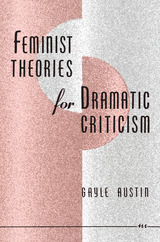 Feminist Theories for Dramatic Criticism
Gayle Austin
University of Michigan Press, 1990 Feminist Theories for Dramatic Criticism provides a number of useful approaches for analyzing works for the stage from a feminist perspective. Each chapter outlines key feminist theories in a specific field, covering literary criticisms, anthropology, psychology, and film, and then applies these theories in a detailed criticism of one or two plays. Plays by Eugene O'Neill, Arthur Miller, Lillian Hellman, Jane Bowles, Sam Shepard, and Alice Childress—all produced after World War II—are reexamined through the lenses of feminist theorist Judith Fetterley, Gayle Rubin, Nancy Chodorow, and Laura Mulvey, each a key figure in her respective field. The introduction provides a framework for the discussion of feminist dramatic criticism by presenting the multiple political perspectives within feminism. The contributions of black and lesbian feminists to the question of theory are explored, as are the evolutionary stages of feminist criticism as they have been occurring in other fields. Theater has been slower than most fields to move through these stages, and its trajectory thus far is briefly traced. For the sake of clarity, each of the central chapters treats theories from a particular discipline, but the conclusion reminds us that in practice the theories are most often combined. The book will appeal to theater scholars and practitioners interested in finding their way into feminist theory for the first time, or in expanding their knowledge of its insights for use in teaching, research, and production. Those in women's studies and other fields will find it shows ways to include plays among the texts they analyze.
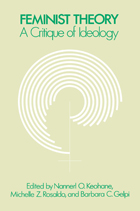 Feminist Theory: A Critique of Ideology
Edited by Nannerl Keohane, Michelle Z. Rosaldo, and Barbara C. Gelpi
University of Chicago Press, 1982 "A crucial task for feminst scholars," wrote Michelle Rosaldo over two years ago in Signs, "emerges, then, not as the relatively limited one of documenting pervasive sexism as a social fact–or showing how we can now hope to change or have in the past been able to survive it. Instead, it seems that we are challenged to provide new ways of linking the particulars of women's lives, activities, and goals to inequalities wherever they exist."
Feminist Theory: A Critique of Ideology meets that challenge. Collected from several issues of Signs–Journal of Women in Culture and Society, these essays explore the relationships between objectivity and masculinity, between psychology and political theory, and between family and state. In pursuing these critical explorations, the contributors–liberal, Marxist, socialist, and radical feminists–examine the foundations of power, of sexuality, of language, and of scientific thought.
Feminist Theory and the Frankfurt School, Volume 17
Wendy Brown
Duke University Press This special issue of differences explores what light Frankfurt School critical theory can shed on contemporary problematics in feminist theory. In contrast to the relatively extensive employment of the work of Jürgen Habermas for this purpose, this special issue focuses on other major thinkers of the Frankfurt School, especially Horkheimer, Adorno, and Benjamin.
Feminist Theory and the Study of Folklore
Edited by Susan Tower Hollis, Linda Pershing, and M. Jane Young
University of Illinois Press, 1994 Taking a performance-centered perspective on folklore, contributors to this volume challenge patriarchal assumptions of the past and rethink old topics from a feminist perspective while opening new areas of research. In eighteen chapters the book covers girls' games, political cartoons, quilting, Pentecostal preachers, daily housework, Egyptian goddesses, tall tales, and birth. This hallmark collection of feminist folklore will be a valuable resource for scholars and other interested readers.
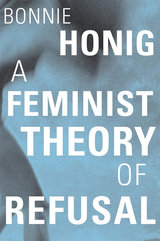 A Feminist Theory of Refusal
Bonnie Honig
Harvard University Press, 2021 An acclaimed political theorist offers a fresh, interdisciplinary analysis of the politics of refusal, highlighting the promise of a feminist politics that does not simply withdraw from the status quo but also transforms it.
The Bacchae, Euripides’s fifth-century tragedy, famously depicts the wine god Dionysus and the women who follow him as indolent, drunken, mad. But Bonnie Honig sees the women differently. They reject work, not out of laziness, but because they have had enough of women’s routine obedience. Later they escape prison, leave the city of Thebes, explore alternative lifestyles, kill the king, and then return to claim the city. Their “arc of refusal,” Honig argues, can inspire a new feminist politics of refusal.
Refusal, the withdrawal from unjust political and economic systems, is a key theme in political philosophy. Its best-known literary avatar is Herman Melville’s Bartleby, whose response to every request is, “I prefer not to.” A feminist politics of refusal, by contrast, cannot simply decline to participate in the machinations of power. Honig argues that a feminist refusal aims at transformation and, ultimately, self-governance. Withdrawal is a first step, not the end game.
Rethinking the concepts of refusal in the work of Giorgio Agamben, Adriana Cavarero, and Saidiya Hartman, Honig places collective efforts toward self-governance at refusal’s core and, in doing so, invigorates discourse on civil and uncivil disobedience. She seeks new protagonists in film, art, and in historical and fictional figures including Sophocles’s Antigone, Ovid’s Procne, Charlie Chaplin’s Tramp, Leonardo da Vinci’s Madonna, and Muhammad Ali. Rather than decline the corruptions of politics, these agents of refusal join the women of Thebes first in saying no and then in risking to undertake transformative action.
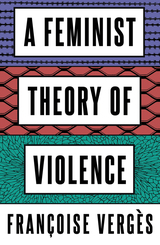 A Feminist Theory of Violence: A Decolonial Perspective
Françoise Vergès
Pluto Press, 2022 'A robust, decolonial challenge to carceral feminism' - Angela Y. Davis
***Winner of an English PEN Award 2022***
The mainstream conversation surrounding gender equality is a repertoire of violence: harassment, rape, abuse, femicide. These words suggest a cruel reality. But they also hide another reality: that of gendered violence committed with the complicity of the State.
In this book, Françoise Vergès denounces the carceral turn in the fight against sexism. By focusing on 'violent men', we fail to question the sources of their violence. There is no doubt as to the underlying causes: racial capitalism, ultra-conservative populism, the crushing of the Global South by wars and imperialist looting, the exile of millions and the proliferation of prisons - these all put masculinity in the service of a policy of death.
Against the spirit of the times, Françoise Vergès refuses the punitive obsession of the State in favour of restorative justice.
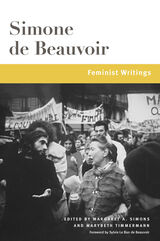 Feminist Writings
Simone de Beauvoir; Edited by Margaret A. Simons and Marybeth Timmermann; Foreword by Sylvie Le Bon de Beauvoir
University of Illinois Press, 2015 The philosopher's writings on, and engagement with, twentieth century feminism By turns surprising and revelatory, this sixth volume in the Beauvoir Series presents newly discovered writings and lectures while providing new translations and contexts for Simone de Beauvoir's more familiar writings. Spanning Beauvoir's career from the 1940s through 1986, the pieces explain the paradoxes in her political and feminist stances, including her famous 1972 announcement of a "conversion to feminism" after decades of activism on behalf of women. Feminist Writings documents and contextualizes Beauvoir's thinking, writing, public statements, and activities in the services of causes like French divorce law reform and the rights of women in the Iranian Revolution. In addition, the volume provides new insights into Beauvoir's complex thinking and illuminates her historic role in linking the movements for sexual freedom, sexual equality, homosexual rights, and women's rights in France.
Feminists Who Changed America, 1963-1975
Edited by Barbara J. Love: Foreword by Nancy F. Cott
University of Illinois Press, 2006 Documenting key feminists who ignited the second wave women's movement Barbara J. Love’s Feminists Who Changed America, 1963-1975 will be the first comprehensive directory to document many of the founders and leaders (including both well-known and grassroots organizers) of the second wave women's movement. It tells the stories of more than two thousand individual women and a few notable men who together reignited the women's movement and made permanent changes to entrenched customs and laws. The biographical entries on these pioneering feminists represent their many factions, all parts of the country, all races and ethnic groups, and all political ideologies. Nancy Cott's foreword discusses the movement in relation to the earlier first wave and presents a brief overview of the second wave in the context of other contemporaneous social movements.
 The Feminization of Famine: Expressions of the Inexpressible?
Margaret Kelleher
Duke University Press, 1997 Contemporary depictions of famine and disaster are dominated by female images. The Feminization of Famine examines these representations, exploring, in particular, the literature arising from the Irish "Great Famine" of the 1840s and the Bengali famine of the 1940s. Kelleher illuminates recurring motifs: the prevalence of mother and child images, the scrutiny of women’s starved bodies, and the reliance on the female figure to express the largely "inexpressible" reality of famine. Questioning what gives these particularly feminine images their affective power and analyzing the responses they generate, this historical critique reveals striking parallels between these two "great" famines and current representations of similar natural disasters and catastrophes.
Kelleher begins with a critical reading of the novels and short stories written about the Irish famine over the last 150 years, from the novels of William Carleton and Anthony Trollope to the writings of Liam O’Flaherty and John Banville. She then moves on to unveil a lesser-known body of literature—works written by women. This literature is read in the context of a rich variety of other sources, including eye-witness accounts, memoirs, journalistic accounts, and famine historiography. Concluding with a reading of the twentieth-century accounts of the famine in Bengal, this book reveals how gendered representations have played a crucial role in defining notions of famine.
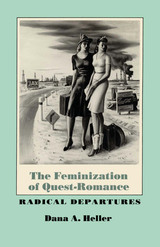 The Feminization of Quest-Romance: Radical Departures
By Dana A. Heller
University of Texas Press, 1990 What happens when a woman dares to imagine herself a hero? Questing, she sets out for unknown regions. Lighting a torch, she elicits from the darkness stories never told or heard before. The woman hero sails against the tides of great legends that recount the adventures of heroic men, legends deemed universal, timeless, and essential to our understanding of the natural order that holds us and completes us in its spiral. Yet these myths and rituals do not fulfill her need for an empowering self-image nor do they grant her the mobility she requires to imagine, enact, and represent her quest for authentic self-knowledge. The Feminization of Quest-Romance proposes that a female quest is a revolutionary step in both literary and cultural terms. Indeed, despite the difficulty that women writers face in challenging myths, rituals, psychological theories, and literary conventions deemed universal by a culture that exalts masculine ideals and universalizes male experience, a number of revolutionary texts have come into existence in the second half of the twentieth century by such American women writers as Jean Stafford, Mary McCarthy, Anne Moody, Marilynne Robinson, and Mona Simpson, all of them working to redefine the literary portrayal of American women's quests. They work, in part, by presenting questing female characters who refuse to accept the roles accorded them by restrictive social norms, even if it means sacrificing themselves in the name of rebellion. In later texts, female heroes survive their "lighting out" experiences to explore diverse alternatives to the limiting roles that have circumscribed female development. This study of The Mountain Lion, Memories of a Catholic Girlhood, Coming of Age in Mississippi, Housekeeping, and Anywhere but Here identifies transformations of the quest-romance that support a viable theory of female development and offer literary patterns that challenge the male monopoly on transformative knowledge and heroic action.
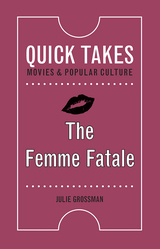 The Femme Fatale
Julie Grossman
Rutgers University Press, 2020 Ostensibly the villain, but also a model of female power, poise, and intelligence, the femme fatale embodies Hollywood’s contradictory attitudes toward ambitious women. But how has the figure of the femme fatale evolved over time, and to what extent have these changes reflected shifting cultural attitudes toward female independence and sexuality?
This book offers readers a concise look at over a century of femmes fatales on both the silver screen and the TV screen. Starting with ethnically exoticized silent film vamps like Theda Bara and Pola Negri, it examines classic film noir femmes fatales like Barbara Stanwyck in Double Indemnity, as well as postmodern revisions of the archetype in films like Basic Instinct and Memento. Finally, it explores how contemporary film and television creators like Fleabag and Killing Eve’s Phoebe Waller-Bridge have appropriated the femme fatale in sympathetic and surprising ways.
Analyzing not only the films themselves, but also studio press kits and reviews, The Femme Fatale considers how discourses about the pleasures and dangers of female performance are projected onto the figure of the femme fatale. Ultimately, it is a celebration of how “bad girl” roles have provided some of Hollywood’s most talented actresses opportunities to fully express their on-screen charisma.
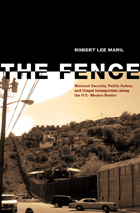 The Fence: National Security, Public Safety, and Illegal Immigration along the U.S.–Mexico Border
Robert Lee Maril
Texas Tech University Press, 2011 To the American public it’s a 2,000-mile-long project to keep illegal immigrants, narcotics, and terrorists on the other side of the U.S.–Mexico border. In the deserts of Arizona, it’s a “virtual fence” of high-tech electronic sensors, cameras, and radar. In some border stretches it’s a huge concrete-and-steel wall; in others it’s a series of solitary posts designed to stop drug runners; in still others it’s rusted barbed-wire cattle fences. For two-thirds of the international boundary it’s nonexistent. Just what is this entity known as “the fence”? And more important, is it working? Through first-person interviews with defense contractors, border residents, American military, Minutemen, county officials, Customs and Border Protection agents, environmental activists, and others whose voices have never been heard, Robert Lee Maril examines the project’s human and financial costs. Along with Maril’s site visits, his rigorous analysis of government documents from 1999 to the present uncovers fiscal mismanagement by Congress, wasteful defense contracts, and unkept political promises. As drug violence mounts in border cities and increasing numbers of illegal migrants die from heat exhaustion in the Arizona desert, Maril argues how the fence may even be making an incendiary situation worse. Avoiding preconceived conclusions, he proposes new public policies that take into consideration human issues, political negotiation, and the need for compromise. Maril’s lucid study shows the fence to be a symbol in concrete, steel, microchips, and fiber optics for the crucible of contemporary immigration policy, national security, and public safety.
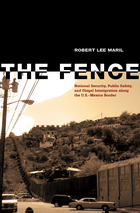 The Fence: National Security, Public Safety, and Illegal Immigration along the U.S.–Mexico Border
Robert Lee Maril
Texas Tech University Press, 2012 To the American public it’s a 2,000-mile-long project to keep illegal immigrants, narcotics, and terrorists on the other side of the U.S.–Mexico border. In the deserts of Arizona, it’s a “virtual fence” of high-tech electronic sensors, cameras, and radar. In some border stretches it’s a huge concrete-and-steel wall; in others it’s a series of solitary posts designed to stop drug runners; in still others it’s rusted barbed-wire cattle fences. For two-thirds of the international boundary it’s nonexistent. Just what is this entity known as “the fence”? And more important, is it working? Through first-person interviews with defense contractors, border residents, American military, Minutemen, county officials, Customs and Border Protection agents, environmental activists, and others whose voices have never been heard, Robert Lee Maril examines the project’s human and financial costs. Along with Maril’s site visits, his rigorous analysis of government documents from 1999 to the present uncovers fiscal mismanagement by Congress, wasteful defense contracts, and unkept political promises. As drug violence mounts in border cities and increasing numbers of illegal migrants die from heat exhaustion in the Arizona desert, Maril argues how the fence may even be making an incendiary situation worse. Avoiding preconceived conclusions, he proposes new public policies that take into consideration human issues, political negotiation, and the need for compromise. Maril’s lucid study shows the fence to be a symbol in concrete, steel, microchips, and fiber optics for the crucible of contemporary immigration policy, national security, and public safety.
 Fenced Off: The Suburbanization of American Politics
Juliet F. Gainsborough
Georgetown University Press, 2001 Since the 1980s a distinctive suburban politics has emerged in the United States, Juliet F. Gainsborough argues in Fenced Off . As suburbs have become less economically and socially dependent on the central cities, suburban and urban dwellers have diverged not only in their voting patterns but also in their thinking about national politics. While political reporters have long noted this difference, few quantitative studies have been conducted on suburbanization alone—above and beyond race or class—as a political trend. Using census and public opinion statistics, along with data on congressional districts and party platforms, Gainsborough demonstrates that this "ideology of localism" weakens when suburbs experience city-like problems and strengthens when racial and economic differences with the nearby city increase. In addition, Gainsborough uses national survey data from the 1950s to the 1990s to show that a separate suburban politics has arisen only during the last two decades. Further, she argues, the political differences between urban and suburban voters have found expression in changes in congressional representation and new electoral strategies for the major political parties. As Congressional districts become increasingly suburban, "soccer moms" and liveability agendas come to dominate party platforms, and the needs of the urban poor disappear from political debate. Fenced Off uses the tools of political science to prove what political commentators have sensed—that the suburbs offer a powerful voting bloc that is being courted with sophisticated new strategies.
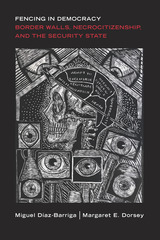 Fencing in Democracy: Border Walls, Necrocitizenship, and the Security State
Miguel Díaz-Barriga and Margaret Dorsey
Duke University Press, 2019 Border walls permeate our world, with more than thirty nation-states constructing them. Anthropologists Margaret E. Dorsey and Miguel Díaz-Barriga argue that border wall construction manifests transformations in citizenship practices that are aimed not only at keeping migrants out but also at enmeshing citizens into a wider politics of exclusion. For a decade, the authors studied the U.S.-Mexico border wall constructed by the Department of Homeland Security and observed the political protests and legal challenges that residents mounted in opposition to the wall. In Fencing in Democracy Dorsey and Díaz-Barriga take us to those border communities most affected by the wall and often ignored in national discussions about border security to highlight how the state diminishes citizens' rights. That dynamic speaks to the citizenship experiences of border residents that is indicative of how walls imprison the populations they are built to protect. Dorsey and Díaz-Barriga brilliantly expand conversations about citizenship, the operation of U.S. power, and the implications of border walls for the future of democracy.
 Feng Xiaogang’s New Year Films: Industry, Regulation, Humour and Authorship
Qi Ai
Amsterdam University Press, 2025 This book offers not only an in-depth study of Feng Xiaogang as a cinematic auteur but also a comprehensive and informative discussion of the industrial transformation of mainstream Chinese cinema under party-state regulation from the 1990s to the 2010s. It argues that Feng is not simply a commercially and artistically successful auteur but also a strategist who manages to achieve such success by his ability to negotiate governmental and market expectations. The negotiation facilitates his New Year filmmaking and dynamically affects the textual form of the resulting works. Feng engages in this textual construction, through which he delivers his own interpretations of the Chinese film industry’s state-led commercialisation, cultural policy, film regulation, and even political campaigns, establishes his authorship and restores his creative authority. Through this book, readers will comprehend the edges and limitations of auteur studies in order to understand the current cultural landscape of the film industry.
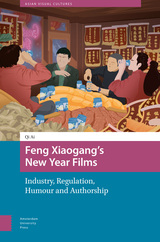 Feng Xiaogang’s New Year Films: Industry, Regulation, Humour and Authorship
Amsterdam University Press, 2025 This book offers not only an in-depth study of Feng Xiaogang as a cinematic auteur but also a comprehensive and informative discussion of the industrial transformation of mainstream Chinese cinema under party-state regulation from the 1990s to the 2010s. It argues that Feng is not simply a commercially and artistically successful auteur but also a strategist who manages to achieve such success by his ability to negotiate governmental and market expectations. The negotiation facilitates his New Year filmmaking and dynamically affects the textual form of the resulting works. Feng engages in this textual construction, through which he delivers his own interpretations of the Chinese film industry’s state-led commercialisation, cultural policy, film regulation, and even political campaigns, establishes his authorship and restores his creative authority. Through this book, readers will comprehend the edges and limitations of auteur studies in order to understand the current cultural landscape of the film industry.
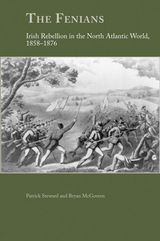 The Fenians: Irish Rebellion in the North Atlantic World, 1858–1876
Patrick Steward
University of Tennessee Press, 2013 Aspirations of social mobility and anti-Catholic discrimination were the lifeblood of subversive opposition to British rule in Ireland during the mid-nineteenth century. Refugees of the Great Famine who congregated in ethnic enclaves in North America and the United Kingdom supported the militant Fenian Brotherhood and its Dublin-based counterpart, the Irish Republican Brotherhood (IRB), in hopes of one day returning to an independent homeland. Despite lackluster leadership, the movement was briefly a credible security threat which impacted the history of nations on both sides of the Atlantic.
Inspired by the failed Young Ireland insurrection of 1848 and other nationalist movements on the European continent, the Fenian Brotherhood and the IRB (collectively known as the Fenians) surmised that insurrection was the only path to Irish freedom. By 1865, the Fenians had filled their ranks with battle-tested Irish expatriate veterans of the
Union and Confederate armies who were anxious to liberate Ireland. Lofty Fenian ambitions were ultimately compromised by several factors including United States government opposition and the resolution of volunteer Canadian militias who repelled multiple Fenian incursions into New Brunswick, Quebec, Ontario, and Manitoba. The Fenian legacy is thus multi-faceted. It was a mildly-threatening source of nationalist pride for discouraged Irish expatriates until the organization fulfilled its pledge to violently attack British soldiers and subjects. It also encouraged the confederation of Canadian provinces under the 1867 Dominion Act.
In this book, Patrick Steward and Bryan McGovern present the first holistic, multi-national study of the Fenian movement. While utilizing a vast array of previously untapped primary sources, the authors uncover the socio-economic roots of Irish nationalist behavior at the height of the Victorian Period. Concurrently, they trace the progression of Fenian ideals in the grassroots of Young Ireland to its de facto collapse in 1870s. In doing so, the authors change the perception of the Fenians from fanatics who aimlessly attempted to free their homeland to idealists who believed in their cause and fought with a physical and rhetorical force that was not nonsensical and hopeless as some previous accounts have suggested.
PATRICK STEWARD works in the Mayo Clinic Development Office in Rochester, Minnesota. He obtained a Ph.D. in Irish History at University of Missouri under the direction of Kerby Miller. Patrick additionally holds two degrees from Tufts University and he was a strategic intelligence analyst at the Drug Enforcement Administration in Washington, D.C. early in his professional career.
BRYAN MCGOVERN is an associate professor of history at Kennesaw State University in Kennesaw, Georgia. He is author of the widely praised 2009 book John Mitchel, Irish Nationalist, Southern Secessionist and has written various articles, chapters, and book reviews on Irish and Irish-American nationalism.
The Fenwick Letters: Reconstructing a Transnational Feminist Life, Volume I: 1797-1821
Eliza Fenwick
University of Delaware Press, 2026 The first of a two-volume edition of The Fenwick Letters covers 1797 to 1821, a period that marked the initial phase of Eliza Fenwick’s transnational odyssey, as she transformed from promising author to conservative schoolmistress and savvy businesswoman; from traveling in radical circles in London to establishing herself in colonial slave-dependent Bridgetown, Barbados; and from wife of radical journalist and author John Fenwick to single, working mother, trying to establish an independent life for herself and her children, Eliza Ann and Orlando. Eliza’s letters are consistently riveting, filled with sharply drawn portraits of the people, places, environment, politics, industries, and culture of each community she lived in.
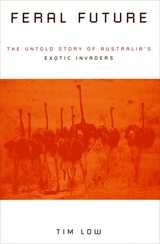 Feral Future: The Untold Story of Australia's Exotic Invaders
Tim Low
University of Chicago Press, 2002 A decade ago, Tim Low journeyed to the remote northernmost tip of Australia. Instead of the pristine rain forests he expected, he found jungles infested with Latin American carpet grass and feral cattle. That incident helped inspire Feral Future, a passionate account of the history and implications of invasive species in that island nation, with consequences for ecological communities around the globe.
Australia is far from alone in facing horrific ecological and economic damage from invading plants and animals, and in Low's capable hands, Australia's experiences serve as a wake-up call for all of us. He covers how invasive species like cane toads and pond apple got to Australia (often through misguided but intentional introductions) and what we can do to stop them. He also covers the many pests that Australia has exported to the world, including the paperbark tree (Melaleuca) that infests hundreds of thousands of acres in south Florida.
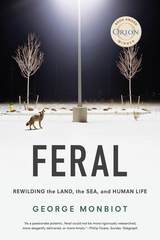 Feral: Rewilding the Land, the Sea, and Human Life
George Monbiot
University of Chicago Press, 2014 To be an environmentalist early in the twenty-first century is always to be defending, arguing, acknowledging the hurdles we face in our efforts to protect wild places and fight climate change. But let’s be honest: hedging has never inspired anyone.
So what if we stopped hedging? What if we grounded our efforts to solve environmental problems in hope instead, and let nature make our case for us? That’s what George Monbiot does in Feral, a lyrical, unabashedly romantic vision of how, by inviting nature back into our lives, we can simultaneously cure our “ecological boredom” and begin repairing centuries of environmental damage. Monbiot takes readers on an enchanting journey around the world to explore ecosystems that have been “rewilded”: freed from human intervention and allowed—in some cases for the first time in millennia—to resume their natural ecological processes. We share his awe, and wonder, as he kayaks among dolphins and seabirds off the coast of Wales and wanders the forests of Eastern Europe, where lynx and wolf packs are reclaiming their ancient hunting grounds. Through his eyes, we see environmental success—and begin to envision a future world where humans and nature are no longer separate and antagonistic, but are together part of a single, healing world.
Monbiot’s commitment is fierce, his passion infectious, his writing compelling. Readers willing to leave the confines of civilization and join him on his bewitching journey will emerge changed—and ready to change our world for the better.
 Ferdowsi’s Shāhnāma: Millennial Perspectives
Olga M. Davidson
Harvard University Press Ferdowsi's Shahnama: Millennial Perspectives celebrates the ongoing reception, over the last thousand years, of a masterpiece of classical Persian poetry. The epic of the Shahnama or Book of Kings glorifies the spectacular achievements of Iranian civilization from its mythologized beginnings all the way to the historical time of the Arab Conquest, when the notionally unbroken sequence of Iranian shahs came to an end. The poet Hakim Abu'l-Qasim, who composed this epic, was renamed Ferdowsi or "the man of Paradise" in recognition of his immortalizing artistic accomplishment. Even now, over a thousand years after his death in 1010 CE, the impact of Ferdowsi's epic poetry reverberates in the intellectual and artistic life of Persianate cultures all over the world. Ferdowsi's Shahnama: Millennial Perspectives undertakes a new look at the reception of Ferdowsi's poetry, especially in the twelfth, thirteenth, fourteenth, and fifteenth centuries CE. Such a reception, the contributors to this book argue, actively engages the visual as well as the verbal arts of Iranian civilization. The paintings and other art objects illustrating the Shahnama over the ages are as vitally relevant as the words of Ferdowsi's poetry.
 Ferment in Education: A Look Abroad
Edited by John J. Lane
University of Chicago Press, 1995 These eleven essays are a timely response by an international set of authorities to the deepening interest in research comparing educational systems from countries around the world.
The contributors chronicle the substantial growth and changing focus of comparative education, offer criticism of this type of research, and describe recent developments in education worldwide. Topics include a profile of the International Association for the Evaluation of Educational Achievement and a summary of the organization’s key findings; the impact of international agencies like the World Bank on the reconstruction of schooling in Africa; the effects of social upheaval on education in Russia; the expansion of secondary education and independent schools in the new Czech Republic; the removal of vestiges of Communism from civic education in Romania; new forms of teacher training in Israel and China; and reforms in the entrance examination process in Japan.
The contributors are scholars at universities in Australia, China, Europe, Israel, and the United States, a Romanian school inspector, and a research pyschologist from the United States.
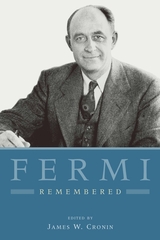 Fermi Remembered
Edited by James W. Cronin
University of Chicago Press, 2004 Nobel laureate and scientific luminary Enrico Fermi (1901-54) was a pioneering nuclear physicist whose contributions to the field were numerous, profound, and lasting. Best known for his involvement with the Manhattan Project and his work at Los Alamos that led to the first self-sustained nuclear reaction and ultimately to the production of electric power and plutonium for atomic weapons, Fermi's legacy continues to color the character of the sciences at the University of Chicago. During his tenure as professor of physics at the Institute for Nuclear Studies, Fermi attracted an extraordinary scientific faculty and many talented students—ten Nobel Prizes were awarded to faculty or students under his tutelage.
Born out of a symposium held to commemorate the hundredth anniversary of Fermi's birth, Fermi Remembered combines essays and newly commissioned reminiscences with private material from Fermi's research notebooks, correspondence, speech outlines, and teaching to document the profound and enduring significance of Fermi's life and labors. The volume also features extensives archival material—including correspondence between Fermi and biophysicist Leo Szilard and a letter from Harry Truman—with new introductions that provide context for both the history of physics and the academic tradition at the University of Chicago.
Edited by James W. Cronin, a University of Chicago physicist and Nobel laureate himself, Fermi Remembered is a tender tribute to one of the greatest scientists of the twentieth century.
Contributors:
Harold Agnew
Nina Byers
Owen Chamberlain
Geoffrey F. Chew
James W. Cronin
George W. Farwell
Jerome I. Friedman
Richard L. Garwin
Murray Gell-Mann
Maurice Glicksman
Marvin L. Goldberger
Uri Haber-Schaim
Roger Hildebrand
Tsung Dao Lee
Darragh Nagle
Jay Orear
Marshall N. Rosenbluth
Arthur Rosenfeld
Robert Schluter
Jack Steinberger
Valentine Telegdi
Al Wattenberg
Frank Wilczek
Lincoln Wolfenstein
Courtenay Wright
Chen Ning Yang
Gaurang Yodh
 Fermilab: Physics, the Frontier, and Megascience
Lillian Hoddeson, Adrienne W. Kolb, and Catherine Westfall
University of Chicago Press, 2008 Fermi National Accelerator Laboratory, located in the western suburbs of Chicago, has stood at the frontier of high-energy physics for forty years. Fermilab is the first history of this laboratory and of its powerful accelerators told from the point of view of the people who built and used them for scientific discovery.
Focusing on the first two decades of research at Fermilab, during the tenure of the laboratory’s charismatic first two directors, Robert R. Wilson and Leon M. Lederman, the book traces the rise of what they call “megascience,” the collaborative struggle to conduct large-scale international experiments in a climate of limited federal funding. In the midst of this new climate, Fermilab illuminates the growth of the modern research laboratory during the Cold War and captures the drama of human exploration at the cutting edge of science.
Fernan Mendez Pinto: Comedia Famosa en dos Partes
Antonio Enriquez Gomez
Harvard University Press, 1974 The editors of this volume, who have perfected the basic text and corrected printing and metrical defects, emphasize the play’s debt to the Portuguese adventurer Fernão Mendes Pinto whose prose epic (the Peregrinaçam) on the Portuguese presence in South, East, and Insular Asia inspired the Spanish work. Their introductory studies explain the play’s understandable yet false attribution to Lope de Vega and prove authorship by Antonio Enríquez Gómez, peninsular exile and ultimate victim of the Spanish Inquisition.
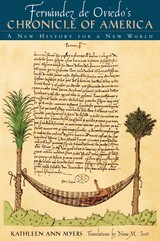 Fernández de Oviedo's Chronicle of America: A New History for a New World
By Kathleen Ann Myers
University of Texas Press, 2007 Gonzalo Fernández de Oviedo (1478-1557) wrote the first comprehensive history of Spanish America, the Historia general y natural de las Indias, a sprawling, constantly revised work in which Oviedo attempted nothing less than a complete account of the Spanish discovery, conquest, and colonization of the Americas from 1492 to 1547, along with descriptions of the land's flora, fauna, and indigenous peoples. His Historia, which grew to an astounding fifty volumes, includes numerous interviews with the Spanish and indigenous leaders who were literally making history, the first extensive field drawings of America rendered by a European, reports of exotic creatures, ethnographic descriptions of indigenous groups, and detailed reports about the conquest and colonization process. Fernández de Oviedo's Chronicle of America explores how, in writing his Historia, Oviedo created a new historiographical model that reflected the vastness of the Americas and Spain's enterprise there. Kathleen Myers uses a series of case studies—focusing on Oviedo's self-portraits, drawings of American phenomena, approaches to myth, process of revision, and depictions of Native Americans—to analyze Oviedo's narrative and rhetorical strategies and show how they relate to the politics, history, and discursive practices of his time. Accompanying the case studies are all of Oviedo's extant field drawings and a wide selection of his text in English translation. The first study to examine the entire Historia and its evolving rhetorical and historical context, this book confirms Oviedo's assertion that "the New World required a different kind of history" as it helps modern readers understand how the discovery of the Americas became a catalyst for European historiographical change.
Fernando: A Song by ABBA
Kay Dickinson
Duke University Press, 2025 Since its release in 1976, ABBA’s song “Fernando” has been loved by fans around the globe both for its sing-along chorus and its revolutionary spirit. In Fernando, Kay Dickinson takes readers from Sweden and Chile to Australia and Poland, tracing the complicated ways the song could express support with anticapitalist and Third World liberation struggles while remaining an unrepentant commodity. A song about freedom fighters was unlikely to become a pop mega-hit, yet as Dickinson demonstrates, ABBA’s lucrative, longstanding appeal rests on their ability to bridge contradictions within everyday life. Five decades later, “Fernando’s” rousing calls for freedom continue to resonate with gay liberation movements and other social struggles, demonstrating how a song can be both revolutionary and an envoy for global capital.
The Fernando Coronil Reader: The Struggle for Life Is the Matter
Fernando Coronil
Duke University Press, 2019 In The Fernando Coronil Reader Venezuelan anthropologist Fernando Coronil challenges us to rethink our approaches to key contemporary epistemological, political, and ethical questions. Consisting of work written between 1991 and 2011, this posthumously published collection includes Coronil's landmark essays “Beyond Occidentalism” and “The Future in Question” as well as two chapters from his unfinished book manuscript, "Crude Matters." Taken together, the essays highlight his deep concern with the Global South, Latin American state formation, theories of nature, empire, and postcolonialism, and anthrohistory as an intellectual and ethical approach. Presenting a cross section of Coronil's oeuvre, this volume cements his legacy as one of the most innovative critical social thinkers of his generation.
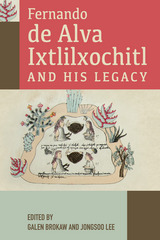 Fernando de Alva Ixtlilxochitl and His Legacy
Edited by Galen Brokaw and Jongsoo Lee
University of Arizona Press, 2016 Don Fernando de Alva Ixtlilxochitl is one of the most controversial and provocative Mexican chroniclers from the colonial period. A descendant of both the famous Prehispanic poet-king Nezahualcoyotl and Hernán Cortés’s ally Cortés Ixtlilxochitl, he penned chronicles that rewrote Prehispanic and colonial history. Traditionally known as a Europeanized historian of Tetzcoco, he wrote prolifically, producing documents covering various aspects of pre- and postconquest history, religion, and literature.
His seventeenth-century writings have had a lasting effect on the understanding of Mexican culture and history from the colonial period to the present. But because Alva Ixtlilxochitl frequently used Tetzcocan oral traditions and pictorial codices of his ancestors’ heroic achievements, scholars have long said that his writings exhibit a Tetzcocan bias that distorts representations and understandings of Prehispanic Mexican history and culture.
Fernando de Alva Ixtlilxochitl and His Legacy is a collection of essays providing deeper perspective on the life, work, and legacy of Alva Ixtlilxochitl. The contributors revise and broaden previous understandings of Alva Ixtlilxochitl’s racial and cultural identity, including his method of transcribing pictorial texts, his treatment of gender, and his influence on Mexican nationalism. Chapter authors coming from the fields of anthropology, history, linguistics, and literature offer valuable new perspectives on the complexities of Alva Ixtlilxochitl’s life and his contributions to the history and scholarship of Mexico.
Fernando Gallego and the Retablo of Ciudad Rodrigo
Robert MacLean Quinn
University of Arizona Press, 1961 History and critique in both Spanish and English of Hispano-Flemish painting based on most famous surviving altarpiece of the period. Retablo panels reproduced in 26 full-page duotones.
 Fernando Ortiz: Caribbean and Mediterranean Counterpoints
Edited by Stephan Palmié
HAU, 2023 Cross-regional scholarly dialogue inspired by the work of the pioneering Cuban scholar.
Fernando Ortiz (1881–1969) coined the term “transculturation” in 1940. This was an early case of theory from the South: concepts developed from an explicitly peripheral epistemological vantage point and launched as a corrective to European and North American theoretical formulations. What Ortiz proposed was a contrapuntal vision of complexly entangled processes that we, today, would conceptualize as cultural emergence.
Inspired by Ortiz, this volume engineers an unprecedented conversation between Mediterraneanists and Caribbeanists. It harnesses Ortiz’s mid-twentieth-century theoretical formulations to early twenty-first-century issues pertinent to both regions, including migration, territorial sovereignty, and cultural diversity. The contributors explore this perspective (arguably formed during Ortiz’s youth in late nineteenth-century Menorca) in a dialogue between scholars of the contemporary Caribbean and Mediterranean to enable novel analytics for both regions and to more broadly to probe the promises and limits of Ortiz’s contribution for contemporary anthropological research and theorizing.
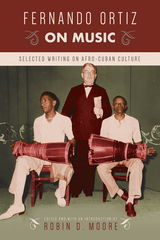 Fernando Ortiz on Music: Selected Writing on Afro-Cuban Culture
Robin D. Moore
Temple University Press, 2018 Fernando Ortiz (1881–1969) is recognized as one of the most influential Latin American authors of the twentieth century. Although he helped establish the field of Afro-diasporic studies, his writings are still relatively unknown to the English-speaking world. In Fernando Ortiz on Music, accomplished ethnomusicologist Robin Moore has collected and translated an essential selection of Ortiz’s publications. These essays on Afro-Cuban expressive culture, music and dance are now available for the first time in English. Ortiz’s writings are accompanied by an extended introduction that contextualizes the author’s life, intellectual influences, and collaborators as well as his fieldwork and interviews. Fernando Ortiz on Music also charts the writer’s changing views of black heritage through the years. This comprehensive anthology, which includes examples of his early scholarship as well as publications from the 1940s and ’50s, extends the life and legacy of this important and under-known scholar of Latin American and Caribbean music. Contributors include: David Garcia, Sarah Lahasky, Cary Peñate, Susan Thomas, and the editor
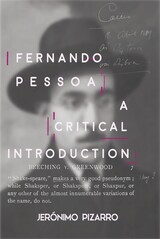 Fernando Pessoa: A Critical Introduction
Jerónimo Pizarro
Sussex Academic Press, 2022 A Critical Introduction proposes a new didactic and dynamic way of reading the great twentieth-century poet Fernando Pessoa (18881935). The aim is to present a holistic vision of this complex poet, promoting his literary geniality in order to better understand his orthonymic-heteronymic poetry. A guiding motif is Pessoa's own "Be as plural as the universe." In leading the reader through the poet's published literary work Jernimo Pizarro allows an intimate perspective, alongside an academic one, to better understand the workings of Pessoa's mind and life. Discussion centres on the dilemmas an editor faces when editing posthumously. A prime question revolves around the genesis of Pessoa's heteronyms and orthonyms. Understanding is revealed by a critical perspective on the unity that exists in all of Pessoa's literary work. Interpretations of the poems; explanation of the profundity of The Book of Disquiet; and his isms of Paulism, Caeirism, Intersectionism and Sensationism, are discussed and analysed. The issue of Pessoa's astrological predictions his birth year and the effects of this event on Portuguese national history is debated. A chapter is devoted to the effect that translating Omar Khayyam's Rubiyt had on the poet. The work contains eleven texts written by Pessoa in English (including an autobiographical note from 1935), a substantive dual language bibliography, and is highly illustrated with facsimiles of the poet's own written material. A Critical Introduction is essential reading for all scholars and students of Pessoa's literary output and life circumstances. The work has been written to appeal to cultural studies (arts and aesthetics) enthusiasts in general at both undergraduate and postgraduate level, but given the engagement of new critical material it also provides a structured resource for future research.
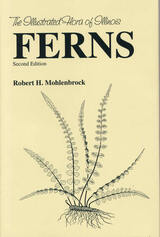 Ferns
Robert H. Mohlenbrock
Southern Illinois University Press, 1999 Perhaps no other group of plants attracts more interest among both professional and amateur botanists than ferns. As early as 1846, when one of the first lists of Illinois plants was published, sixteen species of ferns were already known in the state. The longtime interest of a great many people makes the distribution of ferns better known than that of any other group of plants in Illinois. This detailed account of ferns and fern-allies was first published in 1967 as the first volume in the series The Illustrated Flora of Illinois. Eminent botanist Robert H. Mohlenbrock has now revised Ferns to include twenty-five additional taxa of ferns that have since been discovered in Illinois. In addition, numerous nomenclatural changes have occurred for plants already known in the state. The introductory information of Ferns includes discussions of the morphology and life history of the ferns and fern-allies, the taxonomic history of the group in Illinois, and the habitats where they can be found. The semitechnical keys and descriptions, familiar to the professional botanist, have been simplified for the novice and are accompanied by a glossary and a profuse use of illustrations. A new key has been included for the additional ferns. Two general keys enable the reader to identify the order and the genus of the fern or fern-ally in question. One of these is designed for use with specimens that have sporangia; the other is for use with sterile specimens. The keys are composed of a hierarchy of characteristics for determining the order, family, and genus of any given specimen. Once a genus is ascertained, the reader can apply its key to more than one species of the same genus. Each species has its own description, statement of habitat and range, Illinois distribution, map, discussion, synonymy, and full-page line illustration showing its diagnostic characteristics.
 The Ferns and Fern Allies of Minnesota
Carl Otto Rosendahl and Frederic K. Butters
University of Minnesota Press, 1954 The Ferns and Fern Allies of Minnesota was first published in 1954. Minnesota Archive Editions uses digital technology to make long-unavailable books once again accessible, and are published unaltered from the original University of Minnesota Press editions. Ferns are the most abundant plants in many areas of Minnesota, and the beauty and variety of their leaf patterns make them a rewarding form of plant life for study. This handbook identifies and describes the 92 different kinds of ferns and fern allies that are native to the state. In addition, ten other ferns that grow in adjacent states and may be expected to be found in Minnesota are described. An introductory section tells how to collect and preserve specimens. Advice is given on how to transplant ferns to a garden and which species are best for different kinds of plantings or locations. An illustrated glossary consisting of four plates graphically defines the technical terms used in this book. Distribution maps and figures are placed closed to the text to which they pertain. Many of the plates are full sized so that a specimen may be placed on the page for identification.
 Ferocious Reality: Documentary according to Werner Herzog
Eric Ames
University of Minnesota Press, 2012 Over the course of his career Werner Herzog, known for such visionary masterpieces as Aguirre: The Wrath of God (1972) and The Enigma of Kaspar Hauser (1974), has directed almost sixty films, roughly half of which are documentaries. And yet, in a statement delivered during a public appearance in 1999, the filmmaker declared: “There are deeper strata of truth in cinema, and there is such a thing as poetic, ecstatic truth. It is mysterious and elusive, and can be reached only through fabrication and imagination and stylization.” Ferocious Reality is the first book to ask how this conviction, so hostile to the traditional tenets of documentary, can inform the work of one of the world’s most provocative documentarians. Herzog, whose Cave of Forgotten Dreams was perhaps the most celebrated documentary of 2010, may be the most influential filmmaker missing from major studies and histories of documentary. Examining such notable films as Lessons of Darkness (1992) and Grizzly Man (2005), Eric Ames shows how Herzog dismisses documentary as a mode of filmmaking in order to creatively intervene and participate in it. In close, contextualized analysis of more than twenty-five films spanning Herzog’s career, Ames makes a case for exploring documentary films in terms of performance and explains what it means to do so. Thus his book expands the field of cinema studies even as it offers an invaluable new perspective on a little studied but integral part of Werner Herzog’s extraordinary oeuvre.
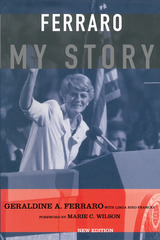 Ferraro: My Story
Geraldine Ferraro with Linda Bird Francke and with a foreword by Marie Wilson
Northwestern University Press, 2004 In this memoir, Geraldine A. Ferraro reflects on her experience as the first and only woman nominated by a major party to run on the presidential ticket. This book reveals the process that led to her nomination as the 1984 Democratic Vice-Presidential candidate and gives a revealing behind-the-scenes look at campaign politics, especially the ruthless criticism directed at her and her family. Ferraro brings to life the dynamics of the women in Congress and how the different life experiences that they bring to the table affect the policy making process. She also gives a real understanding of the pioneering women, including Bella Abzug, Gloria Steinem, Millie Jeffrey and many others who worked together to make sure that a women was on the Democratic ticket in 1984.
Ferraro's run for vice-president was an important moment in American history. The time is right for telling a new generation this story of women's collective political power and the difference women office holders can and do make to public policy.
Ferris Wheels: An Illustrated History
Norman Anderson
University of Wisconsin Press, 1993 Norman Anderson has written a gripping story of one of the engineering marvels of both the nineteenth and the twentieth century, the ferris wheel. The idea of this contraption may be as old as the water wheel, and written descriptions and drawings of pleasure wheels go back at least four centuries. There have been dozens of experiments with design and construction—early portable wheels by Strobel, the Condermans, Sullivan and others; one-of-a-kind wheels like Schnitzler’s Asbury Park wheel with a tower and Stubb’s water-turned wheel at Electric Park in Waterloo, Iowa; giant wheels in London, Blackpool, Vienna, Paris and recently in Japan.
 Ferrites at Microwave Frequencies
A.J. Baden Fuller
The Institution of Engineering and Technology, 1987 Between 1950 and 1965, there was a spate of intense activity to investigate the theory and application of ferrite materials at microwave frequencies, and in the early 1960s a number of textbooks on the microwave applications of ferrites were published, but nothing comprehensive since. Now this book has been written to consolidate all the investigations of ferrites for microwave applications, to look back at earlier publications from the viewpoint of a mature technology, and to bring the story up to date. This book attempts to give all the structures and applications using ferrites at microwave frequencies that havebeen investigated or contemplated, using the engineer's rather than the physicist's approach. It starts with a full mathematical treatment of the interaction of an electromagnetic wave with a gyromagnetic ferrite material for simple boundary conditions. These results are then extended to give a field descriptive approach to describe the mode of operation of all the different microwave devices.
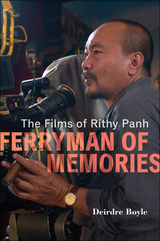 Ferryman of Memories: The Films of Rithy Panh
Deirdre Boyle
Rutgers University Press, 2023 Ferryman of Memories: The Films of Rithy Panh is an unconventional book about an unconventional filmmaker. Rithy Panh survived the Cambodian genocide and found refuge in France where he discovered in film a language that allowed him to tell what happened to the two million souls who suffered hunger, overwork, disease, and death at the hands of the Khmer Rouge. His innovative cinema is made with people, not about them—even those guilty of crimes against humanity. Whether he is directing Isabelle Huppert in The Sea Wall, following laborers digging trenches, or interrogating the infamous director of S-21 prison, aesthetics and ethics inform all he does. With remarkable access to the director and his work, Deirdre Boyle introduces readers to Panh’s groundbreaking approach to perpetrator cinema and dazzling critique of colonialism, globalization, and the refugee crisis. Ferryman of Memories reveals the art of one of the masters of world cinema today, focusing on nineteen of his award-winning films, including Rice People, The Land of Wandering Souls, S-21: The Khmer Rouge Killing Machine, and The Missing Picture.
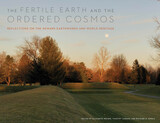 The Fertile Earth and the Ordered Cosmos: Reflections on the Newark Earthworks and World Heritage
Edited by M. Elizabeth Weiser, Timothy R. W. Jordan, and Richard D. Shiels
Ohio State University Press, 2023 Rising in quiet grandeur from the earth in an astoundingly engineered arrangement that ancient peoples mapped to the movements of the moon, Ohio’s Newark Earthworks form the largest geometric earthen complex ever known. In the two thousand years of their existence, they have served as gathering place, ceremonial site, fairground, army encampment, golf course, and park. And, at long last, they (along with neighboring sites) were named a UNESCO World Heritage Site in 2023—a designation that recognizes their international importance as a direct link to the ancient past as well as their continuing cultural and archaeological significance.
The lush photos and wide-ranging essays of The Fertile Earth and the Ordered Cosmos honor this significance, not only to the global community but to local individuals and scholars who have developed intimate connections to the Earthworks. In sharing their experiences with this ancient site, public historians, archaeologists, physicists, architects, and others—including local and Indigenous voices—continue the work of nearly two hundred years of citizen efforts to protect and make accessible the Newark Earthworks after centuries of stewardship by Indigenous people. The resulting volume serves as a rich primer on the site for those unfamiliar with its history and a beautifully produced tribute for those who are already acquainted with its wonders.
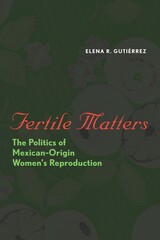 Fertile Matters: The Politics of Mexican-Origin Women's Reproduction
By Elena R. Gutiérrez
University of Texas Press, 2008 While the stereotype of the persistently pregnant Mexican-origin woman is longstanding, in the past fifteen years her reproduction has been targeted as a major social problem for the United States. Due to fear-fueled news reports and public perceptions about the changing composition of the nation's racial and ethnic makeup—the so-called Latinization of America—the reproduction of Mexican immigrant women has become a central theme in contemporary U. S. politics since the early 1990s. In this exploration, Elena R. Gutiérrez considers these public stereotypes of Mexican American and Mexican immigrant women as "hyper-fertile baby machines" who "breed like rabbits." She draws on social constructionist perspectives to examine the historical and sociopolitical evolution of these racial ideologies, and the related beliefs that Mexican-origin families are unduly large and that Mexican American and Mexican immigrant women do not use birth control. Using the coercive sterilization of Mexican-origin women in Los Angeles as a case study, Gutiérrez opens a dialogue on the racial politics of reproduction, and how they have developed for women of Mexican origin in the United States. She illustrates how the ways we talk and think about reproduction are part of a system of racial domination that shapes social policy and affects individual women's lives.
Fertility and Jewish Law: Feminist Perspectives on Orthodox Responsa Literature
Ronit Irshai
Brandeis University Press, 2012 This book presents, from the perspective of feminist jurisprudence and feminist and liberal bioethics, a complete study of Jewish law (halakhah) on contemporary reproductive issues such as birth control, abortion, and assisted fertility. Irshai examines these issues to probe gender-based values that underlie the interpretations and determinations reached by modern practitioners of halakhah. Her primary goal is to tell, through common halakhic tools, a different halakhic story, one that takes account of the female narrative and its missing perspective.
Fertility and Other Stories
Vsevolod Ivanov
Northwestern University Press, 1998 Vsevolod Ivanov's personal experiences in Siberia and Central Asia during the Revolution and Civil War, set against a childhood and youth wandering that vast expanse, infuse his writing. Combining traditional elements with the fantastic and the surreal, Ivanov's stories address not only the themes of the Revolution--the dehumanizing effects of famine; the ferment, energy, and uncertainty of the tempestuous times—but also the quotidian: the quiet world of man and nature, and the elemental bond that tied peasants to their native land. Fertility and Other Stories makes available for the first time in English some of the best stories of one of the most talented twentieth-century Russian writers.
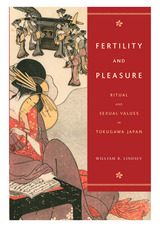 Fertility and Pleasure: Ritual and Sexual Values in Tokugawa Japan
William R. Lindsey
University of Hawaii Press, 2007 As their ubiquitous presence in Tokugawa artwork and literature suggests, images of bourgeois wives and courtesans took on iconic status as representations of two opposing sets of female values. Their differences, both real and idealized, indicate the full range of female roles and sexual values affirmed by Tokugawa society, with Buddhist celibacy on the one end and the relatively free sexual associations of the urban and rural lower classes on the other.
The roles of courtesan and bourgeois housewife were each tied to a set of value-based behaviors, the primary institution to which a woman belonged, and rituals that sought to model a woman’s comportment in her interactions with men and figures of authority. For housewives, it was fertility values, promulgated by lifestyle guides and moral texts, which embraced the ideals of female obedience, loyalty to the husband’s household, and sexual activity aimed at producing an heir. Pleasure values, by contrast, flourished in the prostitution quarters and embraced playful relations and nonreproductive sexual activity designed to increase the bordello’s bottom line. What William Lindsey reveals in this well-researched study is that, although the values that idealized the role of wife and courtesan were highly disparate, the rituals, symbols, and popular practices both engaged in exhibited a degree of similitude and parallelism. Fertility and Pleasure examines the rituals available to young women in the household and pleasure quarters that could be employed to affirm, transcend, or resist these sets of sexual values. In doing so it affords new views of Tokugawa society and Japanese religion.
Highly original in its theoretical approach and its juxtaposition of texts, Fertility and Pleasure constitutes an important addition to the fields of Japanese religion and history and the study of gender and sexuality in other societies and cultures.
Fertility Change in Contemporary Japan
Robert W. Hodge and Naohiro Ogawa
University of Chicago Press, 1992 The authors examine the striking decline in Japan's birthrate in light of the rapid urbanization, industrialization, and socioeconomic development experienced by the nation since World War II.
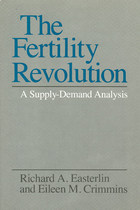 The Fertility Revolution: A Supply-Demand Analysis
Richard A. Easterlin and Eileen M. Crimmins
University of Chicago Press, 1985 For most of human history a "natural fertility" regime has prevailed throughout the world: there has been almost no conscious limitation of family size within marriage, and women have spent their reproductive lives tied to the "wheel of childbearing." Only recently in developed countries has fertility been brought under conscious control by individual couples and childbearing fallen to an average of two births per woman. The explanation of this "fertility revolution" is the main concern of this book.
Richard A. Easterlin and Eileen M. Crimmins present and test a fertility theory that has gained increasing attention over the last decade, a "supply-demand theory" that integrates economic and sociological approaches to fertility determination. The results of the tests, which draw on data from four developing countries—Colombia, India, Sri Lanka, and Taiwan—are highly consistent, though a number of the conclusions are likely to arouse controversy. For example, couples' motivation for fertility control appears to be the prime mover in the fertility revolution, rather than access to family planning services or unfavorable attitudes toward such services.
The interdisciplinary approach and nontechnical exposition of this study will attract a wide readership among economists, sociologists, demographers, anthropologists, statisticians, biologists, and others.
Festal Letters 1-12
St. Cyril of Alexandria
Catholic University of America Press, 2013 No description available
Festal Letters 13-30
St. Cyril of Alexandria
Catholic University of America Press, 2013 Twenty-nine in all, these letters cover all but three of Cyril's years as a bishop. The first twelve were published in 2009 (Fathers of the Church 118). The present volume completes the set. Festal letters were used in Alexandria primarily to announce the beginning of Lent and the date of Easter. They also served a catechetical purpose, however, allowing the Patriarch an annual opportunity to write pastorally not just about issues facing the entire see, but also about the theological issues of the day.
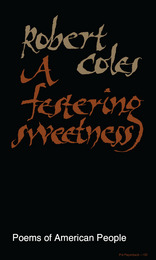 A Festering Sweetness: Poems of American People
Robert Coles
University of Pittsburgh Press, 1978 A Festering Sweetness is a new approach for the renowned child psychiatrist and writer Robert Coles. His works have always portrayed children in their own social fabric and language, but in this book he has arranged the words and intent of the children and their parents into verse forms. These skillfully constructed poems capture the hopes, fears, assumptions, and expectations of these people.
The sense of life and suffering among the poor of the South, the northern ghettos, and the West conveyed in A Festering Sweetness could not be expressed in any form other than poetry. And only Robery Coles, who has lived and worked among these people, could have revealed with such sympathy and insight the minds and emotions of the deprived in America. He is a superb stylist, with an extraordinary sensitivity of ear and eye, as well as a fine and humane psychiatrist—indeed, a man in the doctor-writer tradition of William Carlos Williams.
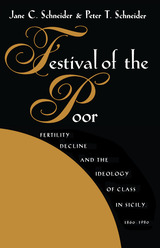 Festival of the Poor: Fertility Decline and the Ideology of Class
Jane C. Schneider
University of Arizona Press, 1996 The historical decline of fertility in Europe has occupied a central place in social history and demography over the past quarter-century. Most scholars credit Europeans with modulating sexual behavior, through either abstinence or the practice of coitus interruptus, as a rational choice made in the interest of personal economic comfort; yet peasant and working classes have typically lagged behind in birth control and have given rise to the adage that "sexual embrace is the festival of the poor." Scholarly analyses of "lag" often reinforce this stigmatizing view. Now this subject is given a fresh look through a case study in Sicily, one of the last outposts of Western Europe's demographic transition.
By examining population changes in a single community between 1860 and 1980, the authors offer an extended review and critique of existing models of fertility decline in Europe, proposing a new interpretation that emphasizes historical context and class relations. They show how the spread of capitalism in Sicily induced an unprecedented rate of population growth, with boom-and-bust cycles creating the class experiences in which "reputational networks" came to redefine family life; how Sicilians began to control their fertility in response to class-mediated ideas about gender relations and respectable family size; and how the town's gentry, artisan, and peasant classes adopted family planning methods at different times in response to different pressures.
Jane and Peter Schneider's anthropologically oriented political-economy perspective challenges the position of Western Europe as a model for fertility decline on which every other case should converge, looking instead at the diversity of cultural ideals and practices--such as those found in Sicily--that influence the spread and form of birth control. Combining anthropological, oral historical, and archival methods in new and insightful ways, the authors' synthesis of a particular case study with a broad historical and theoretical discussion will play a major role in the ongoing debates over the history of European fertility decline and point the way toward integrating the analysis of demographic upheaval with the study of class formation and ideology.
A Festival of Violence: An Analysis of Southern Lynchings, 1882-1930
Stewart Tolnay and E.M. Beck
University of Illinois Press, 1995 This finely detailed statistical study of lynching in ten southern states shows that economic and status concerns were at the heart of that violent
practice. Stewart Tolnay and E. M. Beck empirically test competing explanations of the causes of lynching, using U.S. Census and historical voting data and a newly constructed inventory of southern lynch victims. Among their surprising findings: lynching responded to fluctuations in the price of cotton, decreasing in frequency when prices rose and increasing when they fell.
|
|
